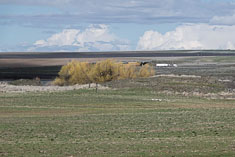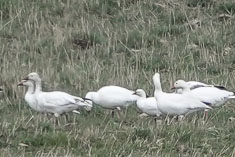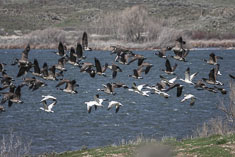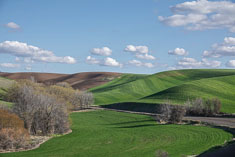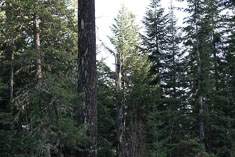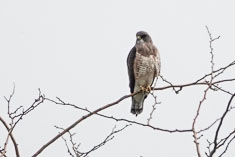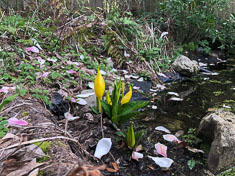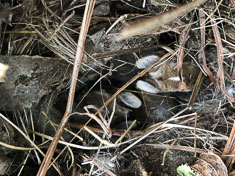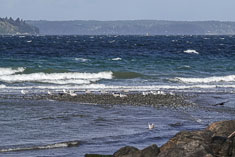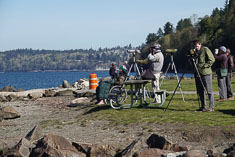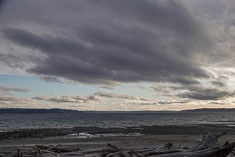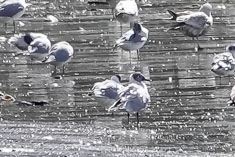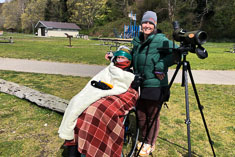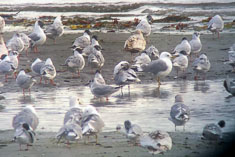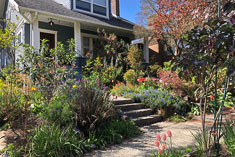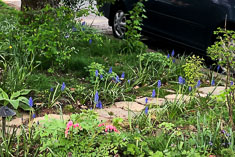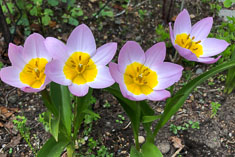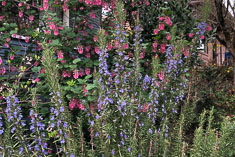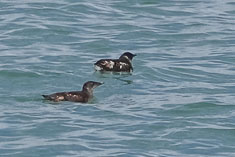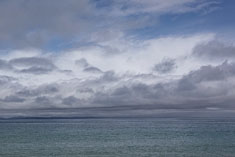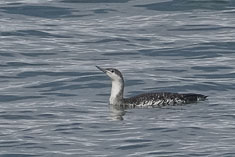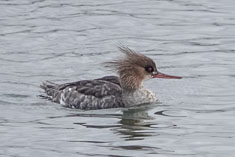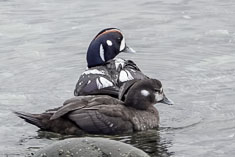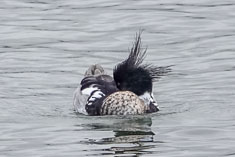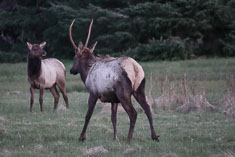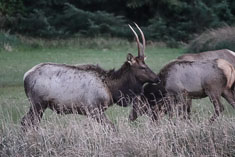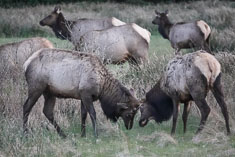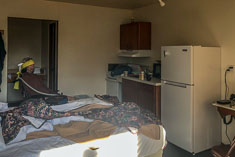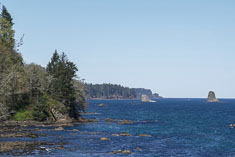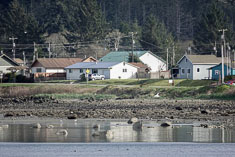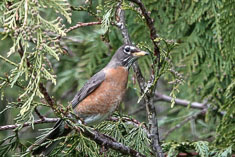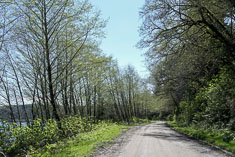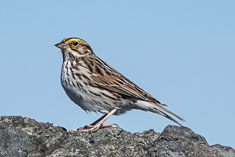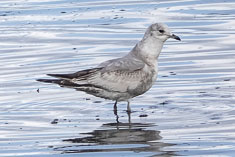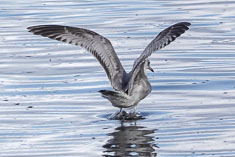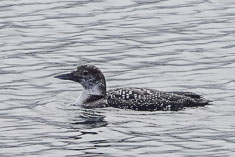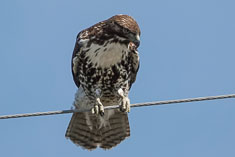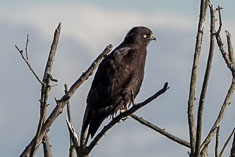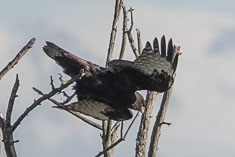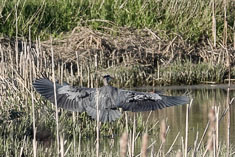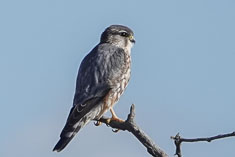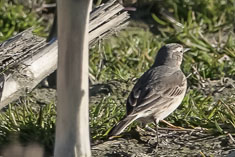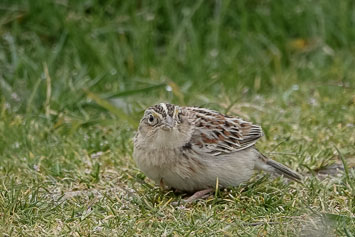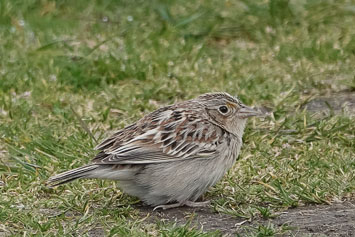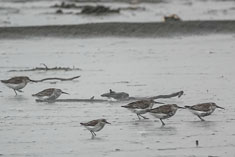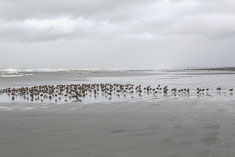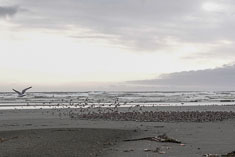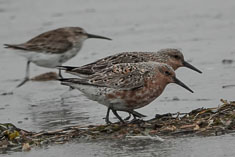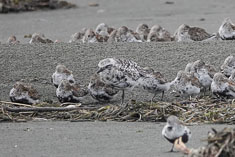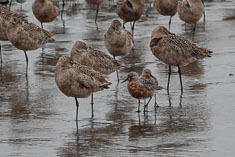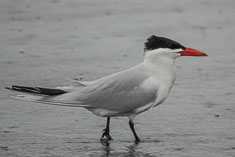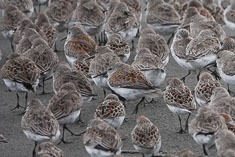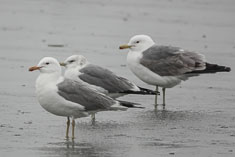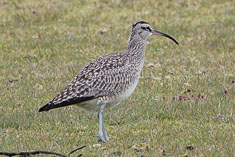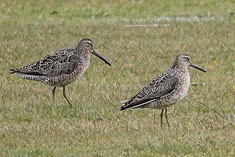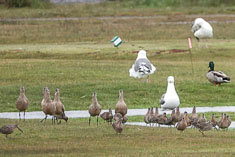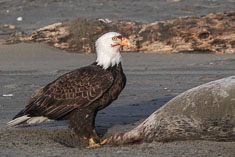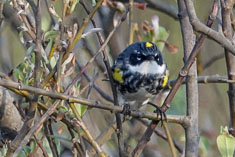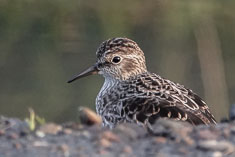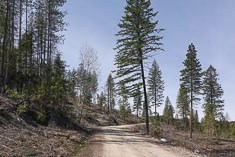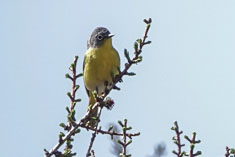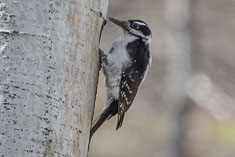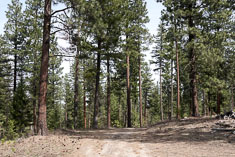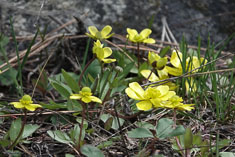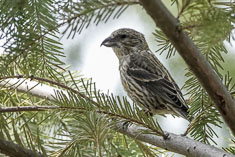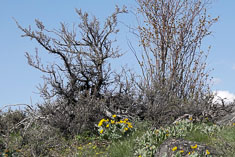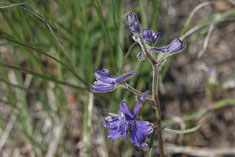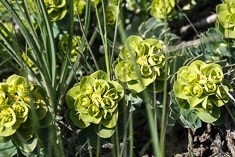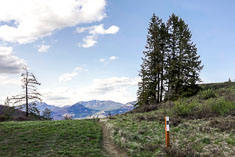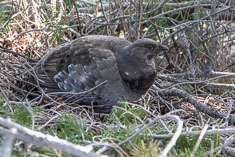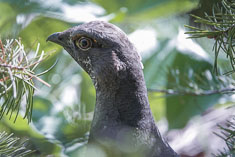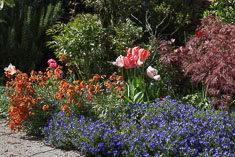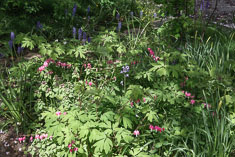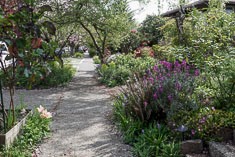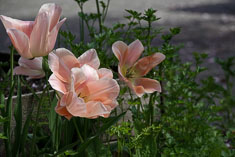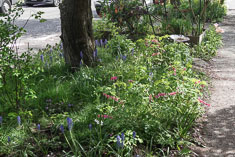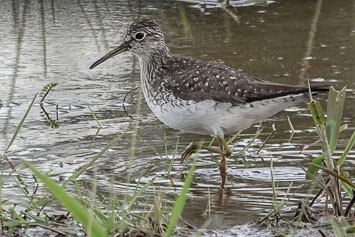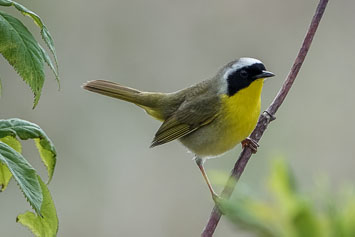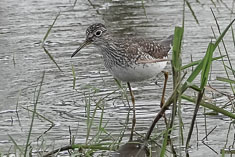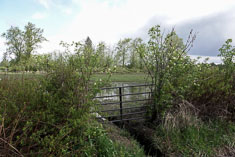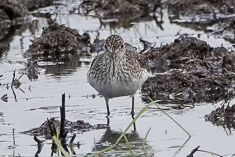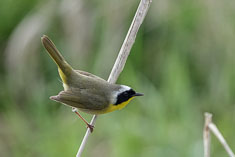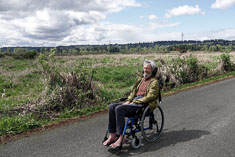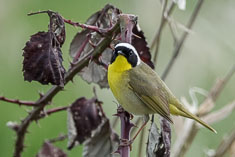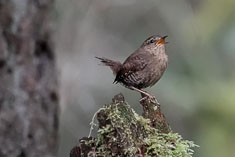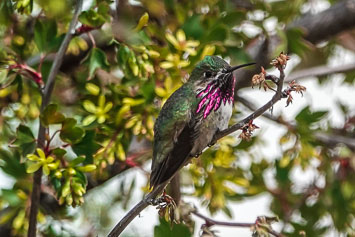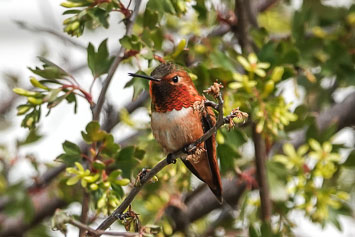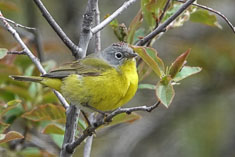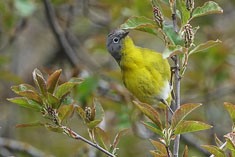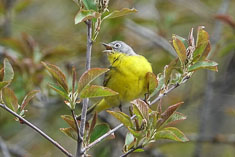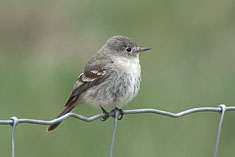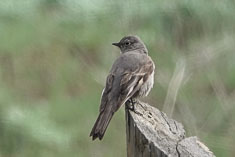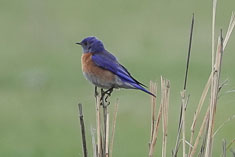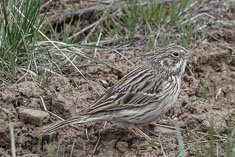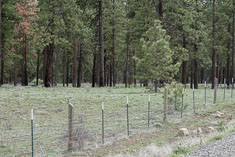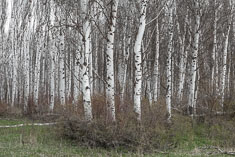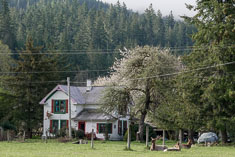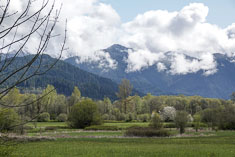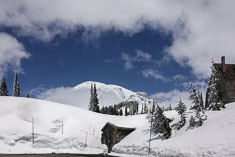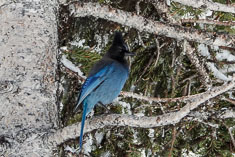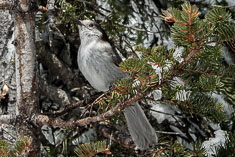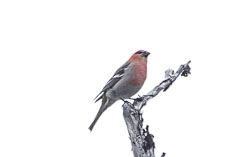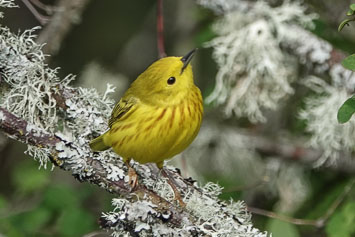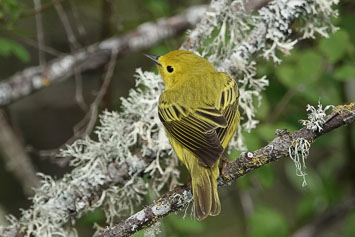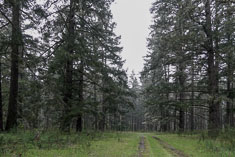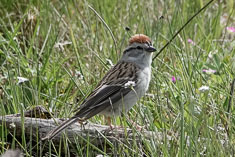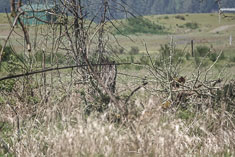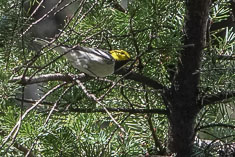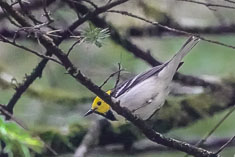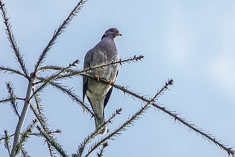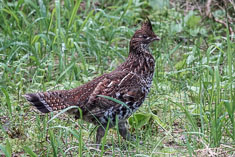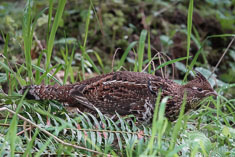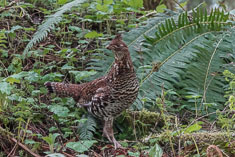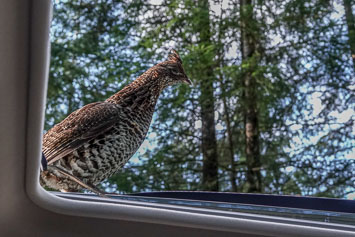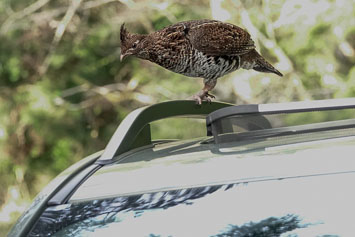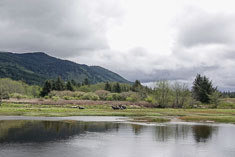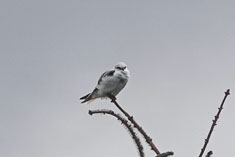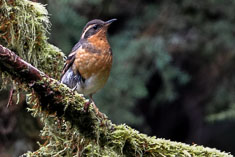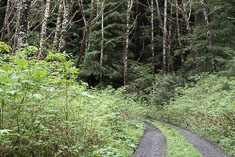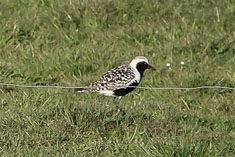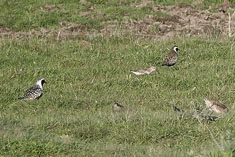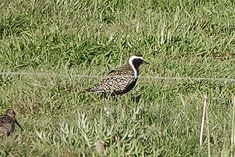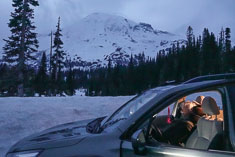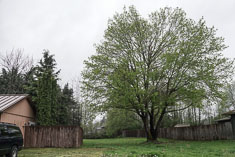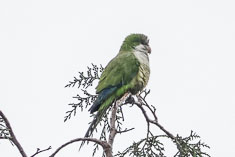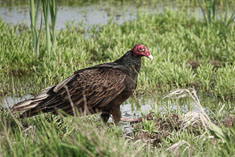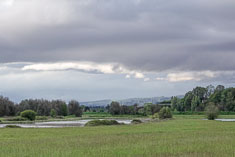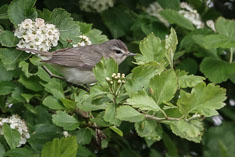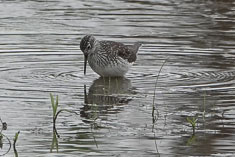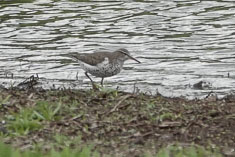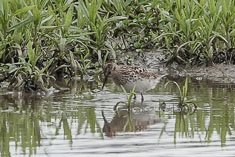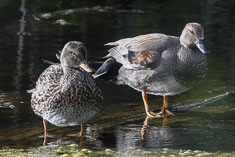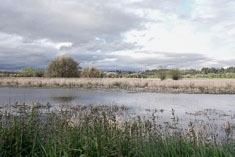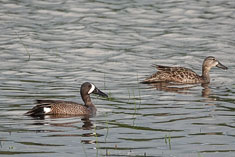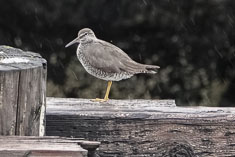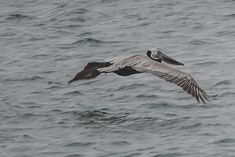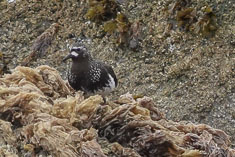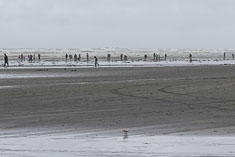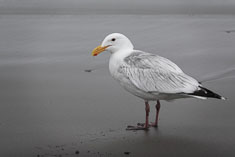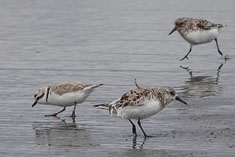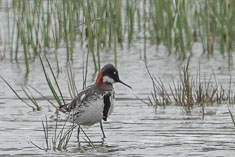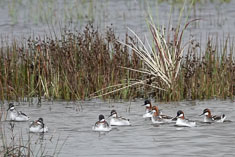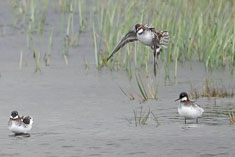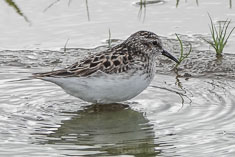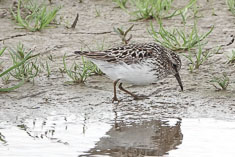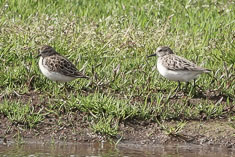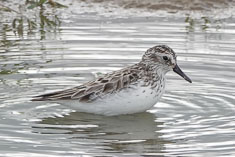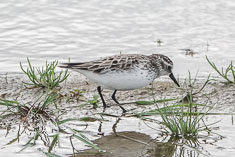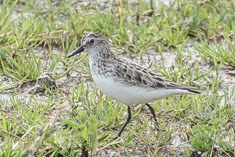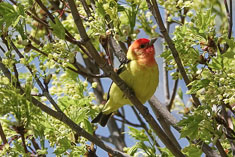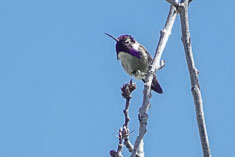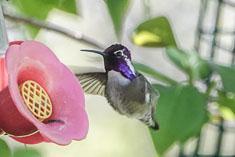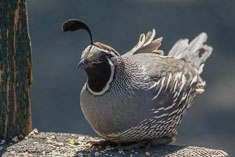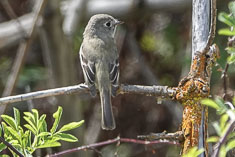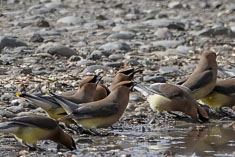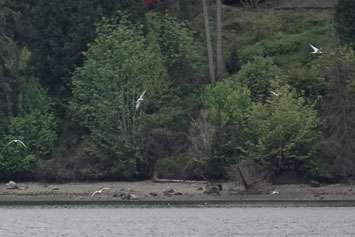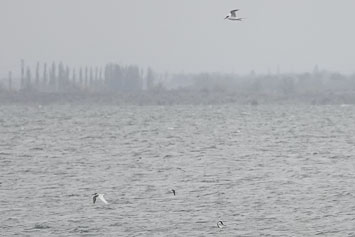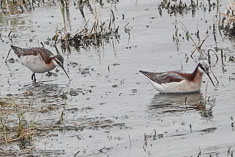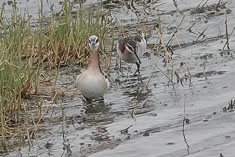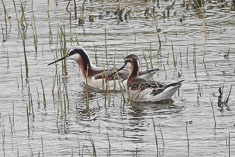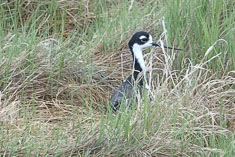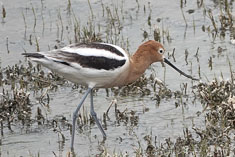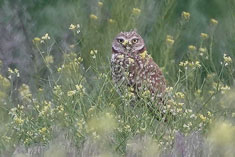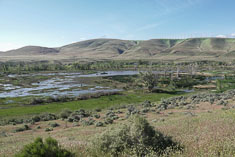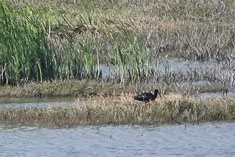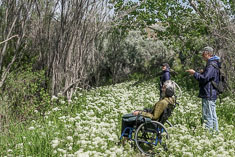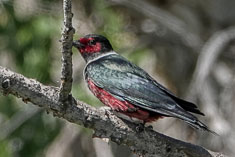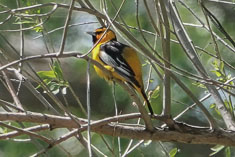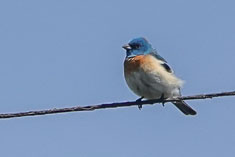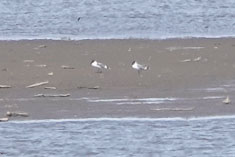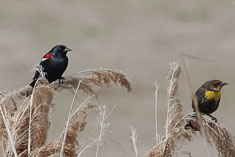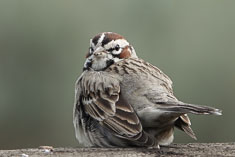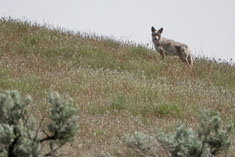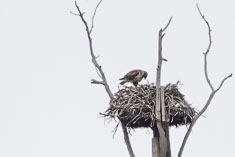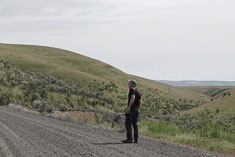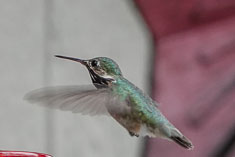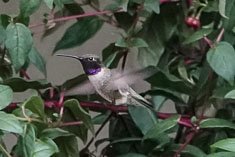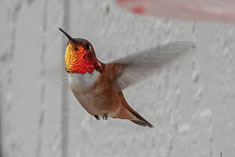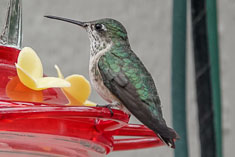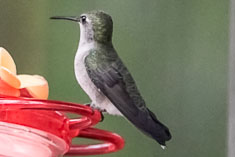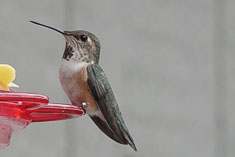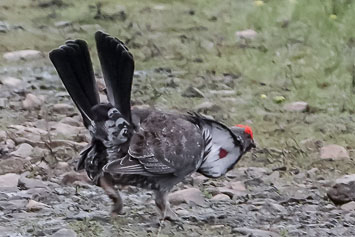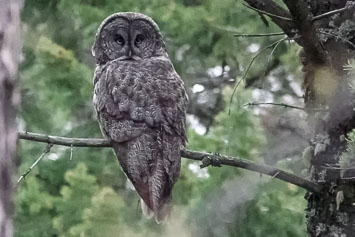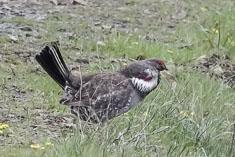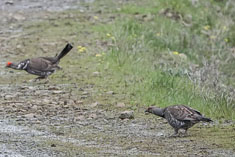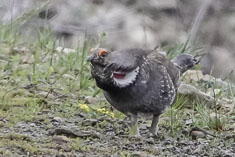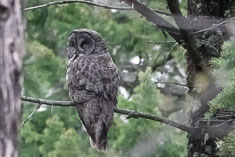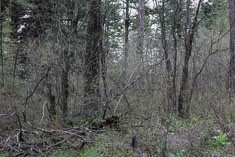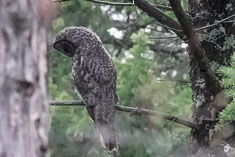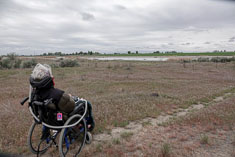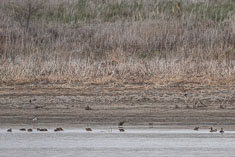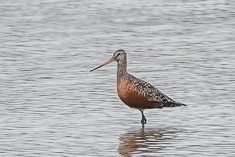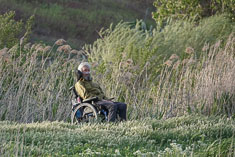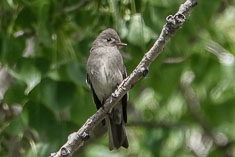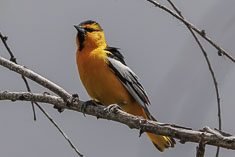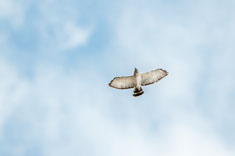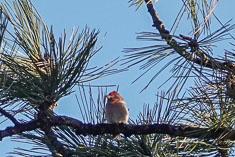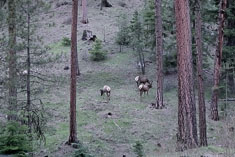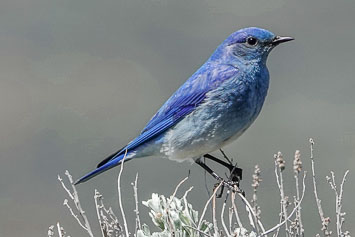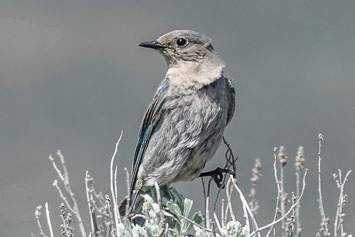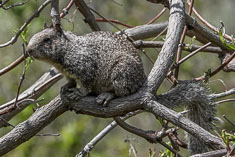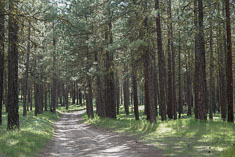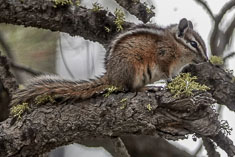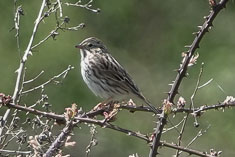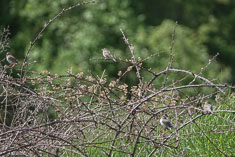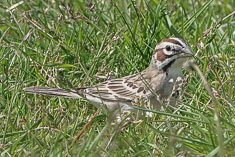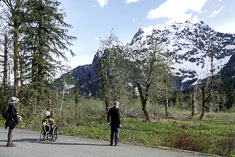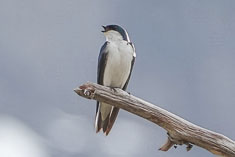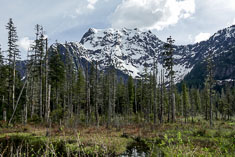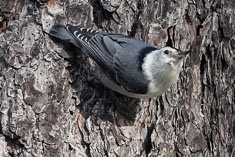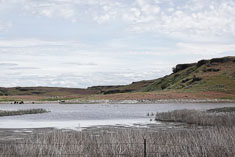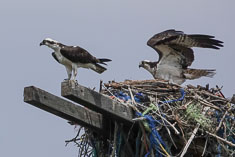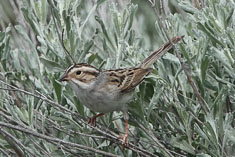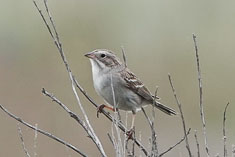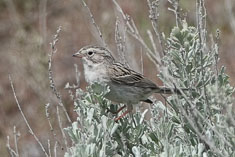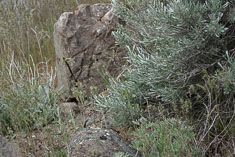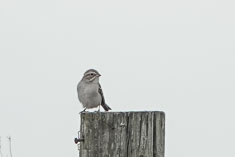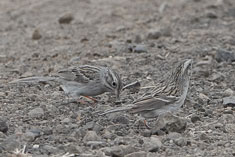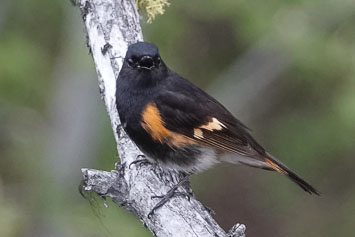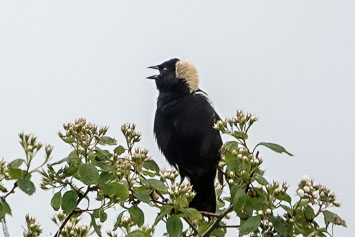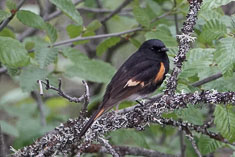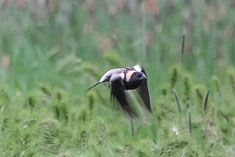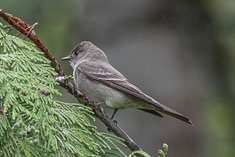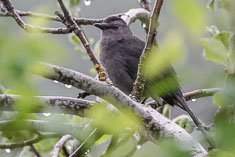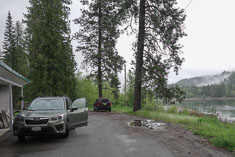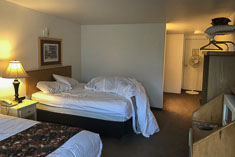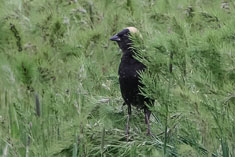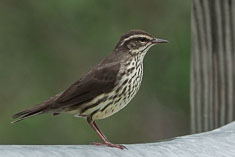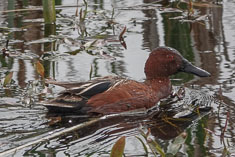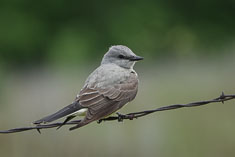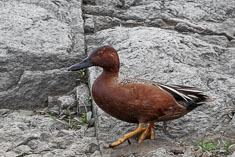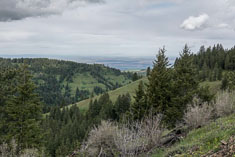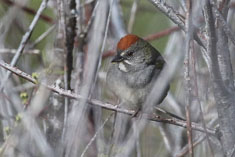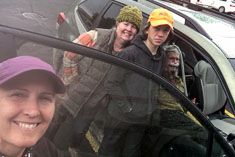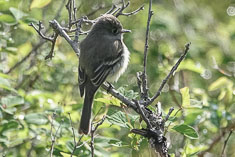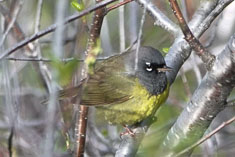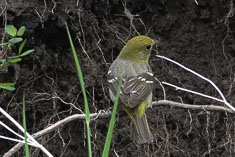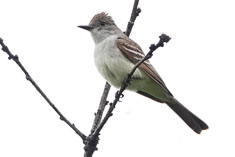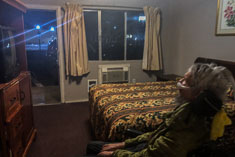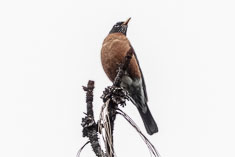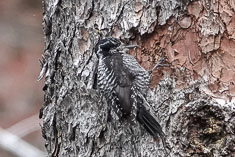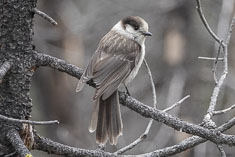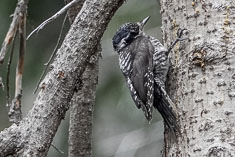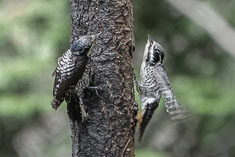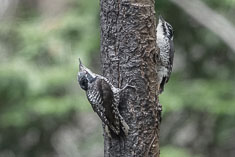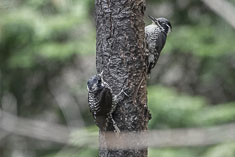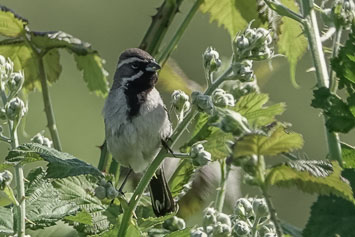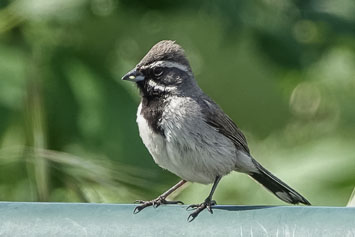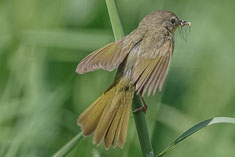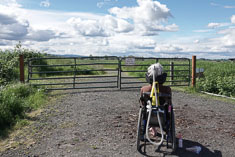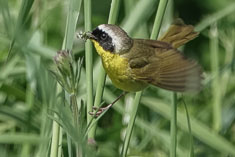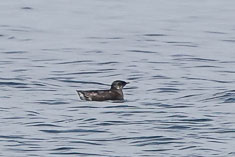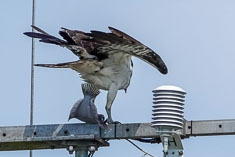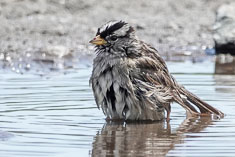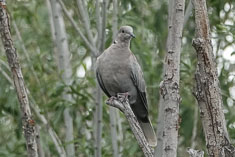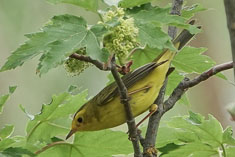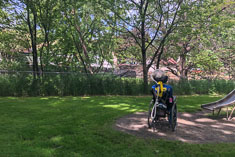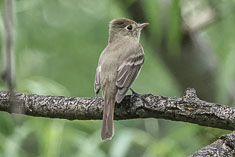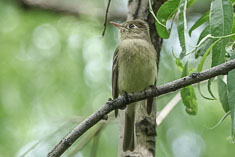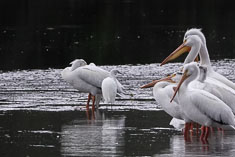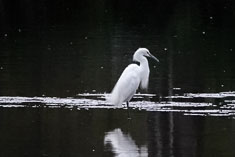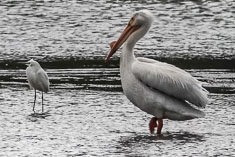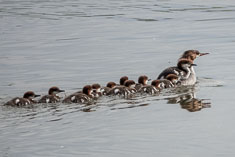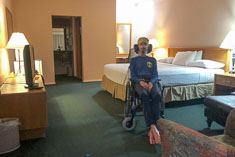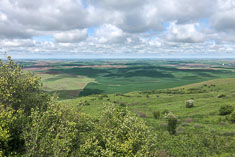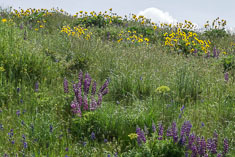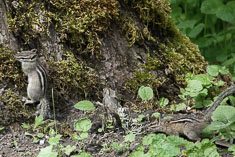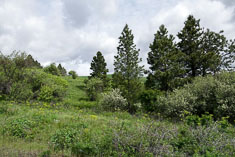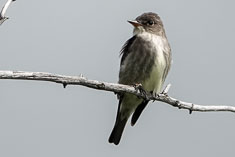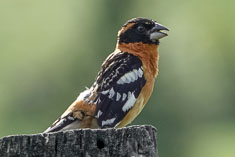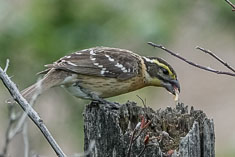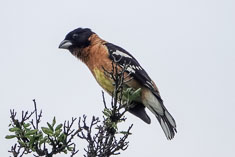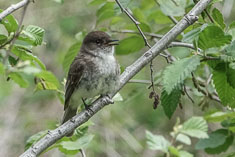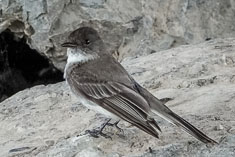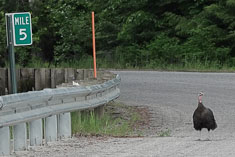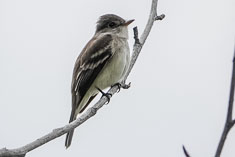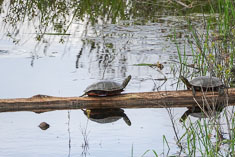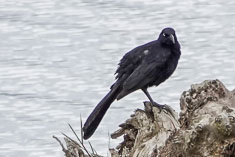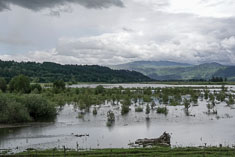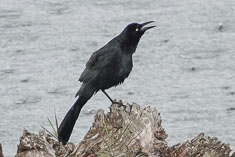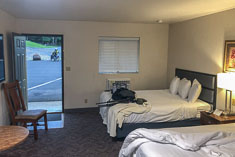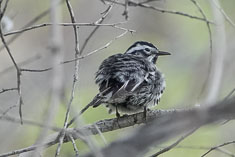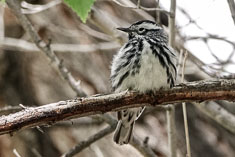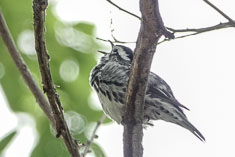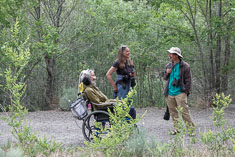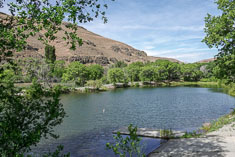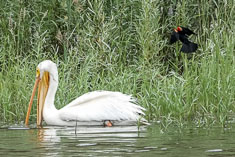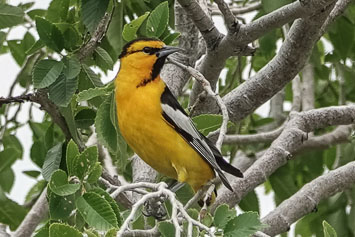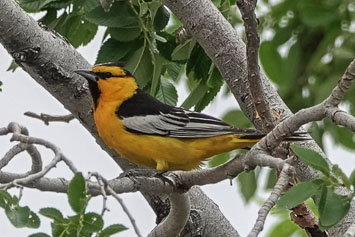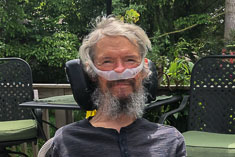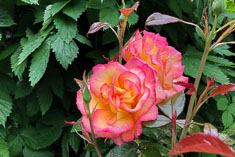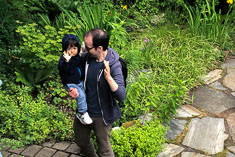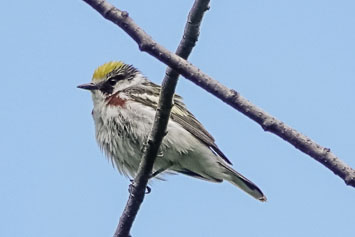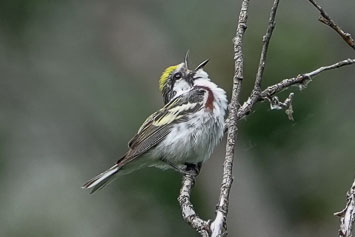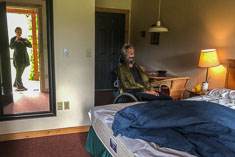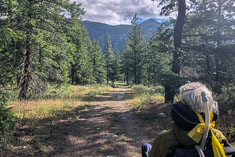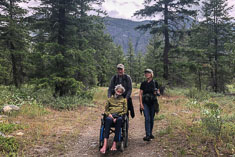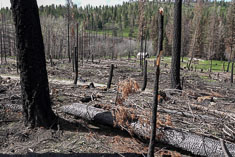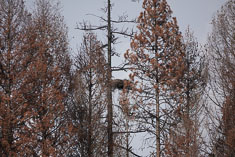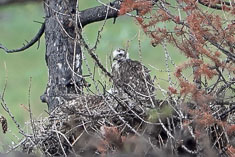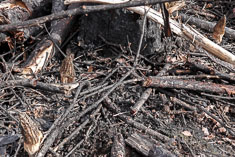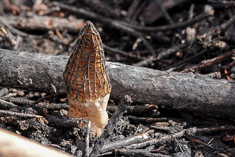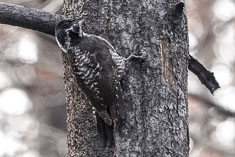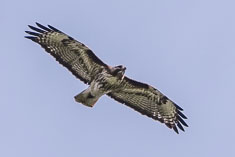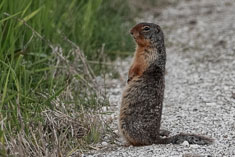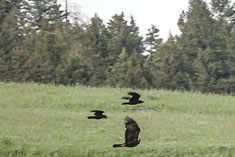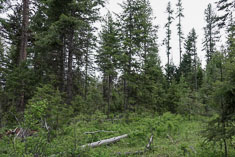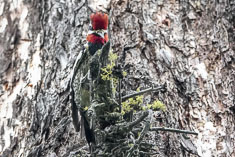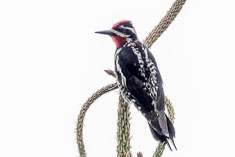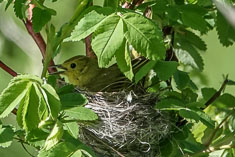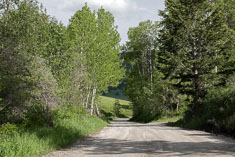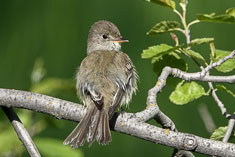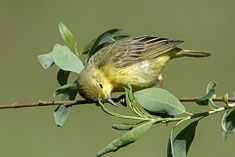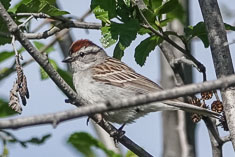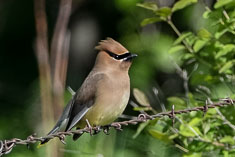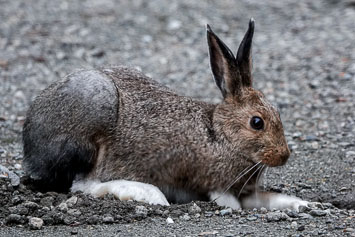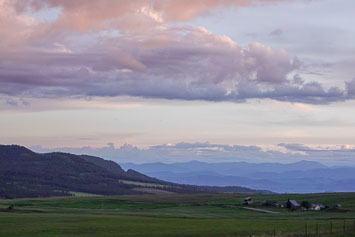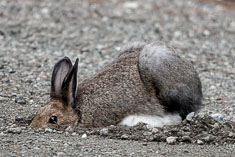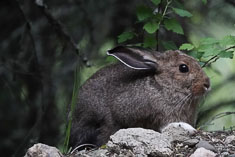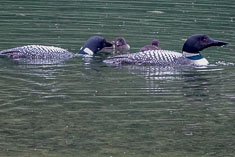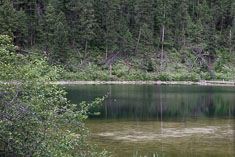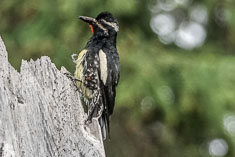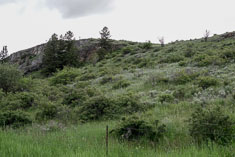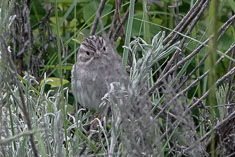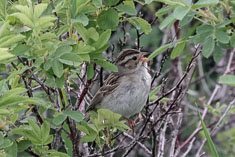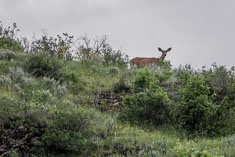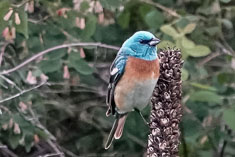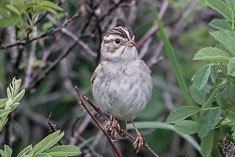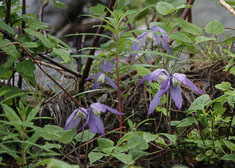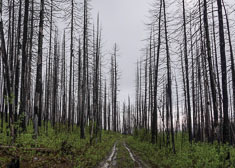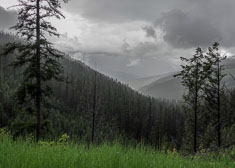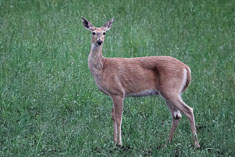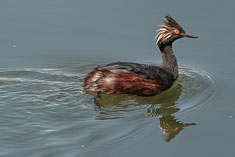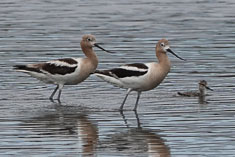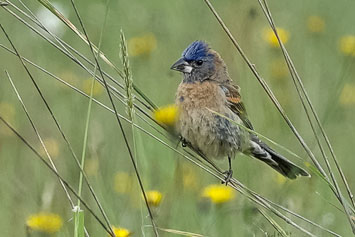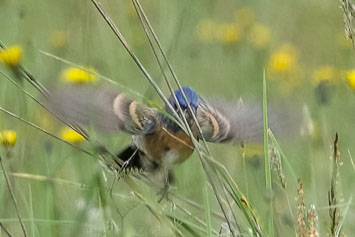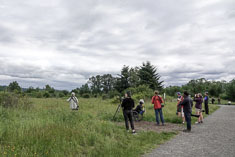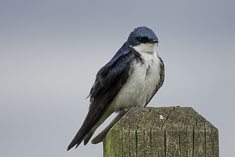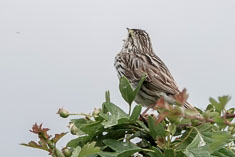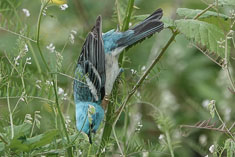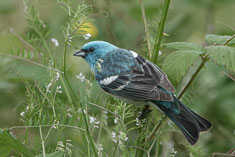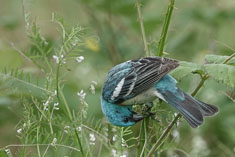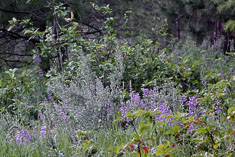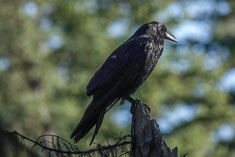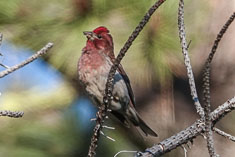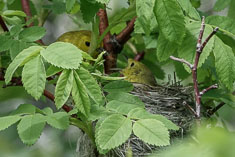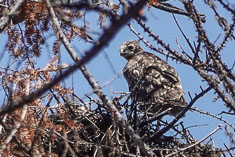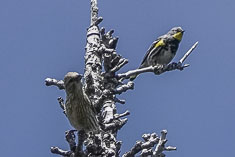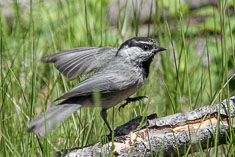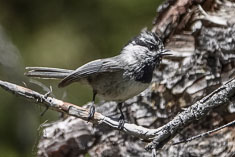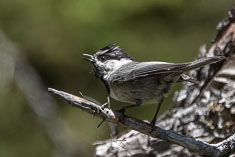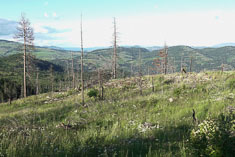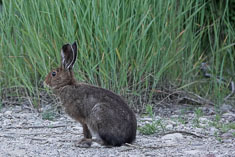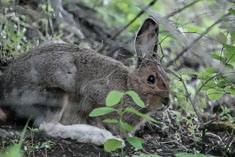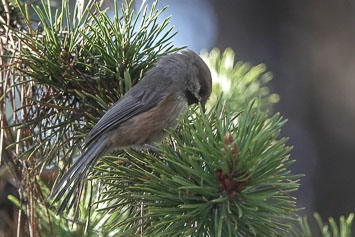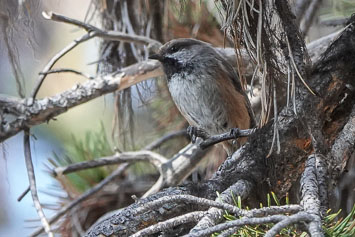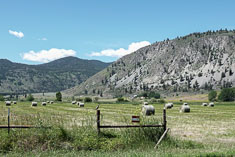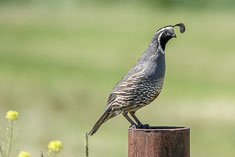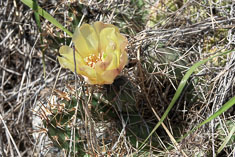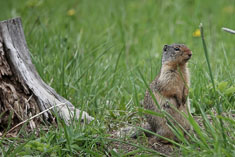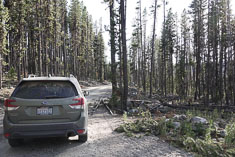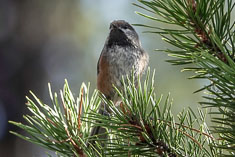4/02/2022 Ross's Goose (link to here)
Friday (yesterday) afternoon Darchelle came into the office where I was puttering on the computer
and announced that a Ross's Goose had been spotted along Sprague Lake. "Can we get there this
afternoon?" she asked. A Ross's Goose had been our last new bird of 2021, which we were finally
able to see down at Vancouver Lake on December 30 on what was probably our third or fourth attempt,
so to find one this early in the year would be worth a long drive. "Too long", I suggested, "to
make it out there this afternoon."
We made it out to Sprague by 10 o'clock the next morning and easily found the small flock of Snow Geese with which the Ross's Goose had been associating the previous afternoon, but the flock was far enough out in a pasture that it was difficult to be sure that the Ross's was still with them. Once we determined that the small white goose in the flock was our target bird, we lingered for another couple of hours hoping for better photos, and also looking for an American Pipit. Had we been successful in either of those quests we might have been willing to head home, in which case we could have run over to Des Moines first thing in the morning on Sunday and seen the rare Black-headed Gull which Rafael F discovered at Saltwater State Park about an hour before we got to Sprague. But we weren't successful so we didn't get home to look at the gull on Sunday morning so we ended up devoting most of the following week to searching for it.
Instead we drove south across the Palouse to Waitsburg. Arriving about three hours too late to
get coffee at Ten Ton Coffee +,
Darchelle went next door to The Royal
Block + wine bar instead where she picked up a tasty hot drink consisting of coffee and dried
mushrooms in a very nice little insulated cup which kept that beverage too hot to drink until we
were well into our search for the Great Gray Owl up on Jasper Mountain. We searched for about
three hours over ten miles and found only a Long-eared Owl, which ironically may be even less
common in the Blues than the Great Gray. A bright crescent caught the dim full moon sinking
over the valley as we started down North Fork Coppei Creek Road. Darchelle called her folks,
returning from Portland but still three hours away in Hood River, to see if we could spend the
night with them. They said yes, of course. We left the lights on for them.
After a pleasant visit with Richard and Donna over breakfast and a quick hour with Sally and the kids at their house we headed home, picking up two easy year birds on the way down the Walla Walla Valley. The second, an American Avocet, was #250, three days late.
We made it out to Sprague by 10 o'clock the next morning and easily found the small flock of Snow Geese with which the Ross's Goose had been associating the previous afternoon, but the flock was far enough out in a pasture that it was difficult to be sure that the Ross's was still with them. Once we determined that the small white goose in the flock was our target bird, we lingered for another couple of hours hoping for better photos, and also looking for an American Pipit. Had we been successful in either of those quests we might have been willing to head home, in which case we could have run over to Des Moines first thing in the morning on Sunday and seen the rare Black-headed Gull which Rafael F discovered at Saltwater State Park about an hour before we got to Sprague. But we weren't successful so we didn't get home to look at the gull on Sunday morning so we ended up devoting most of the following week to searching for it.
After a pleasant visit with Richard and Donna over breakfast and a quick hour with Sally and the kids at their house we headed home, picking up two easy year birds on the way down the Walla Walla Valley. The second, an American Avocet, was #250, three days late.
4/03/2022 Home for an afternoon (link to here)
Darchelle unpacked the car from our quick trip to the east side then settled me at the computer while she did some slightly overdue yardwork. She was cleaning dead leaves from around the Iris by the driveway when she uncovered a nest of Eastern Cottontail Rabbits. They are considered an invasive species in Western Washington and highly unpopular with local gardeners but the furry little 4" bunnies with their white ears the size of Magnolia petals were so cute that we just couldn't do the right thing. Darchelle carefully covered up the nest again. When she was done with the front yard it looked great but the backyard still needs work, as does the storage shed. Now that our first quarter birding push is over, perhaps we will get to those. Meanwhile our pet Skunk Cabbages are flowering, just like the wild ones.
Darchelle unpacked the car from our quick trip to the east side then settled me at the computer while she did some slightly overdue yardwork. She was cleaning dead leaves from around the Iris by the driveway when she uncovered a nest of Eastern Cottontail Rabbits. They are considered an invasive species in Western Washington and highly unpopular with local gardeners but the furry little 4" bunnies with their white ears the size of Magnolia petals were so cute that we just couldn't do the right thing. Darchelle carefully covered up the nest again. When she was done with the front yard it looked great but the backyard still needs work, as does the storage shed. Now that our first quarter birding push is over, perhaps we will get to those. Meanwhile our pet Skunk Cabbages are flowering, just like the wild ones.
4/08/2022 Black-headed Gull (link to here)
Monday the 4th we arrived at Saltwater State Park about an hour after the Black-headed Gull
apparently left. The weather was sunny except when a rain squall would ride the southwest breeze up
the five-mile fetch of the Sound and into our faces. Actually most of the squalls missed us, except
for a particularly nasty one which blasted overhead at almost the very moment when Ed rediscovered
the gull sitting among 100 or so Bonaparte's on a private beach 100 yards from our vantage point.
Darchelle and I had just fled back to our car when Ed's discovery was confirmed so we raced back out
into the rain. My ventilator and I hid under a blanket while Darchelle searched for the elusive
bird. About an hour later she found the gull in her scope again but lost it again before anyone
else could see it. Thoroughly chilled, I returned to the car for the rest of the afternoon while
Darchelle and other birders waited for the gull to reappear. It didn't.
Tuesday Darchelle worked. Despite considerable effort devoted by other birders to the search, the gull was not seen until about 6 PM, and then only by two people. Armed with the evidence of those sightings Darchelle convinced me to try again on Wednesday. Accompanyied by a revolving crowd of fellow birdwatchers, we spent 10 hours shivering in the sunshine, watching the beach and waiting in vain for the bird to show up. It did not. Thursday we stayed home, but a single reliable report late in the day convinced us that the bird was still in town.
Friday the 8th we returned to
Saltwater State Park l+ after a leisurely morning and resumed our vigil, except I stayed in the car
and started an audiobook, The Stand by Stephen King. It is 42 hours long, which I figured
would be enough and it was. Darchelle began scoping from the beach and almost immediately picked
the Black-headed Gull out from among several dozen Bonaparte's Gulls and took some identifying
photos before bringing me out to see it. I examined the gull flock on the beach and saw several
tiny pale spots, one of which was the bird. We hung
out there for another five hours during which Darchelle tried for better photos while I listened to
my audiobook. Back at home examining her photos on the computer, I got my identifying view of the
Black-headed Gull.
Tuesday Darchelle worked. Despite considerable effort devoted by other birders to the search, the gull was not seen until about 6 PM, and then only by two people. Armed with the evidence of those sightings Darchelle convinced me to try again on Wednesday. Accompanyied by a revolving crowd of fellow birdwatchers, we spent 10 hours shivering in the sunshine, watching the beach and waiting in vain for the bird to show up. It did not. Thursday we stayed home, but a single reliable report late in the day convinced us that the bird was still in town.
4/09/2022 Spring flowers (link to here)
I enjoy the flowers in our garden the same way I watch birds, by looking at Darchelle's photos on the computer. My world consists of our kitchen and our jungle room, both illustrated above, and also the remodeled downstairs bathroom, a good photo of which we have still not managed to get. The garden is beautiful though, and I do get to see it from the car when we embark on our outings and sometimes when we return. Of course, Darchelle would be happy to push me out to the front sidewalk in my wheelchair so I could enjoy the views in person but that generally feels to me like too much trouble. I am more comfortable on the computer.
I enjoy the flowers in our garden the same way I watch birds, by looking at Darchelle's photos on the computer. My world consists of our kitchen and our jungle room, both illustrated above, and also the remodeled downstairs bathroom, a good photo of which we have still not managed to get. The garden is beautiful though, and I do get to see it from the car when we embark on our outings and sometimes when we return. Of course, Darchelle would be happy to push me out to the front sidewalk in my wheelchair so I could enjoy the views in person but that generally feels to me like too much trouble. I am more comfortable on the computer.
4/11/2022 Neah Bay (link to here)
Neah Bay, a Makah village in the northwest corner of the Olympic Peninsula which is one of the premier birding destinations in Washington state (at least in the fall) has been closed to outsiders since shortly after the coronavirus pandemic began. One month ago it opened up again so we decided to head out there, partly for old time's sake and partly because someone reported nine Black-legged Kittiwakes there last week. Kittiwakes are normally found well offshore in the winter months but can occasionally be seen along the coast as late as the middle of April. The kittiwake report also included 2,500 American Robins so we weren't sure how credible it was, but we've been looking for a kittiwake so we went anyway.
We missed the kittiwake but not by much, though that did not make us feel any better about missing it. We did not find any trace of the mythical mine kittiwakes previously reported but we did drive right by a beach where two of them had been seen l+ on Monday morning just a half-hour before we passed. We actually happened to stop and do a checklist l+ a mere half-mile beyond the spot but did not notice any kittiwakes, just Short-billed and Glaucous-winged Gulls. And some American Robins; we did find lots of those, though nowhere near 2,500.
On our trip west Sunday afternoon we stopped at Ediz Hook l+
in Port Angeles where Darchelle got some nice photos. The sky was partly cloudy with not much wind
giving the Strait a moody feel and the ducks were taking it easy along the pebbly harbor beach.
Later as we crossed the height of land west of Lake Crescent we ran into snow showers. The big trees
on the mountainsides on either side of the road were covered with snow; it looked like winter, but by
the time we reached Sappho the hills were green again. Skunk Cabbages dotted the marshes with their
yellow spathes.
It's a 4 1/2 hour drive from home all the way out to Neah Bay so with our late start and stops along
the way, we didn't get there until after 5 PM. We did a checklist l+ in town, doing our best to account for all the ducks and gulls out on
the water, but I'm sure we missed a few. I sat in the car while Darchelle scoped because the breeze,
though light, was chilly. Seeking a spot where I might be able to look out on the water and see a
Tufted Puffin, we drove out to Cape Flattery then south along Hobuck Beach but neither the Cape nor
the beach are accessible to a wheelchair. It might however be possible to find a vantage point along
the Cape Loop Road northwest of town, perhaps in the area near Warmhouse Beach.
On the way back to town we took the Makah Passage Road. The potholes are notably worse than they were three years ago but we had nice views of a herd of Roosevelt Elk.
When we'd arrived in Neah Bay we'd started looking for a place to stay but everyone was either full or closed. We probably could have gotten a room at Butler's if we had called ahead in the morning. We drove back to Sekiu instead and stayed at the Bay Motel. They offer telephones and TVs in every room. Our room had a coffee maker and a microwave as well, though I don't know about Internet. We stayed in room 104 and it was dim but comfortable enough. As usual, the toilet was low so we used the padded toilet seat for the first time and it helped I think.
Monday morning we returned to Neah Bay and birded out to the jetty l+. The gate was open, the "Authorized Vehicles Only" sign barely legible and the road well-tracked; the only other vehicle we saw out there had a purple Makah recreational permit on their dashboard, just like us. The weather was glorious but the birds were pretty quiet.
On the way home we stopped in Sequim and spent an hour or so at Dungeness Landing scoping shorebirds, then another half-hour looking for American Pipits along Schmuck Road but did not bother to enter any checklists. Or perhaps we haven't gotten around to submitting them yet; I'm not sure. Worth noting, as we approached Sappho a bobcat ran across the road in front of us, rocking back and forth on long stiff legs, short tail erect. Unmistakable! I don't think I've seen one since my trip to Big Bend + with John M.
As we pulled into our driveway Mama rabbit was just taking her five little bunnies on a short hop across the driveway. Seeing our headlights she changed her mind and hopped back to the Iris patch but the little ones, uncertain as to what to do, paused all in a line under Monica's car. Before we could dig out the camera they decided that it was suppertime and they all hopped over to Mama to nurse.
Neah Bay, a Makah village in the northwest corner of the Olympic Peninsula which is one of the premier birding destinations in Washington state (at least in the fall) has been closed to outsiders since shortly after the coronavirus pandemic began. One month ago it opened up again so we decided to head out there, partly for old time's sake and partly because someone reported nine Black-legged Kittiwakes there last week. Kittiwakes are normally found well offshore in the winter months but can occasionally be seen along the coast as late as the middle of April. The kittiwake report also included 2,500 American Robins so we weren't sure how credible it was, but we've been looking for a kittiwake so we went anyway.
We missed the kittiwake but not by much, though that did not make us feel any better about missing it. We did not find any trace of the mythical mine kittiwakes previously reported but we did drive right by a beach where two of them had been seen l+ on Monday morning just a half-hour before we passed. We actually happened to stop and do a checklist l+ a mere half-mile beyond the spot but did not notice any kittiwakes, just Short-billed and Glaucous-winged Gulls. And some American Robins; we did find lots of those, though nowhere near 2,500.
On the way back to town we took the Makah Passage Road. The potholes are notably worse than they were three years ago but we had nice views of a herd of Roosevelt Elk.
When we'd arrived in Neah Bay we'd started looking for a place to stay but everyone was either full or closed. We probably could have gotten a room at Butler's if we had called ahead in the morning. We drove back to Sekiu instead and stayed at the Bay Motel. They offer telephones and TVs in every room. Our room had a coffee maker and a microwave as well, though I don't know about Internet. We stayed in room 104 and it was dim but comfortable enough. As usual, the toilet was low so we used the padded toilet seat for the first time and it helped I think.
Monday morning we returned to Neah Bay and birded out to the jetty l+. The gate was open, the "Authorized Vehicles Only" sign barely legible and the road well-tracked; the only other vehicle we saw out there had a purple Makah recreational permit on their dashboard, just like us. The weather was glorious but the birds were pretty quiet.
On the way home we stopped in Sequim and spent an hour or so at Dungeness Landing scoping shorebirds, then another half-hour looking for American Pipits along Schmuck Road but did not bother to enter any checklists. Or perhaps we haven't gotten around to submitting them yet; I'm not sure. Worth noting, as we approached Sappho a bobcat ran across the road in front of us, rocking back and forth on long stiff legs, short tail erect. Unmistakable! I don't think I've seen one since my trip to Big Bend + with John M.
As we pulled into our driveway Mama rabbit was just taking her five little bunnies on a short hop across the driveway. Seeing our headlights she changed her mind and hopped back to the Iris patch but the little ones, uncertain as to what to do, paused all in a line under Monica's car. Before we could dig out the camera they decided that it was suppertime and they all hopped over to Mama to nurse.
4/15/2022 Big Ditch Trailhead (link to here)
Twice in the last 10 days David Poortinga (but no one else) has reported a flock of American Pipits
in the farm fields along the access road for the Big Ditch Trailhead north of Stanwood. While not
exactly uncommon, pipits are somewhat difficult to run across in the spring, though much easier
in the fall. We don't want to wait until the fall so we drove up there this afternoon. The trail
along the dike turned out to be nonnegotiable with a wheelchair so we just drove the access road,
stopping to look and listen for inconspicuous gray birds among the cornstalks. When we did not
detect any (the Merlin sitting on top of a bush overlooking the cornfield may have had something
to do with that), we tried a few neighboring roads to the south going down as far as the outskirts of
town. Good pipit habitat - corn stubble, sparse weedy cover, scattered puddles in muddy pastures -
but no pipits so we returned to Big Ditch.
The Merlin was gone and a very dark dark phase juvenile Red-tailed Hawk had taken its place. Red-tails don't generally eat pipits so maybe that is why we were able to find them in the corn stubble near the trailhead. Darchelle first heard one then searched the field until she spotted one bobbing between the cornstalks close to the road. She got a few photos and was able to turn the car so I could see it before it and about 50 others flushed and flew off to the southwest in a big disorganized flock.
Mission accomplished!
The Merlin was gone and a very dark dark phase juvenile Red-tailed Hawk had taken its place. Red-tails don't generally eat pipits so maybe that is why we were able to find them in the corn stubble near the trailhead. Darchelle first heard one then searched the field until she spotted one bobbing between the cornstalks close to the road. She got a few photos and was able to turn the car so I could see it before it and about 50 others flushed and flew off to the southwest in a big disorganized flock.
Mission accomplished!
4/20/2022 Day Trip (link to here)
It didn't feel like a day trip by the time we got home, but it was. A Red Phalarope was reported, and photographed, on the beach at Ocean Shores yesterday afternoon. That's a pelagic bird, rarely seen within 30 miles of shore. Since my condition pretty much precludes getting out 30 miles offshore, one on the beach is worth a chase, at least in our estimation, so we drove out to Ocean Shores and looked for it.
But first there was the Grasshopper Sparrow at Marymoor Park. One of the energetic young birders in King County found it a few days ago and it was still being seen this morning in its adopted spot along a grassy trail. I had mistakenly thought that it was 0.9 miles from the parking lot so I wasn't particularly inclined to go look for it but when Darchelle told me it was only 0.09 miles, and that it was very easy to locate, I agreed to try for it. I am glad that we did; it was my 249th species in the county, but it was not easy to locate.
We missed the correct location on our way out and wheeled along the trail about twice as far as we needed to. The grass in the trail was short but lumpy making it a rough ride. Darchelle held by head against the headrest so it didn't whip around too much. Parking me a few yards from the bird's customary foraging location in the trail, Darchelle went searching for it and found it in the tall grass right behind the handful of birdwatchers who were also monitoring the trail. Fortunately for them it soon returned to its spot. Unfortunately for us that spot was between us and our car. Not wanting to disturb the bird while others were watching it, we tried to wait until no one else was present before wheeling back to the parking lot but more birdwatchers kept on showing up. Eventually we asked the little crowd of birders and photographers if we could pass by, potentially disturbing the bird. They consented so we proceeded and the bird flushed out into the tall grass just as we had feared it would. The photographers did not complain though. It gave them opportunity to take pictures of the bird in a more natural setting than the short grass of the trail, without having to flush the bird themselves.
The forecast for the coast called for rain, quite a bit of it, and it was raining hard when we
reached the beach at Ocean Shores. We entered at the Ocean City access l+ where the phalarope had been
seen along with lots of dowitchers and Dunlin. We found lots of Dublin and Western Sandpipers
hunkered down against the rain and wind but did not notice any dowitchers and did not find the
phalarope. We did find two Red Knots, a formerly common shorebird which has become scarce enough
that we were not sure we would get it this spring.
The rain tapered off and quit but it had been more helpful than I had anticipated, keeping people
and vehicles off the beach for the most part and distracting the shorebirds from our presence so we
were able to approach quite close to them for photos. Darchelle took lots. A flock of Marbled Godwits
flew in to roost on the beach while they waited for low tide to expose the mudflats on which they
forage. The knots joined them, apparently preferring the company of the larger birds. We took more
photos.
Between beach drives we noticed shorebirds flying over town and tracked them to
the the golf course l+,
where we found the Short-billed Dowitchers, presumably the same birds with which the phalarope
had been associating. The course looked pretty wet for golfing but the birds appeared to
appreciate it.
The mile or so of beach closest to town and another mile or two down by the jetty are closed between April 15 and Labor Day but we drove the remainder of the beach in hopes of finding the phalarope. We found a recently-deceased Harbor Seal attended by a bloody-faced Bald Eagle. I wondered if the meat would still be edible; I haven't eaten seal meat since the year I spent in Newfoundland after high school. I don't think I would have been tempted to carve off a chunk even if I'd been able to.
Shortly before sunset we left the beach via the Ocean Lake Way access + and paused at the bank of Willows and Wax Myrtle just inshore of the dunes. Flocks of geese were flying north overhead and a couple of Least Sandpipers were working the ditch along the road, both glowing in the evening light. We played recordings of Palm Warbler songs but called in only Yellow-rumps, including a Myrtle. I had good views. It was a nice conclusion to a good day. Darchelle wanted to extend it by spending the night so we can drive the beach again in the morning but with the prospect of a trip to the Okanogan looming over the weekend, I wanted to get home. We passed the 2 1/2 hour drive listening to The Stand by Stephen King, leaving us thoroughly disoriented by the time we pulled into our driveway.
It didn't feel like a day trip by the time we got home, but it was. A Red Phalarope was reported, and photographed, on the beach at Ocean Shores yesterday afternoon. That's a pelagic bird, rarely seen within 30 miles of shore. Since my condition pretty much precludes getting out 30 miles offshore, one on the beach is worth a chase, at least in our estimation, so we drove out to Ocean Shores and looked for it.
But first there was the Grasshopper Sparrow at Marymoor Park. One of the energetic young birders in King County found it a few days ago and it was still being seen this morning in its adopted spot along a grassy trail. I had mistakenly thought that it was 0.9 miles from the parking lot so I wasn't particularly inclined to go look for it but when Darchelle told me it was only 0.09 miles, and that it was very easy to locate, I agreed to try for it. I am glad that we did; it was my 249th species in the county, but it was not easy to locate.
We missed the correct location on our way out and wheeled along the trail about twice as far as we needed to. The grass in the trail was short but lumpy making it a rough ride. Darchelle held by head against the headrest so it didn't whip around too much. Parking me a few yards from the bird's customary foraging location in the trail, Darchelle went searching for it and found it in the tall grass right behind the handful of birdwatchers who were also monitoring the trail. Fortunately for them it soon returned to its spot. Unfortunately for us that spot was between us and our car. Not wanting to disturb the bird while others were watching it, we tried to wait until no one else was present before wheeling back to the parking lot but more birdwatchers kept on showing up. Eventually we asked the little crowd of birders and photographers if we could pass by, potentially disturbing the bird. They consented so we proceeded and the bird flushed out into the tall grass just as we had feared it would. The photographers did not complain though. It gave them opportunity to take pictures of the bird in a more natural setting than the short grass of the trail, without having to flush the bird themselves.
The mile or so of beach closest to town and another mile or two down by the jetty are closed between April 15 and Labor Day but we drove the remainder of the beach in hopes of finding the phalarope. We found a recently-deceased Harbor Seal attended by a bloody-faced Bald Eagle. I wondered if the meat would still be edible; I haven't eaten seal meat since the year I spent in Newfoundland after high school. I don't think I would have been tempted to carve off a chunk even if I'd been able to.
Shortly before sunset we left the beach via the Ocean Lake Way access + and paused at the bank of Willows and Wax Myrtle just inshore of the dunes. Flocks of geese were flying north overhead and a couple of Least Sandpipers were working the ditch along the road, both glowing in the evening light. We played recordings of Palm Warbler songs but called in only Yellow-rumps, including a Myrtle. I had good views. It was a nice conclusion to a good day. Darchelle wanted to extend it by spending the night so we can drive the beach again in the morning but with the prospect of a trip to the Okanogan looming over the weekend, I wanted to get home. We passed the 2 1/2 hour drive listening to The Stand by Stephen King, leaving us thoroughly disoriented by the time we pulled into our driveway.
4/24/2022 Okanogan Exploration (link to here)
We didn't expect success on this trip, at least I didn't. Our plan was to drive over to Liberty Friday afternoon, try for Spotted Owl in that area for several hours after sunset then continue on to Wenatchee for the night. Saturday morning we would swing by Winthrop to pick up a Dusky Grouse before heading up to Havillah in the Okanogan Highlands to look for a Great Great Owl. We would spend Saturday night in Tonasket then bird our way back home, empty-handed I assumed. I was mostly right.
A report of an Eastern Phoebe in Roslyn tinkered with our plan a little bit. The report was credible even if the bird was unlikely; they show up in New Hampshire around this time, so why not in Washington. (Well, they aren't even annual in the state, for one thing.) We were only ten miles away when Darchelle noticed the report so we stopped to look for it, spent the night at the very comfortable Stewart Lodge + (room 301) in Cle Elum and looked for it some more in the morning. We did not find it, and as far as I know nobody else even looked for it, but it was fun to see Roslyn, a historic coal mining town + with considerably more authentic-looking architecture than Winthrop. We did spend a couple of hours after dark playing Spotted Owl calls along about four miles of Forest Road 9712 above Liberty. I was surprised to encounter just as much snow on the road as we had found when we searched for a Northern Goshawk up there at the end of March. I was not surprised to encounter no Spotted Owls.
When we visit an area and don't take any pictures it is almost as if the visit never happened.
So it was with our day in the Highlands. We hit the snow park a couple of times and
the Lost Lake Road l+ in
between but didn't find anything exciting other than a possible Northern Goshawk
circling over Havillah. It was probably a Raven but the shape wasn't quite right and the
wingbeats seemed a little stiff. It flew off towards Bonaparte Mountain and we lost it before
we could get a photo. No Great Gray Owl either. We spent the night in the ADA room at the Junction
Motel behind the gas station in Tonasket. It was more than adequate and we would not hesitate
to stay there again.
On the way to Winthrop in the morning we took a flyer on a forest road several miles east of Loup Loup summit. The Cook Mountain Road l+ climbed into a clearcut right away which looked unpromising but delivered our first of the year Nashville Warblers before yielding to very pleasant and quite birdy Ponderosa Pine forest. Up at the pass we took another forest road past the Loup Loup Campground l+ and up into some mature spruce and larch in which I thought we might find a Boreal Chickadee or a Three-toed Woodpecker but we did not.
Having missed our first three target species for the trip, we were really hoping that
Sun Mountain Lodge l+ in
Winthrop would deliver us a Dusky Grouse as it has on each of the past four years (although never
before the middle of May and usually much later). For me, spotting a grouse there has become more
difficult since I lost the ability to walk. Last year I sent Darchelle out to beat around the
bushes in order to find one and attempt to herd it into a spot where I could see it from the car.
Last year that worked! This year it did not, at least not at first.
Darchelle hiked around the slopes above the upper parking area but uncovered no grouse. Returning to the car, she started driving up the View Ridge Interpretive Trail. Although the trail was actually double track, I was certain that driving on it was not allowed. I scanned the grounds but nobody was paying any attention to us so I agreed to proceed, not that Darchelle was waiting for my permission. We wound our way up the hill, passing two water tanks and a greenhouse up on top before dropping down into a little saddle with a gorgeous view.
Parking the car off the trail, she got out to scout and within a few minutes found a grouse lurking under the skirt of branches at the base of a nearby Douglas Fir. She came down to announce her find and to tell me where to look while she went up to flush it. That proved easier said than done but eventually she was able to nudge it out from its hiding place long enough for me to spot it between a Balsamroot and a Bitterbrush bush. Darchelle withdrew and the grouse immediately returned to its lair. We thought it might be on eggs before we realized that it was a male. We wondered if we had already met.
Parts of the hillside near the water tanks had burned in a fire last summer but out of the blackened ground beautiful deep blue Mertensias, no more than 3 inches tall, were in full flower. We should have taken a picture but I was preoccupied with getting out of there before we got caught.
On our way out of the valley we stopped at the Twisp River Tap House + to see if they had any good food. They did! My pastrami sandwich, apparently made with prosciutto, was delicious but Darchelle's grilled cheese Panini with caramelized shallots and Mama Lil's mild spice sweet peppers was amazing. I wouldn't have minded grabbing a beer as well but we had a long drive ahead and they didn't do half growlers.
Passing Cashmere at dusk we pulled off on the Old Blewett Pass Road and drove up a mile or so before the snow got too deep, then played a few places for Spotted Owls. We did not get any response, no doubt because they could not hear us over the roar of the creek rushing along the road.
We didn't expect success on this trip, at least I didn't. Our plan was to drive over to Liberty Friday afternoon, try for Spotted Owl in that area for several hours after sunset then continue on to Wenatchee for the night. Saturday morning we would swing by Winthrop to pick up a Dusky Grouse before heading up to Havillah in the Okanogan Highlands to look for a Great Great Owl. We would spend Saturday night in Tonasket then bird our way back home, empty-handed I assumed. I was mostly right.
A report of an Eastern Phoebe in Roslyn tinkered with our plan a little bit. The report was credible even if the bird was unlikely; they show up in New Hampshire around this time, so why not in Washington. (Well, they aren't even annual in the state, for one thing.) We were only ten miles away when Darchelle noticed the report so we stopped to look for it, spent the night at the very comfortable Stewart Lodge + (room 301) in Cle Elum and looked for it some more in the morning. We did not find it, and as far as I know nobody else even looked for it, but it was fun to see Roslyn, a historic coal mining town + with considerably more authentic-looking architecture than Winthrop. We did spend a couple of hours after dark playing Spotted Owl calls along about four miles of Forest Road 9712 above Liberty. I was surprised to encounter just as much snow on the road as we had found when we searched for a Northern Goshawk up there at the end of March. I was not surprised to encounter no Spotted Owls.
On the way to Winthrop in the morning we took a flyer on a forest road several miles east of Loup Loup summit. The Cook Mountain Road l+ climbed into a clearcut right away which looked unpromising but delivered our first of the year Nashville Warblers before yielding to very pleasant and quite birdy Ponderosa Pine forest. Up at the pass we took another forest road past the Loup Loup Campground l+ and up into some mature spruce and larch in which I thought we might find a Boreal Chickadee or a Three-toed Woodpecker but we did not.
Darchelle hiked around the slopes above the upper parking area but uncovered no grouse. Returning to the car, she started driving up the View Ridge Interpretive Trail. Although the trail was actually double track, I was certain that driving on it was not allowed. I scanned the grounds but nobody was paying any attention to us so I agreed to proceed, not that Darchelle was waiting for my permission. We wound our way up the hill, passing two water tanks and a greenhouse up on top before dropping down into a little saddle with a gorgeous view.
Parking the car off the trail, she got out to scout and within a few minutes found a grouse lurking under the skirt of branches at the base of a nearby Douglas Fir. She came down to announce her find and to tell me where to look while she went up to flush it. That proved easier said than done but eventually she was able to nudge it out from its hiding place long enough for me to spot it between a Balsamroot and a Bitterbrush bush. Darchelle withdrew and the grouse immediately returned to its lair. We thought it might be on eggs before we realized that it was a male. We wondered if we had already met.
Parts of the hillside near the water tanks had burned in a fire last summer but out of the blackened ground beautiful deep blue Mertensias, no more than 3 inches tall, were in full flower. We should have taken a picture but I was preoccupied with getting out of there before we got caught.
On our way out of the valley we stopped at the Twisp River Tap House + to see if they had any good food. They did! My pastrami sandwich, apparently made with prosciutto, was delicious but Darchelle's grilled cheese Panini with caramelized shallots and Mama Lil's mild spice sweet peppers was amazing. I wouldn't have minded grabbing a beer as well but we had a long drive ahead and they didn't do half growlers.
Passing Cashmere at dusk we pulled off on the Old Blewett Pass Road and drove up a mile or so before the snow got too deep, then played a few places for Spotted Owls. We did not get any response, no doubt because they could not hear us over the roar of the creek rushing along the road.
4/26/2022 Garden (link to here)
I don't get out see the front yard very often so Darchelle took some photos to show me what I'm missing.
I don't get out see the front yard very often so Darchelle took some photos to show me what I'm missing.
4/27/2022 Solitary Sandpiper (link to here)
In Washington state the Solitary Sandpiper is common enough that we see it almost every year but rare enough that we make sure not to pass up an opportunity to look for it if we don't already have it for the year. The past two years we have driven down to Fife to find it in a farmer's field along the Puyallup River. This year the first one close enough to reasonably chase was a bird Ann Marie W found yesterday in the wet pastures along 38th St SE l+ in Everett. Maxine alerted us to Ann Marie's find, for which we are grateful because we were able to get good looks and nice photos this morning.
Ed and Delia joined us in our quest today and arriving before we did, located the bird right away but it had flown by the time we showed up. That was not good news. We drove farther down 38th St hoping it had landed somewhere nearby and sure enough it had. Or so we thought. Actually the bird we spotted was a second individual because while we were looking at it, Ed and Delia's bird reappeared. Darchelle got photos of both of them.
She also took photos, lots of photos, of a male Common Yellowthroat whose territory spanned the road near where we parked and who responded with an apparent mix of curiosity and indignation to our playback of other Common Yellowthroat songs.
An hour later at Carillon Woods Park l+ in Kirkland we heard our first of the year Black-throated Gray and Wilson's Warblers. No photos; the birds, though numerous, were foraging high in the crowns of the trees or hiding in the understory.
In Washington state the Solitary Sandpiper is common enough that we see it almost every year but rare enough that we make sure not to pass up an opportunity to look for it if we don't already have it for the year. The past two years we have driven down to Fife to find it in a farmer's field along the Puyallup River. This year the first one close enough to reasonably chase was a bird Ann Marie W found yesterday in the wet pastures along 38th St SE l+ in Everett. Maxine alerted us to Ann Marie's find, for which we are grateful because we were able to get good looks and nice photos this morning.
Ed and Delia joined us in our quest today and arriving before we did, located the bird right away but it had flown by the time we showed up. That was not good news. We drove farther down 38th St hoping it had landed somewhere nearby and sure enough it had. Or so we thought. Actually the bird we spotted was a second individual because while we were looking at it, Ed and Delia's bird reappeared. Darchelle got photos of both of them.
She also took photos, lots of photos, of a male Common Yellowthroat whose territory spanned the road near where we parked and who responded with an apparent mix of curiosity and indignation to our playback of other Common Yellowthroat songs.
An hour later at Carillon Woods Park l+ in Kirkland we heard our first of the year Black-throated Gray and Wilson's Warblers. No photos; the birds, though numerous, were foraging high in the crowns of the trees or hiding in the understory.
4/28/2022 Cascade Loop (link to here)
The official Cascade Loop + is a 440 mile auto route on highways 20, 97 and 2 over the North Cascades and Stevens Pass. We spent two days on a more modest tour over Snoqualmie Pass and White Pass, not as dramatic but nonetheless good for nine new year birds, more than we found during the first three weeks of April altogether. Better yet, one of those birds was a Pine Grosbeak, a bird we tried for and missed multiple times during the first three months of the year.
On our way up to Snoqualmie Pass we stopped at the unofficial Christmas Lake trailhead l+ near Rattlesnake Lake. I hoped we might find a flycatcher or two there. Darchelle got me out of the car and into the chair. The morning was damp so we did not venture up the trail but instead sat at the gate and listened. The morning was also quiet so we had to be patient but after 40 minutes we had heard 24 species and had seen about three of them. Two were new, including one flycatcher. One of the birds that we did see was a Pacific Wren. Darchelle took a photo of it in mid-song, her first-ever photo of that species, I think. Another bird photographer told us recently that you can only find Pacific Wrens singing from a prominent perch before 8AM. After that they stay hidden in the understory. If so, then that wren was an exception to the rule because the timestamp on the photo is 8:51AM. Maybe it felt earlier than that to the wren. It certainly did to me.
A Calliope Hummingbird at the Denny Ave trailhead for the Coal Mine trail l+ in Cle Elum was our third new year bird of the day. Darchelle got some nice photos. Hummingbirds are easy to photograph at the feeders at the last house on the left before the trailhead but I much prefer the more natural images of them sitting in the currant bush. Talking with the homeowner on our last visit, we agreed that the currant was probably Ribes aureum, a species I learned in my college botany class in the spring of my senior year. The homeowner, whose name I did not catch, also told us that he had conducted an experiment to try to determine how many hummingbirds visited his feeders in the course of a day in early May. By weighing all his feeders first thing in the morning and again at the end of the day, he calculated that the hummingbirds had collectively consumed a kilogram of sugar water. Assuming that the hummingbirds weigh on average 4gm each and consume their body weight in sugar water each day (about 16 kcal at 4 kcal/gm), he fed about 250 hummingbirds that day.
At Railroad Ponds l+ in Cle Elum we found our first House Wren of the year but it declined to be photographed. A nearby Nashville Warbler was more cooperative. More colorful too.
Seeking early Bank Swallows we took Hwy 10 from Cle Elum about 10 miles down the canyon of the Yakima River towards Ellensburg until we reached the white sandstone cliff where I thought we had seen them last year or the year before. Later I realized we had never seen Bank Swallows there, and this year was no different. By the way, that white sandstone + is the 4Ma Thorpe gravel, apparently eroded from sources to the west and deposited unconformably on the 16Ma Grand Ronde basalt flows around the time the modern Cascades were rising.
Out of Ellensburg we took the Umtanum Road over to Barbecue Flats l+ in the Wenas Valley in search of a previously reported and somewhat early Gray Flycatcher, an Empid flycatcher distinguished by its rather deliberate downward tail wag. The gate to Barbecue Flats was closed at the edge of the pine forest but the Gray Flycatcher answered our calls. Birds were fairly active despite it being mid-afternoon on a gray and chilly day and Darchelle was able to get nice photos of several other species along the road. On our way out I asked her to stop and photograph the Aspen grove along Maloy Road but we found it hard to capture the abstract beauty of the pale gray trunks.
After seeing Marcus R's report of a Pine Grosbeak at Paradise Darchelle was determined to get up there and try for it. After seeing her determination I determined that it would be quicker to spend the night in Packwood and hit Paradise the next morning than it would be to go home first so we spent the night in Packwood. We stayed at the Crest Trail Lodge again. When we stayed there a year ago the fire alarm went off at 2AM and we woke up dazed and confused. This time the phone alarm went off at 7AM and we made it out to The Mountain Goat Coffee Company + by 7:30. Unfortunately they didn't have the popovers this time but the coffee was delicious, as usual.
Thinking we might pick up a Swift or something we spent an hour looking around Packwood l+. We did get a Vaux's Swift, along with a tantalizing but insufficient view of a possible Pine Grosbeak. I did not see it; if I had we might've saved ourselves a trip to Paradise.
Up at Paradise l+ we found lots of snow, quite a few people and some very friendly Steller's and Canada Jays and eventually, a Pine Grosbeak. The grosbeak was sitting on top of a snag across the road from the Barn Flats turnout, about a mile below the parking lot. We might not have seen it had Darchelle not repositioned the car in an attempt to enable me to hear a Sooty Grouse vooping nearby. I was concentrating on hearing the grouse (unsuccessfully) when Darchelle, who was standing in front of the car, suddenly shouted "Pine Siskin! Pine Siskin! On the snag! Look up!" I knew from the tone of her voice that she was not talking about a Pine Siskin, one of which we had just seen down the road. "Get photos!" I shouted as usual. She did but it was one of those times when the camera declined to focus. Only one of the photos was acceptably sharp.
We had several possible targets at Nisqually l+ but I only remember the one that we got, the Yellow Warbler. It was a bright male right where Liam had reported it and Darchelle was able to get some nice photos. We were quite close to it so I had excellent views too. After seeing the warbler I was not inclined to continue on to the Twin Barns Overlook but Darchelle was eager so we went. We might have been looking for a Bank Swallow or perhaps a Blue-winged Teal. We did not find either one but it was difficult to be disappointed having had such a good view of the warbler, and that after seeing the Pine Grosbeak, a bird for which we'd tried multiple times in the first quarter of the year.
The official Cascade Loop + is a 440 mile auto route on highways 20, 97 and 2 over the North Cascades and Stevens Pass. We spent two days on a more modest tour over Snoqualmie Pass and White Pass, not as dramatic but nonetheless good for nine new year birds, more than we found during the first three weeks of April altogether. Better yet, one of those birds was a Pine Grosbeak, a bird we tried for and missed multiple times during the first three months of the year.
On our way up to Snoqualmie Pass we stopped at the unofficial Christmas Lake trailhead l+ near Rattlesnake Lake. I hoped we might find a flycatcher or two there. Darchelle got me out of the car and into the chair. The morning was damp so we did not venture up the trail but instead sat at the gate and listened. The morning was also quiet so we had to be patient but after 40 minutes we had heard 24 species and had seen about three of them. Two were new, including one flycatcher. One of the birds that we did see was a Pacific Wren. Darchelle took a photo of it in mid-song, her first-ever photo of that species, I think. Another bird photographer told us recently that you can only find Pacific Wrens singing from a prominent perch before 8AM. After that they stay hidden in the understory. If so, then that wren was an exception to the rule because the timestamp on the photo is 8:51AM. Maybe it felt earlier than that to the wren. It certainly did to me.
A Calliope Hummingbird at the Denny Ave trailhead for the Coal Mine trail l+ in Cle Elum was our third new year bird of the day. Darchelle got some nice photos. Hummingbirds are easy to photograph at the feeders at the last house on the left before the trailhead but I much prefer the more natural images of them sitting in the currant bush. Talking with the homeowner on our last visit, we agreed that the currant was probably Ribes aureum, a species I learned in my college botany class in the spring of my senior year. The homeowner, whose name I did not catch, also told us that he had conducted an experiment to try to determine how many hummingbirds visited his feeders in the course of a day in early May. By weighing all his feeders first thing in the morning and again at the end of the day, he calculated that the hummingbirds had collectively consumed a kilogram of sugar water. Assuming that the hummingbirds weigh on average 4gm each and consume their body weight in sugar water each day (about 16 kcal at 4 kcal/gm), he fed about 250 hummingbirds that day.
At Railroad Ponds l+ in Cle Elum we found our first House Wren of the year but it declined to be photographed. A nearby Nashville Warbler was more cooperative. More colorful too.
Seeking early Bank Swallows we took Hwy 10 from Cle Elum about 10 miles down the canyon of the Yakima River towards Ellensburg until we reached the white sandstone cliff where I thought we had seen them last year or the year before. Later I realized we had never seen Bank Swallows there, and this year was no different. By the way, that white sandstone + is the 4Ma Thorpe gravel, apparently eroded from sources to the west and deposited unconformably on the 16Ma Grand Ronde basalt flows around the time the modern Cascades were rising.
Out of Ellensburg we took the Umtanum Road over to Barbecue Flats l+ in the Wenas Valley in search of a previously reported and somewhat early Gray Flycatcher, an Empid flycatcher distinguished by its rather deliberate downward tail wag. The gate to Barbecue Flats was closed at the edge of the pine forest but the Gray Flycatcher answered our calls. Birds were fairly active despite it being mid-afternoon on a gray and chilly day and Darchelle was able to get nice photos of several other species along the road. On our way out I asked her to stop and photograph the Aspen grove along Maloy Road but we found it hard to capture the abstract beauty of the pale gray trunks.
After seeing Marcus R's report of a Pine Grosbeak at Paradise Darchelle was determined to get up there and try for it. After seeing her determination I determined that it would be quicker to spend the night in Packwood and hit Paradise the next morning than it would be to go home first so we spent the night in Packwood. We stayed at the Crest Trail Lodge again. When we stayed there a year ago the fire alarm went off at 2AM and we woke up dazed and confused. This time the phone alarm went off at 7AM and we made it out to The Mountain Goat Coffee Company + by 7:30. Unfortunately they didn't have the popovers this time but the coffee was delicious, as usual.
Thinking we might pick up a Swift or something we spent an hour looking around Packwood l+. We did get a Vaux's Swift, along with a tantalizing but insufficient view of a possible Pine Grosbeak. I did not see it; if I had we might've saved ourselves a trip to Paradise.
Up at Paradise l+ we found lots of snow, quite a few people and some very friendly Steller's and Canada Jays and eventually, a Pine Grosbeak. The grosbeak was sitting on top of a snag across the road from the Barn Flats turnout, about a mile below the parking lot. We might not have seen it had Darchelle not repositioned the car in an attempt to enable me to hear a Sooty Grouse vooping nearby. I was concentrating on hearing the grouse (unsuccessfully) when Darchelle, who was standing in front of the car, suddenly shouted "Pine Siskin! Pine Siskin! On the snag! Look up!" I knew from the tone of her voice that she was not talking about a Pine Siskin, one of which we had just seen down the road. "Get photos!" I shouted as usual. She did but it was one of those times when the camera declined to focus. Only one of the photos was acceptably sharp.
We had several possible targets at Nisqually l+ but I only remember the one that we got, the Yellow Warbler. It was a bright male right where Liam had reported it and Darchelle was able to get some nice photos. We were quite close to it so I had excellent views too. After seeing the warbler I was not inclined to continue on to the Twin Barns Overlook but Darchelle was eager so we went. We might have been looking for a Bank Swallow or perhaps a Blue-winged Teal. We did not find either one but it was difficult to be disappointed having had such a good view of the warbler, and that after seeing the Pine Grosbeak, a bird for which we'd tried multiple times in the first quarter of the year.
4/30/2022 Month End (link to here)
We succumbed to temptation. It had always been our intention to take it easy during the first half of the month and wait for migrants to accumulate before going after them. No problem with that, but when we realized that with a little extra effort on the last day of the month we just might be able to nab first place in the eBird Top 100, we couldn't resist, or at least we didn't resist.
We figured we needed only two or three species and that seven were possible. We got five. The first bird on our target list was a Chipping Sparrow; two had been reported yesterday at Cowan Park just five minutes from home. We could not find them. We got out there shortly after 7AM. The morning was dark under a heavy overcast with rain in the forecast and drizzle in the air. Darchelle investigated several singing birds which sounded like Chipping Sparrows but turned out to be juncos before we gave up and moved on to Marymoor Park to look for the reported Dusky Flycatcher. It wasn't singing in the rain but it did call a few times. Our next several stops out in the Snoqualmie Valley proved fruitless. We listened and looked for a Bullock's Oriole in the tall cottonwoods along the river but the only one we found was a blackbird which we misidentified and subsequently had to delete from our list.
I was pretty sure we would find a Chipping Sparrow in the Douglas firs on JBLM where we found them last year but we got caught last year without our permit and we still haven't procured another one. I didn't want to get caught again but I did want to get a Chipping Sparrow so we drove in as inconspicuously as possible, parked in the same little meadow in the rain and played a Chipping Sparrow song. One popped up immediately. An hour later in the sunshine in Roy we saw another. Listening at the Roy gate to JBLM l+ we heard a Northern Bobwhite but this year for the first time we actually saw one, at least Darchelle did, and even got a distant photo of the bird partially obscured by branches.
The Capitol Forest south of Olympia hosts the northernmost significant population of Hermit Warblers. The warblers prefer mature second-growth coniferous forest but that plant community is also the most productive source of logging revenue, and logging revenue is the primary management objective for DNR-owned forest lands of which the Capitol Forest is the crown jewel. As a result, we often find a clear-cut where we found warblers the previous year, but so far there seems to be enough remaining forest to sustain the warbler population.
Anticipating that last year's location might now be a clear-cut, we consulted a recent report and checked out a new spot m+ for the warblers this year where we found a couple l+ without difficulty. After Darchelle got a few photos and I got a few glimpses we continued on, figuring we would find our way back out of the forest with a little help from Google. That worked until Google directed us to a dead-end road l+ where we had a surprising encounter with a Ruffed Grouse.
Driving back out to the "main" road from the dead end turnaround we passed a little swale where I thought we might be able to call up a McGillivray's Warbler. When Darchelle got out of the car to play the recording, she spotted a Ruffed Grouse among the ferns and forbs on the side of the road. "Get a photo", I urged. She did, then realized when she got back in the car that she had left the lens cap on the hood. She was just saying "We spent hours and hours looking for a Ruffed Grouse and here we almost stepped on one!" as she reached the front of the car and almost stepped on the grouse. "It's here again!" she exclaimed. "Get more photos" I responded. This time she took lots as the grouse walked back across the road and out of sight over the bank. Thinking then she heard a Hermit Warbler singing, Darchelle started walking up the road to look for it. Almost immediately the grouse reappeared and began scampering along the bank after her. When she turned to come back to the car the grouse reversed course and followed her again. When Darchelle got back into the car, the grouse with a flurry of wingbeats suddenly flew up from the bank and landed on the edge of the open moonroof above our heads. It didn't seem to know what to do next. We didn't either, so we just started driving away and the grouse fluttered back down to the edge of the road.
"That was amazing!" we agreed, but the grouse wasn't done. It flew up at us and bounced off the windshield on my side of the car, missing my open window by inches. When we stopped to see if it was okay it flew back up on top of the car. Darchelle, already out of the car, took a few more photos before the grouse flew down to the road again. We thought that would be the end of it but as we were driving away I glanced down at the rearview mirror and saw the grouse hurtling after us and gaining rapidly. "Gun it!" I shouted and we fled.
April turned out to be more fun than I anticipated, perhaps because we took a a bit of a break from birding during the first three weeks of the month, picking up only eight new species. During the last week we found another 21 species. We succeeded in securing first place in the eBird rankings. Darchelle took about 9000 photos of which I kept about 1400 and used about 140. By the time our Subaru's first birthday rolled around on the 29th (I think) we had accumulated about 38,000 miles on the odometer. At the end of a day in the field Darchelle likes to ask what were the highlights. Among them this month were the grouse encounters. Not among them was that Black-headed Gull.
We succumbed to temptation. It had always been our intention to take it easy during the first half of the month and wait for migrants to accumulate before going after them. No problem with that, but when we realized that with a little extra effort on the last day of the month we just might be able to nab first place in the eBird Top 100, we couldn't resist, or at least we didn't resist.
We figured we needed only two or three species and that seven were possible. We got five. The first bird on our target list was a Chipping Sparrow; two had been reported yesterday at Cowan Park just five minutes from home. We could not find them. We got out there shortly after 7AM. The morning was dark under a heavy overcast with rain in the forecast and drizzle in the air. Darchelle investigated several singing birds which sounded like Chipping Sparrows but turned out to be juncos before we gave up and moved on to Marymoor Park to look for the reported Dusky Flycatcher. It wasn't singing in the rain but it did call a few times. Our next several stops out in the Snoqualmie Valley proved fruitless. We listened and looked for a Bullock's Oriole in the tall cottonwoods along the river but the only one we found was a blackbird which we misidentified and subsequently had to delete from our list.
I was pretty sure we would find a Chipping Sparrow in the Douglas firs on JBLM where we found them last year but we got caught last year without our permit and we still haven't procured another one. I didn't want to get caught again but I did want to get a Chipping Sparrow so we drove in as inconspicuously as possible, parked in the same little meadow in the rain and played a Chipping Sparrow song. One popped up immediately. An hour later in the sunshine in Roy we saw another. Listening at the Roy gate to JBLM l+ we heard a Northern Bobwhite but this year for the first time we actually saw one, at least Darchelle did, and even got a distant photo of the bird partially obscured by branches.
The Capitol Forest south of Olympia hosts the northernmost significant population of Hermit Warblers. The warblers prefer mature second-growth coniferous forest but that plant community is also the most productive source of logging revenue, and logging revenue is the primary management objective for DNR-owned forest lands of which the Capitol Forest is the crown jewel. As a result, we often find a clear-cut where we found warblers the previous year, but so far there seems to be enough remaining forest to sustain the warbler population.
Anticipating that last year's location might now be a clear-cut, we consulted a recent report and checked out a new spot m+ for the warblers this year where we found a couple l+ without difficulty. After Darchelle got a few photos and I got a few glimpses we continued on, figuring we would find our way back out of the forest with a little help from Google. That worked until Google directed us to a dead-end road l+ where we had a surprising encounter with a Ruffed Grouse.
Driving back out to the "main" road from the dead end turnaround we passed a little swale where I thought we might be able to call up a McGillivray's Warbler. When Darchelle got out of the car to play the recording, she spotted a Ruffed Grouse among the ferns and forbs on the side of the road. "Get a photo", I urged. She did, then realized when she got back in the car that she had left the lens cap on the hood. She was just saying "We spent hours and hours looking for a Ruffed Grouse and here we almost stepped on one!" as she reached the front of the car and almost stepped on the grouse. "It's here again!" she exclaimed. "Get more photos" I responded. This time she took lots as the grouse walked back across the road and out of sight over the bank. Thinking then she heard a Hermit Warbler singing, Darchelle started walking up the road to look for it. Almost immediately the grouse reappeared and began scampering along the bank after her. When she turned to come back to the car the grouse reversed course and followed her again. When Darchelle got back into the car, the grouse with a flurry of wingbeats suddenly flew up from the bank and landed on the edge of the open moonroof above our heads. It didn't seem to know what to do next. We didn't either, so we just started driving away and the grouse fluttered back down to the edge of the road.
"That was amazing!" we agreed, but the grouse wasn't done. It flew up at us and bounced off the windshield on my side of the car, missing my open window by inches. When we stopped to see if it was okay it flew back up on top of the car. Darchelle, already out of the car, took a few more photos before the grouse flew down to the road again. We thought that would be the end of it but as we were driving away I glanced down at the rearview mirror and saw the grouse hurtling after us and gaining rapidly. "Gun it!" I shouted and we fled.
April turned out to be more fun than I anticipated, perhaps because we took a a bit of a break from birding during the first three weeks of the month, picking up only eight new species. During the last week we found another 21 species. We succeeded in securing first place in the eBird rankings. Darchelle took about 9000 photos of which I kept about 1400 and used about 140. By the time our Subaru's first birthday rolled around on the 29th (I think) we had accumulated about 38,000 miles on the odometer. At the end of a day in the field Darchelle likes to ask what were the highlights. Among them this month were the grouse encounters. Not among them was that Black-headed Gull.
5/02/2022 Neah Bay (link to here)
A White-tailed Kite was reported two days ago at Neah Bay. It will probably be the only one in the state this year and may not stay long so we were inclined to chase it but were deterred by the difficult drive out to Neah Bay. An American Golden Plover in breeding plumage which turned up yesterday in Sequim tipped us over the edge. Either of those birds would justify the long day trip and listening to The Stand would make it tolerable.
We missed the plover on the way out. A small group of them took off as we pulled up to the pasture l+ so we checked the mud flats at nearby Dungeness landing l+ but the birds were too far out to identify. Continuing west we reached the kite's location along the Tsoo-Yess River l+ shortly before 1PM. No kite, but to our relief it showed up within about 15 minutes, flying over the saltmarsh and forest edge across the river before perching in the top of a Sitka Spruce as had previously been reported. Too far away for good views, not too far away for identifying photos. Darchelle also tried to get photos of the Orange-crowned Warblers singing in the bushes around us but they wouldn't cooperate.
Before leaving Neah Bay I wanted to check out the Cape Loop Road l+ out by Cape Flattery. I thought it might offer accessible viewpoints from which we could search the Strait for Tufted Puffins and other pelagic birds but it did not. Darchelle enjoyed exploring the brushy double-track more than I did; I kept imagining a flat tire and a long walk out for help.
Back in Sequim we tried again for the plover and this time it was present, though too far from the road for easy identification. Darchelle suggested we ask if the bed and breakfast place + adjacent to the pasture l+ would let us view the bird from their backyard. They consented and the proprietor, whose name was Sarah, came out to see the bird with us. She pointed out the big white barn on the property and the swallows nesting under the eves, explaining that her father let them build their condominiums on the 100-year-old barn even though they pooped all over its freshly-painted walls because he remembered the Barn Swallows from his childhood. We pointed out that these were Cliff Swallows but that we were glad they let them nest on their barn.
A White-tailed Kite was reported two days ago at Neah Bay. It will probably be the only one in the state this year and may not stay long so we were inclined to chase it but were deterred by the difficult drive out to Neah Bay. An American Golden Plover in breeding plumage which turned up yesterday in Sequim tipped us over the edge. Either of those birds would justify the long day trip and listening to The Stand would make it tolerable.
We missed the plover on the way out. A small group of them took off as we pulled up to the pasture l+ so we checked the mud flats at nearby Dungeness landing l+ but the birds were too far out to identify. Continuing west we reached the kite's location along the Tsoo-Yess River l+ shortly before 1PM. No kite, but to our relief it showed up within about 15 minutes, flying over the saltmarsh and forest edge across the river before perching in the top of a Sitka Spruce as had previously been reported. Too far away for good views, not too far away for identifying photos. Darchelle also tried to get photos of the Orange-crowned Warblers singing in the bushes around us but they wouldn't cooperate.
Before leaving Neah Bay I wanted to check out the Cape Loop Road l+ out by Cape Flattery. I thought it might offer accessible viewpoints from which we could search the Strait for Tufted Puffins and other pelagic birds but it did not. Darchelle enjoyed exploring the brushy double-track more than I did; I kept imagining a flat tire and a long walk out for help.
Back in Sequim we tried again for the plover and this time it was present, though too far from the road for easy identification. Darchelle suggested we ask if the bed and breakfast place + adjacent to the pasture l+ would let us view the bird from their backyard. They consented and the proprietor, whose name was Sarah, came out to see the bird with us. She pointed out the big white barn on the property and the swallows nesting under the eves, explaining that her father let them build their condominiums on the 100-year-old barn even though they pooped all over its freshly-painted walls because he remembered the Barn Swallows from his childhood. We pointed out that these were Cliff Swallows but that we were glad they let them nest on their barn.
5/05/2022 Ridgefield (link to here)
Ridgefield was neither our primary nor our only destination today but it was where we got the most photos. We spent last night at the Nisqually Lodge + in Ashford after driving up to Paradise, waiting until dark then playing Spotted Owl calls at intervals on the way back down to the Nisqually entrance. We heard a couple of Saw-whets, a Great Horned and maybe a Long-eared in three hours.
It was raining in the morning. We drove to Yacolt and found a single Monk Parakeet in the usual spot l+ on Hubbard Avenue. It was calling frequently, as if to summon up fellow members of the little parakeet community there but sadly, it may be the only one left. A day or two after our visit Eric H went to see it and made a point of repeating three times in his description that the parakeet was not countable, as if to forestall accusations that he was slumming with the listers. He didn't have to count it because eBird counted it for him, and for us as well, #279 for the year.
At Ridgefield we did a single slow circuit of the 4.3 mile auto tour loop l+ in the refuge and saw or heard a total of 71 species, our best so far this year. Two of them were new and we were fortunate to get them.
Highlights included a Hawthorn bush/tree full of warblers at the restrooms partway around the loop,
a nice variety of shorebirds and at the very end of the last pond along the route, the Blue-winged Teal
for which we had searched in every flock of ducks along the way. The pectoral Sandpiper, uncommon
in the spring, was a nice find as well. We searched for the previously reported Semipalmated Sandpiper,
another uncommon spring migrant, but we could not find it.
The rain stopped just as we reached the refuge and because we visited relatively late on a weekday we didn't have much traffic, both facilitating photography. Darchelle got some nice shots.
From Ridgefield we drove down to Rockaway Beach in Oregon for the night. The women of the Worley family were gathering there for the weekend to celebrate Berna's birthday but the condo they had renting was not wheelchair-accessible so we stayed in a motel and visited for an hour or so in the morning. Darchelle went in for a tour of the place (and a dip in the hot tub, I think) while Donna kept me company in the car.
Ridgefield was neither our primary nor our only destination today but it was where we got the most photos. We spent last night at the Nisqually Lodge + in Ashford after driving up to Paradise, waiting until dark then playing Spotted Owl calls at intervals on the way back down to the Nisqually entrance. We heard a couple of Saw-whets, a Great Horned and maybe a Long-eared in three hours.
It was raining in the morning. We drove to Yacolt and found a single Monk Parakeet in the usual spot l+ on Hubbard Avenue. It was calling frequently, as if to summon up fellow members of the little parakeet community there but sadly, it may be the only one left. A day or two after our visit Eric H went to see it and made a point of repeating three times in his description that the parakeet was not countable, as if to forestall accusations that he was slumming with the listers. He didn't have to count it because eBird counted it for him, and for us as well, #279 for the year.
At Ridgefield we did a single slow circuit of the 4.3 mile auto tour loop l+ in the refuge and saw or heard a total of 71 species, our best so far this year. Two of them were new and we were fortunate to get them.
The rain stopped just as we reached the refuge and because we visited relatively late on a weekday we didn't have much traffic, both facilitating photography. Darchelle got some nice shots.
From Ridgefield we drove down to Rockaway Beach in Oregon for the night. The women of the Worley family were gathering there for the weekend to celebrate Berna's birthday but the condo they had renting was not wheelchair-accessible so we stayed in a motel and visited for an hour or so in the morning. Darchelle went in for a tour of the place (and a dip in the hot tub, I think) while Donna kept me company in the car.
5/06/2022 Westport (link to here)
From Rockaway Beach we drove north up the coast to Westport and immediately spotted a Wandering Tattler from the observation platform l+ across the parking lot from the north end of the marina. That makes three years in a row. Back in October I promised Jeff B we would take him and his husband Roel out to dinner after he found us a Red Phalarope and a Leach's Storm-petrel, two pelagic birds rarely seen on shore, in the same afternoon. This evening we finally made good on our promise, taking them to the Wheelhouse Restaurant + in Grayland. Jeff and Roe both ordered their favorite entrée, the Chicken Fried Chicken but they were unfortunately out of it. I had the Sauteed Sea Scallops along with a couple of Brady's oysters on the half shell for an appetizer and a glass of Cavatica Stout. Though perhaps not the best pairing for seafood, the beer was dark and rich. The oysters were large and mild and the scallops in a creamy wine sauce were perfectly cooked and flavored. It was a special occasion in another way too; it was the first time Darchelle and I have eaten out in a restaurant since the beginning of the pandemic.
We stayed with
Jeff and Roe
in their bright yellow house near Westhaven State Park. They have excellent taste; their house,
which they built themselves, could be featured in a magazine. In the morning we drove out on
Grayland Beach l+ preceded by
hundreds of other vehicles and perhaps thousands of clam diggers. I have never seen anything like
it. The birds did not appear too intimidated; the Snowy Plovers in particular seemed to favor the
little piles of sand left by the clammers.
I was a little anxious about our prospects for finding a Red-necked Phalarope since most migrate
offshore but a brisk westerly wind yesterday apparently blew some inland because we found about
30 of them in the dune ponds on either side of the Grayland Beach access road. One unfortunate
individual was hosting a leech but we could not detect if it was impaired by the parasite.
On the way home we stopped at Brady's Oysters for a container of Crab-artichoke Dip, a good source
easy-to-consume calories. We almost stopped at Bay City Sausage + as well but I was intimidated by
my ignorance on the subject of sausages. I couldn't tell Darchelle what to buy and it seemed like
too much trouble to get out the wheelchair and go in myself, so we kept going. Maybe next time.
We did detour onto Brady Loop Road l+, where I thought we might be able to find an early Olive-sided Flycatcher. I heard one nearby while on a field trip with the Tacoma birding club back in 2013 and have considered that location good for them ever since despite never having actually seen or heard one there. We did not find any flycatchers but we did spot several peeps along the road. As we examined them and Darchelle took photos, I began to think that two of them looked like pretty good candidates to be Semipalmated Sandpipers. We posted them as such with a bit of a disclaimer that I wasn't totally sure about the ID but the eBird reviewer agreed with us.
From Rockaway Beach we drove north up the coast to Westport and immediately spotted a Wandering Tattler from the observation platform l+ across the parking lot from the north end of the marina. That makes three years in a row. Back in October I promised Jeff B we would take him and his husband Roel out to dinner after he found us a Red Phalarope and a Leach's Storm-petrel, two pelagic birds rarely seen on shore, in the same afternoon. This evening we finally made good on our promise, taking them to the Wheelhouse Restaurant + in Grayland. Jeff and Roe both ordered their favorite entrée, the Chicken Fried Chicken but they were unfortunately out of it. I had the Sauteed Sea Scallops along with a couple of Brady's oysters on the half shell for an appetizer and a glass of Cavatica Stout. Though perhaps not the best pairing for seafood, the beer was dark and rich. The oysters were large and mild and the scallops in a creamy wine sauce were perfectly cooked and flavored. It was a special occasion in another way too; it was the first time Darchelle and I have eaten out in a restaurant since the beginning of the pandemic.
We did detour onto Brady Loop Road l+, where I thought we might be able to find an early Olive-sided Flycatcher. I heard one nearby while on a field trip with the Tacoma birding club back in 2013 and have considered that location good for them ever since despite never having actually seen or heard one there. We did not find any flycatchers but we did spot several peeps along the road. As we examined them and Darchelle took photos, I began to think that two of them looked like pretty good candidates to be Semipalmated Sandpipers. We posted them as such with a bit of a disclaimer that I wasn't totally sure about the ID but the eBird reviewer agreed with us.
5/09/2022 Ellensburg (link to here)
Today (Monday) we did a quick (as in 350 miles and 13 hours) day trip to try for the Costa's Hummingbird which has returned to Walter S's yard in Ellensburg where we saw it a year ago. The weather was more favorable this year, sunny and cool, and we sat on Walter's back deck l+ watching his feeders until the hummingbird showed up. Darchelle got better photos this year. We more birds but fewer birders than last year though Blair and several others arrived as we were leaving. Along with the hummingbird, a Western Tanager in Walter's maple tree was new for the year for us.
The rest of our day was less successful. On my urging we drove down to Windy Point south of Yakima where Ellen had a formerly reliable spot for Black-chinned Hummingbirds. Ellen used to have them at her feeders nearby but she has moved and so perhaps have the hummingbirds. We almost succeeded in picking out a Bank Swallow among the other swallows foraging over the canal nearby, then failed more decisively to find them at Irene Rhinehart Riverfront Park l+ back in Ellensburg on our way home.
Today (Monday) we did a quick (as in 350 miles and 13 hours) day trip to try for the Costa's Hummingbird which has returned to Walter S's yard in Ellensburg where we saw it a year ago. The weather was more favorable this year, sunny and cool, and we sat on Walter's back deck l+ watching his feeders until the hummingbird showed up. Darchelle got better photos this year. We more birds but fewer birders than last year though Blair and several others arrived as we were leaving. Along with the hummingbird, a Western Tanager in Walter's maple tree was new for the year for us.
The rest of our day was less successful. On my urging we drove down to Windy Point south of Yakima where Ellen had a formerly reliable spot for Black-chinned Hummingbirds. Ellen used to have them at her feeders nearby but she has moved and so perhaps have the hummingbirds. We almost succeeded in picking out a Bank Swallow among the other swallows foraging over the canal nearby, then failed more decisively to find them at Irene Rhinehart Riverfront Park l+ back in Ellensburg on our way home.
5/12/2022 Moses Lake (link to here)
We were enjoying a quiet Wednesday afternoon at home when we noticed a report of 40 Common Terns up in Blaine, two hours away. An outing to Blaine had already been under consideration because someone up there had seen a rare Bar-tailed Godwit but when they posted a photo with the report, the bird pictured had been a similar but much more common Short-billed Dowitcher so we had decided to stay home. Fifteen minutes after the Common Tern report we were pulling out of the driveway and two hours after that we were driving out Semiahmoo Spit l+ and not seeing any terns. It turned out that the terns were out in the middle of the harbor, barely visible to the naked eye and difficult to differentiate from Caspian Terns even in the scope. The differences between the two species are more in size and structure than in plumage. I suggested we pull off the road onto the walking trail and just wait in case one of the distant birds happened to come close to shore.
Five minutes later two of them did and both of us had a reasonably good look before they flew out to sea. We considered driving over to the Blaine Marina in case there were more close-up terns over there but decided to just head home. That turned out to be a mistake because there really was a rare Bar-tailed Godwit over at the marina.
The next morning we set out for Moses Lake with Ed and Delia to search for the other fairly common small tern in Washington, the Forster's Tern. After missing them at the Crab Creek fishing access l+ and at Lind Coulee l+, we found them over the reservoir at the east end of the Sullivan Dam l+. This time none of them ventured close to shore so Ed and Delia helped Darchelle prop me up at the scope so I could see one.
Before heading out to the County
Line Ponds l+ somewhere east of Othello (I am never quite sure where), we drove through the
Columbia NWR l+ where we did not
find a Bank Swallow then stopped at Para Ponds l+ where we did. We also checked out the
Othello grain storage facility l+
briefly but failed to come up with a Tricolored Blackbird for Ed and Delia.
After taking a scenic route out to the County Line Ponds we found ourselves under the edge of a persistent cold rain shower with blue sky tantalizingly close to our west. Further detracting from the pleasures of the place were the semis roaring past our precarious perch on the narrow shoulder of the highway. Undeterred, Darchelle ventured out with the camera and captured satisfying images of some of the avian inhabitants of the ponds. When she returned to the car we played a Lark Sparrow song out the window and called in our year bird #294.
Continuing south to Pasco, we arrived at the north edge of the airport along Glade Road just as one of the local Burrowing Owls was flying over, legs dangling in anticipation of dinner below. The owl dropped into the flowers and we took photos. We did not linger to find out if the owl procured dinner; we drove over to the Desert Heat Restaurant + to procure our own instead, eating it as take out in our room at the Airport Motel. The Chile Relleno was as good as I remembered, though not as appealing five days later as leftovers.
We were enjoying a quiet Wednesday afternoon at home when we noticed a report of 40 Common Terns up in Blaine, two hours away. An outing to Blaine had already been under consideration because someone up there had seen a rare Bar-tailed Godwit but when they posted a photo with the report, the bird pictured had been a similar but much more common Short-billed Dowitcher so we had decided to stay home. Fifteen minutes after the Common Tern report we were pulling out of the driveway and two hours after that we were driving out Semiahmoo Spit l+ and not seeing any terns. It turned out that the terns were out in the middle of the harbor, barely visible to the naked eye and difficult to differentiate from Caspian Terns even in the scope. The differences between the two species are more in size and structure than in plumage. I suggested we pull off the road onto the walking trail and just wait in case one of the distant birds happened to come close to shore.
Five minutes later two of them did and both of us had a reasonably good look before they flew out to sea. We considered driving over to the Blaine Marina in case there were more close-up terns over there but decided to just head home. That turned out to be a mistake because there really was a rare Bar-tailed Godwit over at the marina.
The next morning we set out for Moses Lake with Ed and Delia to search for the other fairly common small tern in Washington, the Forster's Tern. After missing them at the Crab Creek fishing access l+ and at Lind Coulee l+, we found them over the reservoir at the east end of the Sullivan Dam l+. This time none of them ventured close to shore so Ed and Delia helped Darchelle prop me up at the scope so I could see one.
After taking a scenic route out to the County Line Ponds we found ourselves under the edge of a persistent cold rain shower with blue sky tantalizingly close to our west. Further detracting from the pleasures of the place were the semis roaring past our precarious perch on the narrow shoulder of the highway. Undeterred, Darchelle ventured out with the camera and captured satisfying images of some of the avian inhabitants of the ponds. When she returned to the car we played a Lark Sparrow song out the window and called in our year bird #294.
Continuing south to Pasco, we arrived at the north edge of the airport along Glade Road just as one of the local Burrowing Owls was flying over, legs dangling in anticipation of dinner below. The owl dropped into the flowers and we took photos. We did not linger to find out if the owl procured dinner; we drove over to the Desert Heat Restaurant + to procure our own instead, eating it as take out in our room at the Airport Motel. The Chile Relleno was as good as I remembered, though not as appealing five days later as leftovers.
5/13/2022 Triskaidekaphilia (link to here)
Today was Friday the 13th, a day I always consider a little special because it doesn't come around very often, but when we pulled out of the Airport Motel parking lot in Pasco around 7:45AM intent on a day of birding, I had no idea how special it would be.
Our first stop was only 15 minutes away at the Millet Pond in the McNary NWR l+ in Wallula. We had not visited it since I started using a wheelchair and we weren't sure how accessible the trail would be. Our primary objective was to see the White-faced Ibis which was reported there yesterday evening, just in time for our visit. They nest in central Oregon but small numbers of them have been wandering north to Washington in recent years due to the drought down south. Until yesterday they had been reported only in Spokane, too far away to chase, so we were excited to have one nearby.
Our secondary objective was to run into Mike and MerryLynn D, the top Walla Walla County birdwatchers and naturalists who would most likely show up this morning to look for the Ibis themselves and might be willing to help us find it. We did find Mike and MerryLynn but not before Darchelle had already spotted the Ibis, our first year bird of the day. The Ibis were distant but she was able to get an identifying photo.
We pulled up to the gate across the access road and right away we heard a Yellow-breasted Chat singing, our second new bird of the day, but the gravel of the access road to the Millet Pond looked pretty formidable. As luck would have it though, just then a refuge truck showed up and let us drive in over the gravel section of the road, waiting for Darchelle to drop me off before re-locking the gate. Ed waited with me while she returned to the parking lot where she ran into Mike and MerryLynn, as we had hoped. They seemed happy to let us bird with them and we were very happy to do so.
Two very active Western Wood Peewees entertained Ed and me while we waited for the others but proved too quick for photos. That made three new birds and a Lazuli Bunting singing in the sagebrush as we returned to the car made four. Reaching 300 by the end of the day was starting to look possible; until a few days ago we were thinking it might take us the rest of the month to get there.
We had a pleasant walk with Mike along the trail between Millet and Woodland ponds while MerryLynn took a different route. The west breeze blowing across the marsh was chilly but the sun was warm and by sheltering behind the Willows along the trail from time to time I was able to stay warm enough. Darchelle used the bicycle inner tube to stabilize my head; once again, thank you John Farrell! There were no mosquitoes, a situation which I appreciated less after learning from Mike that the larvicide sprayed over the marsh by refugee managers kills not only mosquito larvae but also all of the other aquatic insects on which the foraging shorebirds depend.
As we were leaving McNary, Mike and MerryLynn announced that they were heading over to
the delta l+ and we were welcome
to join them so we did. It took MerryLynn less than a minute after setting up her scope to spot
two Franklin's Gulls, only the second sighting in the state this year I think, and a bird which
I did not expect to see before the end of the month. The gulls were even more distant than the Ibis
but the RX-10 was able to capture an identifiable image. It is proving to be quite a capable camera.
My view through the scope, with Darchelle, Ed and Delia all attempting to prop me up and position my
head over the eyepiece, was less satisfying.
After a lunch break overlooking ducks, shorebirds and an Osprey at Casey's Pond, Mike and MerryLynn took us to the new Tricolored Blackbird colony which MerryLynn recently discovered on Dodd Road l+. They estimate that more than 50 pairs are currently feeding young in the Phragmites marsh just past the gravel pit where the Barn Owls nest.
We said goodbye to Mike and MerryLynn at Dodd Road and drove over to Nine Mile Canyon l+ to show Ed and Delia the Ferruginous Hawk nest, and hopefully its occupant as well. MerryLynn directed us to a shortcut to the canyon: continue east on Dodd Road to a "T" intersection, turn right and take the next right after that. Although she did not specify distances, the route was clear except that we came in at the top of the canyon so nobody believed we were in the right place until suddenly the aerie appeared on our left, pretty much where it was supposed to be.
We made a couple of photo stops on the way down the canyon, once or twice for raptors which turned out to be Red-tails rather than the Ferruginous and once for a Coyote. I would appreciate having the Coyote sighting fresh in memory a few hours later up on Biscuit Ridge. When we reached Hwy 12 Darchelle went to put the lens cap on the camera but could not find it in its usual hiding place under the seat. She suspected she had dropped it at one of our photo stops and I suspected that she was right so we drove back up the canyon. About four miles up I spotted the cap in the road in front of our right front tire but Darchelle was moving too quickly to stop and we ran over it. Luckily it was undamaged. The detour to retrieve the lens cap proved fruitful when we passed the aerie again and spotted the male soaring above it while the female stood on the edge of the nest apparently feeding a downy chick.
When we pulled into the driveway at Teresa
L's Hummingbird Haven l+ along Mill Creek east of
Walla Walla, a cloud of hummingbirds, maybe 8 or 10 altogether, dispersed from the several feeders
hanging over her patio. Mike had told us we should just get out and make ourselves comfortable in
the patio chairs so we did, though I stayed in the car. It took the hummingbirds just a minute or
so to get used to us. Darchelle and Ed took photos. Delia pointed out a Black-chinned to me then
held the binoculars so I could get a better view of my 300th species in Washington this year.
Here is
the evidence,
a day later. The godwit was actually #302 because we had not uploaded one of our checklists yet.
Even before we'd left Seattle Darchelle had set her heart on driving up to Biscuit Ridge to look for, among other targets, a Great Gray Owl. They nest in the Blues but the only nest we knew about, up on Jasper Mountain, was abandoned during the nesting season last summer due to irresponsible photographers who had stationed themselves too close to the nest snag and had even pounded on the trunk in an attempt to get the owl to peer down at them. "It's public property!", they'd replied to Mike when he'd urged them to back off.
We have never seen Great Gray Owls on the Biscuit Ridge l+ but other people have so we persist in looking for them up there. It wasn't far, just 10 minutes via the Blue Creek Road according to Siri, and conditions were perfect - late afternoon with a heavy overcast. Once we reached the pine forest, Darchelle drove very slowly, admonishing us from time to time to keep on looking into the trees because the owls were here, but we did not see any, at least not on the way up.
What we did see was a sight even more rare than a Great Gray Owl, in my experience anyhow. We were about 3.5 miles up from where Biscuit Ridge Road starts climbing out of the canyon when a pickup truck rounded the corner ahead of us. As it approached I suddenly noticed a large pale gray dog running away from the road down the steep brushy slope ahead of us (46.070338, -118.036639) m+, perhaps 200 yards distant. It appeared bulky with a thick coat, reminiscent of a Great Pyrenees dog, and at first I thought it might be with the truck but no dog would run that far from the road. Having seen the coyote in Nine Mile Canyon earlier that afternoon, it was clear that this was not a coyote. I am convinced that it was a wolf, perhaps the only one I have ever seen in the wild and certainly the only one I have seen in the Blues. There is a wolf pack up there, the Touchet pack +, although the last report of a sighting + in that area was about two years ago.
Another creature which I have not seen in my years of exploring the Blue Mountains is a Dusky Grouse. This evening we saw two of them. About 1.3 miles farther up the road from the wolf we came around the corner and immediately noticed a peculiar-looking object on the side of the road about 50 yards ahead of us. It appeared to be about a foot tall, mostly gray and white with a little brown or maybe red and roughly spherical with two fan-shaped fins projecting from the top. I guessed it might be some odd piece of equipment someone had left behind until it began moving rapidly toward us. At that point I recognized it as a Dusky Grouse in full display, and given our experience two weeks ago with the Ruffed Grouse I assumed it was coming for us. It was not. Instead, a rival had stepped up onto the road.
We thought the second grouse might be a female at first because it was not displaying. Apparently it
did not consider the first grouse much of a threat because it just stood at the side of the road and
watched. The first grouse abruptly halted its charge and quickly deflated, then both grouse walked
warily out into the road and apparently conducted some kind of negotiation before returning
each to his original corner. There was some halfhearted displaying after that but the show was pretty
much over. We found it interesting that the eyebrow color, which I had previously thought might
help differentiate between Sooty and Dusky, can change from yellow to red and back again in just a
minute or two. Apparently it is only the color of the air sacs on the neck that distinguishes the
two species - crimson on Dusky and a rich yellow on Sooty.
Maybe the Great Gray Owls were not willing to be upstaged by the wolf and the grouse so they decided to show up. Or maybe not. In any case, we saw not one but two Great Gray Owls as we descended through the pine forest along Biscuit Ridge Road m+ between about miles 2.5 and 1.6 above where the road turns out of the valley to climb up onto the ridge. Thea first one flew out over the road and back into the woods on the right at approximately 46.087201, -118.047754 m+ but did not go far, just 50 feet or so off the road. Ed saw where it landed. While he was trying to explain to the rest of us where it was, it flew again and this time landed maybe 50 yards back but on an obvious perch. Darchelle and Ed took lots of photos, some of which turned out pretty well despite the low light.
Amazed at our good fortune in seeing the owl, we weren't really paying attention when about a mile farther down the road another Great Gray Owl flew out over the road, across a small meadow and into a dense stand of young Ponderosa Pine. Like the first owl, it was a warmer gray than we expected, almost brown on the wings. In flight it is very large but relatively slender with long wings and tail and a big blunt head.
It is difficult to convey how remarkable this day was. Any one of our sightings - the Ibis, the Franklin's Gulls, the wolf, the Dusky Grouse, the Great Gray Owls - would have marked the day as successful. I would estimate the chances of seeing any of the last three in particular as no more than 1 in 10, and to get both of the first two in the same day is pretty rare as well. Most years Tricolored Blackbirds are also tough to find. Put them all together and it adds up to a once in a lifetime day. Of course every day happens only once in a lifetime; perhaps that is why even to us felt only a little out of the ordinary. And Darchelle and I reached 300 species for the year in Washington, a number I have not reached before 1 June in any of the past nine years that I have been engaged in this odd game.
Gotta love Friday the 13th!
Today was Friday the 13th, a day I always consider a little special because it doesn't come around very often, but when we pulled out of the Airport Motel parking lot in Pasco around 7:45AM intent on a day of birding, I had no idea how special it would be.
Our first stop was only 15 minutes away at the Millet Pond in the McNary NWR l+ in Wallula. We had not visited it since I started using a wheelchair and we weren't sure how accessible the trail would be. Our primary objective was to see the White-faced Ibis which was reported there yesterday evening, just in time for our visit. They nest in central Oregon but small numbers of them have been wandering north to Washington in recent years due to the drought down south. Until yesterday they had been reported only in Spokane, too far away to chase, so we were excited to have one nearby.
Our secondary objective was to run into Mike and MerryLynn D, the top Walla Walla County birdwatchers and naturalists who would most likely show up this morning to look for the Ibis themselves and might be willing to help us find it. We did find Mike and MerryLynn but not before Darchelle had already spotted the Ibis, our first year bird of the day. The Ibis were distant but she was able to get an identifying photo.
We pulled up to the gate across the access road and right away we heard a Yellow-breasted Chat singing, our second new bird of the day, but the gravel of the access road to the Millet Pond looked pretty formidable. As luck would have it though, just then a refuge truck showed up and let us drive in over the gravel section of the road, waiting for Darchelle to drop me off before re-locking the gate. Ed waited with me while she returned to the parking lot where she ran into Mike and MerryLynn, as we had hoped. They seemed happy to let us bird with them and we were very happy to do so.
Two very active Western Wood Peewees entertained Ed and me while we waited for the others but proved too quick for photos. That made three new birds and a Lazuli Bunting singing in the sagebrush as we returned to the car made four. Reaching 300 by the end of the day was starting to look possible; until a few days ago we were thinking it might take us the rest of the month to get there.
We had a pleasant walk with Mike along the trail between Millet and Woodland ponds while MerryLynn took a different route. The west breeze blowing across the marsh was chilly but the sun was warm and by sheltering behind the Willows along the trail from time to time I was able to stay warm enough. Darchelle used the bicycle inner tube to stabilize my head; once again, thank you John Farrell! There were no mosquitoes, a situation which I appreciated less after learning from Mike that the larvicide sprayed over the marsh by refugee managers kills not only mosquito larvae but also all of the other aquatic insects on which the foraging shorebirds depend.
After a lunch break overlooking ducks, shorebirds and an Osprey at Casey's Pond, Mike and MerryLynn took us to the new Tricolored Blackbird colony which MerryLynn recently discovered on Dodd Road l+. They estimate that more than 50 pairs are currently feeding young in the Phragmites marsh just past the gravel pit where the Barn Owls nest.
We said goodbye to Mike and MerryLynn at Dodd Road and drove over to Nine Mile Canyon l+ to show Ed and Delia the Ferruginous Hawk nest, and hopefully its occupant as well. MerryLynn directed us to a shortcut to the canyon: continue east on Dodd Road to a "T" intersection, turn right and take the next right after that. Although she did not specify distances, the route was clear except that we came in at the top of the canyon so nobody believed we were in the right place until suddenly the aerie appeared on our left, pretty much where it was supposed to be.
We made a couple of photo stops on the way down the canyon, once or twice for raptors which turned out to be Red-tails rather than the Ferruginous and once for a Coyote. I would appreciate having the Coyote sighting fresh in memory a few hours later up on Biscuit Ridge. When we reached Hwy 12 Darchelle went to put the lens cap on the camera but could not find it in its usual hiding place under the seat. She suspected she had dropped it at one of our photo stops and I suspected that she was right so we drove back up the canyon. About four miles up I spotted the cap in the road in front of our right front tire but Darchelle was moving too quickly to stop and we ran over it. Luckily it was undamaged. The detour to retrieve the lens cap proved fruitful when we passed the aerie again and spotted the male soaring above it while the female stood on the edge of the nest apparently feeding a downy chick.
Even before we'd left Seattle Darchelle had set her heart on driving up to Biscuit Ridge to look for, among other targets, a Great Gray Owl. They nest in the Blues but the only nest we knew about, up on Jasper Mountain, was abandoned during the nesting season last summer due to irresponsible photographers who had stationed themselves too close to the nest snag and had even pounded on the trunk in an attempt to get the owl to peer down at them. "It's public property!", they'd replied to Mike when he'd urged them to back off.
We have never seen Great Gray Owls on the Biscuit Ridge l+ but other people have so we persist in looking for them up there. It wasn't far, just 10 minutes via the Blue Creek Road according to Siri, and conditions were perfect - late afternoon with a heavy overcast. Once we reached the pine forest, Darchelle drove very slowly, admonishing us from time to time to keep on looking into the trees because the owls were here, but we did not see any, at least not on the way up.
What we did see was a sight even more rare than a Great Gray Owl, in my experience anyhow. We were about 3.5 miles up from where Biscuit Ridge Road starts climbing out of the canyon when a pickup truck rounded the corner ahead of us. As it approached I suddenly noticed a large pale gray dog running away from the road down the steep brushy slope ahead of us (46.070338, -118.036639) m+, perhaps 200 yards distant. It appeared bulky with a thick coat, reminiscent of a Great Pyrenees dog, and at first I thought it might be with the truck but no dog would run that far from the road. Having seen the coyote in Nine Mile Canyon earlier that afternoon, it was clear that this was not a coyote. I am convinced that it was a wolf, perhaps the only one I have ever seen in the wild and certainly the only one I have seen in the Blues. There is a wolf pack up there, the Touchet pack +, although the last report of a sighting + in that area was about two years ago.
Another creature which I have not seen in my years of exploring the Blue Mountains is a Dusky Grouse. This evening we saw two of them. About 1.3 miles farther up the road from the wolf we came around the corner and immediately noticed a peculiar-looking object on the side of the road about 50 yards ahead of us. It appeared to be about a foot tall, mostly gray and white with a little brown or maybe red and roughly spherical with two fan-shaped fins projecting from the top. I guessed it might be some odd piece of equipment someone had left behind until it began moving rapidly toward us. At that point I recognized it as a Dusky Grouse in full display, and given our experience two weeks ago with the Ruffed Grouse I assumed it was coming for us. It was not. Instead, a rival had stepped up onto the road.
Maybe the Great Gray Owls were not willing to be upstaged by the wolf and the grouse so they decided to show up. Or maybe not. In any case, we saw not one but two Great Gray Owls as we descended through the pine forest along Biscuit Ridge Road m+ between about miles 2.5 and 1.6 above where the road turns out of the valley to climb up onto the ridge. Thea first one flew out over the road and back into the woods on the right at approximately 46.087201, -118.047754 m+ but did not go far, just 50 feet or so off the road. Ed saw where it landed. While he was trying to explain to the rest of us where it was, it flew again and this time landed maybe 50 yards back but on an obvious perch. Darchelle and Ed took lots of photos, some of which turned out pretty well despite the low light.
Amazed at our good fortune in seeing the owl, we weren't really paying attention when about a mile farther down the road another Great Gray Owl flew out over the road, across a small meadow and into a dense stand of young Ponderosa Pine. Like the first owl, it was a warmer gray than we expected, almost brown on the wings. In flight it is very large but relatively slender with long wings and tail and a big blunt head.
It is difficult to convey how remarkable this day was. Any one of our sightings - the Ibis, the Franklin's Gulls, the wolf, the Dusky Grouse, the Great Gray Owls - would have marked the day as successful. I would estimate the chances of seeing any of the last three in particular as no more than 1 in 10, and to get both of the first two in the same day is pretty rare as well. Most years Tricolored Blackbirds are also tough to find. Put them all together and it adds up to a once in a lifetime day. Of course every day happens only once in a lifetime; perhaps that is why even to us felt only a little out of the ordinary. And Darchelle and I reached 300 species for the year in Washington, a number I have not reached before 1 June in any of the past nine years that I have been engaged in this odd game.
Gotta love Friday the 13th!
5/14/2022 Hudsonian Godwit (link to here)
As we were approaching Pasco in the dim light of dusk on our way towards Yakima to try to pick up a few more new birds for Ed and Delia in the morning, Delia noticed on the rare bird alert that a Hudsonian Godwit had been seen near Moses Lake that morning. That would be a life bird for them and even for us, it would be a higher priority than the Northern Goshawk we might find in Yakima County. Of course the godwit might be a gonewit by the next morning; northbound migrants often don't linger long. (NOTE: This one was last reported at 7PM on the day we saw it.) Another potential problem was that the area, which I had not visited since back in 2013 with David, might not be accessible in a wheelchair. Yet another issue was that we really did not know exactly where the bird had been seen; the two reports put it in two different spots a mile or so apart.
We crashed at the Othello Quality Inn, which was a Best Western the last time I stayed in Othello, which was the day back in May 2013 when the I-5 bridge over the Skagit River collapsed into the water. No one was seriously hurt but the freeway was seriously shut down. I learned about it on the overhead TV in the dingy office of the cheap motel where I was spending the night because I was unwilling to splurge on the Best Western. I think the folks at Best Western pawned their Othello property off on the Quality Inn folks who continued to charge Best Western prices while declining to spend the cash required to keep the place up to Best Western standards. But I digress.
In the morning we visited both locations at which the bird had been reported and decided to
investigate Gloyd Seeps Wetland l+
in part because there were cars parked at that trailhead and in part because it looked familiar.
It was the right choice but it was still a long rough ride in the wheelchair out to the mudflat-fringed
lake where the godwit was fattening up for the next stage of its long trip to Hudson's Bay.
Darchelle and I sent Ed and Delia ahead to investigate while we navigated the half-mile of uncomfortably cobbly gravel road to a little bridge over a little dam across a marshy channel. I recognized the spot. Two-foot long carp had been crowding against the downstream side of the dam while Wilson's Phalaropes had danced along the margins of the marsh upstream. This time the water was higher and there were no margins and no phalaropes in sight.
Ed and I waited at the bridge while Delia and Darchelle searched on ahead. Delia returned; Darchelle did not but soon radioed back that she thought she had the bird along the shallow lake about a half-mile ahead of us. Ed, Delia and I pressed on. It helped that the gravel road soon deteriorated into a dirt double-track which was considerably smoother. Darchelle ran into another birdwatcher who did not know about the godwit. We could see the two of them along the distant shore of the lake but the intervening stretch of weedy grass and sagebrush would not be passable in the wheelchair. Darchelle radioed us that the birdwatcher had a photo of the godwit and would stop by where we were to show us on his way out. Meanwhile Ed, searching for the bird through his scope, thought he'd found the bird Darchelle was talking about. When the birdwatcher, whose name was also Ed, showed us his photo, I identified the bird he had photographed as a Long-billed Curlew, not the godwit. I don't think he understood why we looked so disappointed; he had been searching for a curlew for several months and was delighted to have found one.
About that time Darchelle radioed again to report that she was certain that she had found the godwit and that it was not the curlew, which she had also seen, and that we should find a way to get close enough to the lake to see it. She offered to come back and help get me over there but we suggested she stay with the bird and of course, get photos. She did and we discovered, with the help of a passing family out for a walk, that the double track turned back towards the lake and continued almost to the shore. We advanced with alacrity and even passed the pedestrian family. Meanwhile the godwit had returned to our side of the lake and was on course to pass in front of us. Ed located it in his scope and followed it until it came into clear view through a gap in the bushes. Delia held the binoculars up to my eyes and I saw it. Everyone cheered.
I could not have actually identified the bird with binoculars alone, though I could distinguish it from the nearby dowitchers and stilts. What I associate with my binocular view is not the image I saw but rather the photos that Darchelle took and that I edited on my computer at home. I feel as though I saw the bird well and it was a very satisfying sight. The previous two Hudwits I have seen were unremarkable brown juveniles but this bird was in its beautiful breeding plumage - rich chestnut below, black speckled with white above, gray on the neck with fine black streaks and a dark cap above a bright white line over the eye. It is relatively tall for a shorebird and has a long orange bill grading to black at the tip.
Darchelle discovered a shortcut on our way out, an ungated track which led to the driveway of the Hidden Meadow wedding venue +. Darchelle drove around from the trailhead and picked me up so we did not have to wheel all the way back to the car. The owner came out after us and graciously warned us that if we were caught driving on that track by the Bureau of Reclamation we could be fined. She then invited us onto her property to see the Heron rookery in her willows. We drove by but Ed was eager to get going so we did.
Returning to Ellensburg via the Old Vantage highway, we stopped near Quilomene l+ and spotted all of the sagebrush species (except Loggerhead Shrike) which Ed and Delia had not yet seen this year, bringing their new year bird count for the trip up to about 45. I had thought they might get 30; Ed had estimated 3. As for Darchelle and me, we picked up 12, twice as many as I had hoped for.
As we were approaching Pasco in the dim light of dusk on our way towards Yakima to try to pick up a few more new birds for Ed and Delia in the morning, Delia noticed on the rare bird alert that a Hudsonian Godwit had been seen near Moses Lake that morning. That would be a life bird for them and even for us, it would be a higher priority than the Northern Goshawk we might find in Yakima County. Of course the godwit might be a gonewit by the next morning; northbound migrants often don't linger long. (NOTE: This one was last reported at 7PM on the day we saw it.) Another potential problem was that the area, which I had not visited since back in 2013 with David, might not be accessible in a wheelchair. Yet another issue was that we really did not know exactly where the bird had been seen; the two reports put it in two different spots a mile or so apart.
We crashed at the Othello Quality Inn, which was a Best Western the last time I stayed in Othello, which was the day back in May 2013 when the I-5 bridge over the Skagit River collapsed into the water. No one was seriously hurt but the freeway was seriously shut down. I learned about it on the overhead TV in the dingy office of the cheap motel where I was spending the night because I was unwilling to splurge on the Best Western. I think the folks at Best Western pawned their Othello property off on the Quality Inn folks who continued to charge Best Western prices while declining to spend the cash required to keep the place up to Best Western standards. But I digress.
Darchelle and I sent Ed and Delia ahead to investigate while we navigated the half-mile of uncomfortably cobbly gravel road to a little bridge over a little dam across a marshy channel. I recognized the spot. Two-foot long carp had been crowding against the downstream side of the dam while Wilson's Phalaropes had danced along the margins of the marsh upstream. This time the water was higher and there were no margins and no phalaropes in sight.
Ed and I waited at the bridge while Delia and Darchelle searched on ahead. Delia returned; Darchelle did not but soon radioed back that she thought she had the bird along the shallow lake about a half-mile ahead of us. Ed, Delia and I pressed on. It helped that the gravel road soon deteriorated into a dirt double-track which was considerably smoother. Darchelle ran into another birdwatcher who did not know about the godwit. We could see the two of them along the distant shore of the lake but the intervening stretch of weedy grass and sagebrush would not be passable in the wheelchair. Darchelle radioed us that the birdwatcher had a photo of the godwit and would stop by where we were to show us on his way out. Meanwhile Ed, searching for the bird through his scope, thought he'd found the bird Darchelle was talking about. When the birdwatcher, whose name was also Ed, showed us his photo, I identified the bird he had photographed as a Long-billed Curlew, not the godwit. I don't think he understood why we looked so disappointed; he had been searching for a curlew for several months and was delighted to have found one.
About that time Darchelle radioed again to report that she was certain that she had found the godwit and that it was not the curlew, which she had also seen, and that we should find a way to get close enough to the lake to see it. She offered to come back and help get me over there but we suggested she stay with the bird and of course, get photos. She did and we discovered, with the help of a passing family out for a walk, that the double track turned back towards the lake and continued almost to the shore. We advanced with alacrity and even passed the pedestrian family. Meanwhile the godwit had returned to our side of the lake and was on course to pass in front of us. Ed located it in his scope and followed it until it came into clear view through a gap in the bushes. Delia held the binoculars up to my eyes and I saw it. Everyone cheered.
I could not have actually identified the bird with binoculars alone, though I could distinguish it from the nearby dowitchers and stilts. What I associate with my binocular view is not the image I saw but rather the photos that Darchelle took and that I edited on my computer at home. I feel as though I saw the bird well and it was a very satisfying sight. The previous two Hudwits I have seen were unremarkable brown juveniles but this bird was in its beautiful breeding plumage - rich chestnut below, black speckled with white above, gray on the neck with fine black streaks and a dark cap above a bright white line over the eye. It is relatively tall for a shorebird and has a long orange bill grading to black at the tip.
Darchelle discovered a shortcut on our way out, an ungated track which led to the driveway of the Hidden Meadow wedding venue +. Darchelle drove around from the trailhead and picked me up so we did not have to wheel all the way back to the car. The owner came out after us and graciously warned us that if we were caught driving on that track by the Bureau of Reclamation we could be fined. She then invited us onto her property to see the Heron rookery in her willows. We drove by but Ed was eager to get going so we did.
Returning to Ellensburg via the Old Vantage highway, we stopped near Quilomene l+ and spotted all of the sagebrush species (except Loggerhead Shrike) which Ed and Delia had not yet seen this year, bringing their new year bird count for the trip up to about 45. I had thought they might get 30; Ed had estimated 3. As for Darchelle and me, we picked up 12, twice as many as I had hoped for.
5/20/2022 Liberty (link to here)
On Saturday evening we returned from our quick trip to Walla Walla (although we did not actually stop in Walla Walla) with Ed and Delia after birding Friday morning with them (and Mike and MerryLynn) at the Millet Pond south of Tri-Cities. On Sunday morning a rare Snowy Egret was discovered at the same Millet Pond. We actually talked about returning that day to look for it but decided to wait until Wednesday when we could stay overnight. It is after all a four hour drive from Seattle.
When we arrived at the Millet Pond l+ around 6:30 Wednesday evening conditions were not too bad - temperature in the low 60s, mostly clear with a brisk westerly breeze. We couldn't see the Snowy Egret from the overlook so we drove down to the parking area for blind number 1 and wheeled in. Dirt double track but not too rough. It didn't feel cold out so I declined to take the trouble to put on my heavy down coat or my insulated pants. I sat in my chair on the dike while Darchelle hiked all around the area looking for the egret. She did not find it. The sun dropped near the horizon and cast an orange glow on the few clouds overhead. I got cold but it didn't feel like a hypothermia-type cold so I told Darchelle it was okay to look around a little more. By the time she returned I was fending off the cold as if it were pain that I could not allow myself to feel. I clenched my teeth and made a low sound each time I exhaled so I could focus on the vibration in my chest instead of the cold. Darchelle wheeled me back to the car and pivoted me out of the chair and onto the front seat the way we always do and I was okay. By the time we reached her folks house I wasn't chilled anymore but I was fatigued from fighting the cold. I think it took me a couple days to fully recover.
Having not seen the Snowy Egret the previous evening we returned to Millet Pond l+ on Thursday morning. Maxine and Mike were already there so we caught up to them and searched for the egret together but did not find it. They stayed to bird the Blues and returned the next day to get the egret. We left for Liberty where we wanted to search for owls before the ATV crowd descended on the area Friday afternoon.
Arriving at Liberty around 7PM we scouted our prospective owling area, forest roads 9712 and 9705 l+ until dark. About a mile up 9705 a short spur turns off to the left and climbs onto an exposed ridge, apparently an old borrow pit, before dead-ending. We were just backing up to turn around when I noticed a hawk headed our way. "Hawk ahead, possible goshawk", I told Darchelle, then as it soared directly over our open moonroof and flapped a couple times I noticed the buteo shape, small size and short dark tail and shouted "Broad-winged Hawk! Broad-winged Hawk! Get on that bird! Look at the tail! Get photos!"
Darchelle grabbed the binoculars and hopped out of the car to inspect the tail of the bird, then reached in for the camera as the hawk flapped and soared up behind us. The camera refused to focus on the bird so we were unable to get any photos but Darchelle had a good look at the tail, the one field mark I could not clearly discern. To me it just looked dark but she could see that it was pale at the base with a wide dark terminal band, though unfortunately she did not notice the subterminal dark band.
On eBird we described our sighting as follows:
Our owling efforts were moderately successful. We again drove roads 9712 and 9705 and played Spotted Owl calls periodically. We heard several Flammulated Owls, a Great Horned and a Long-eared but no Spotted Owls and no Poorwills. I had to get out of the car and into the wheelchair in order to hear the Flams. I think we got to bed, back at the Econo Lodge in Ellensburg, by 1AM.
Liberty, thanks to the Broad-winged Hawk, was the main event of this trip but we had a nice time on Friday exploring the pine forest southwest of Ellensburg. The weather was intermittently sunny and comfortably warm. We drove across Umtanum Road l+ to the Wenas Valley then followed the Milk Canyon l+ road above Barbecue Flats almost all the way to the top of Cleman Mountain. No goshawk. The Mountain Bluebird pair was nesting in a box along Umtanum Road; according to a photographer who was watching them as we drove up, they have six eggs in the box and this is their third clutch. Their first two clutches, of three and two eggs respectively, were killed by frost. The Olive-sided Flycatcher which Darchelle heard on the way over Ellensburg Pass (I was prepared to count it based on hearing it in her phone recording), and which I saw on the way back, was our only new bird of the day.
Returning home Friday evening, we stayed up way too late listening to the remainder of our audiobook,
The Art Of Fielding then rested on the Sabbath, I think. Darchelle gave me a shower and I
edited some photos and we ate delicious quiche from Grand Central Bakery + for lunch.
On Saturday evening we returned from our quick trip to Walla Walla (although we did not actually stop in Walla Walla) with Ed and Delia after birding Friday morning with them (and Mike and MerryLynn) at the Millet Pond south of Tri-Cities. On Sunday morning a rare Snowy Egret was discovered at the same Millet Pond. We actually talked about returning that day to look for it but decided to wait until Wednesday when we could stay overnight. It is after all a four hour drive from Seattle.
When we arrived at the Millet Pond l+ around 6:30 Wednesday evening conditions were not too bad - temperature in the low 60s, mostly clear with a brisk westerly breeze. We couldn't see the Snowy Egret from the overlook so we drove down to the parking area for blind number 1 and wheeled in. Dirt double track but not too rough. It didn't feel cold out so I declined to take the trouble to put on my heavy down coat or my insulated pants. I sat in my chair on the dike while Darchelle hiked all around the area looking for the egret. She did not find it. The sun dropped near the horizon and cast an orange glow on the few clouds overhead. I got cold but it didn't feel like a hypothermia-type cold so I told Darchelle it was okay to look around a little more. By the time she returned I was fending off the cold as if it were pain that I could not allow myself to feel. I clenched my teeth and made a low sound each time I exhaled so I could focus on the vibration in my chest instead of the cold. Darchelle wheeled me back to the car and pivoted me out of the chair and onto the front seat the way we always do and I was okay. By the time we reached her folks house I wasn't chilled anymore but I was fatigued from fighting the cold. I think it took me a couple days to fully recover.
Having not seen the Snowy Egret the previous evening we returned to Millet Pond l+ on Thursday morning. Maxine and Mike were already there so we caught up to them and searched for the egret together but did not find it. They stayed to bird the Blues and returned the next day to get the egret. We left for Liberty where we wanted to search for owls before the ATV crowd descended on the area Friday afternoon.
Arriving at Liberty around 7PM we scouted our prospective owling area, forest roads 9712 and 9705 l+ until dark. About a mile up 9705 a short spur turns off to the left and climbs onto an exposed ridge, apparently an old borrow pit, before dead-ending. We were just backing up to turn around when I noticed a hawk headed our way. "Hawk ahead, possible goshawk", I told Darchelle, then as it soared directly over our open moonroof and flapped a couple times I noticed the buteo shape, small size and short dark tail and shouted "Broad-winged Hawk! Broad-winged Hawk! Get on that bird! Look at the tail! Get photos!"
Darchelle grabbed the binoculars and hopped out of the car to inspect the tail of the bird, then reached in for the camera as the hawk flapped and soared up behind us. The camera refused to focus on the bird so we were unable to get any photos but Darchelle had a good look at the tail, the one field mark I could not clearly discern. To me it just looked dark but she could see that it was pale at the base with a wide dark terminal band, though unfortunately she did not notice the subterminal dark band.
On eBird we described our sighting as follows:
Small buteo soared low overhead, continued towards NE with some flapping, then circled higher until
we lost it. Underparts whitish, perhaps with fine markings. Tail was folded, not fanned, and
appeared all dark to the naked eye in contrast to pale ( and sunlit) underparts, but through
binoculars it appeared mostly white with a broad dark terminal band comprising about 1/5 of its
length. Soaring bird had a buteo shape with relatively short and wide wings and a relatively short
tail. Face was darker than underparts, perhaps with a pattern. Wings had a thin dark trailing edge
extending from the body to the wingtips. Overall size was distinctly smaller than a Red-tail as
indicated by the rapid somewhat fluttery wingbeats, relatively rapid flight relative to its size and
a slight instability in flight. When circling up, circles appeared tighter than typical buteo.
Observed for less than a minute from open ridge one mile up 9705 from 9712 at about 7:30pm under
clear conditions.
Without a photo, I don't know if it will be approved. Though they are rare but regular migrants through
the state, this is the first one I've had the privilege of spotting. The photo is one I took of a
Broad-winged Hawk in New Hampshire, but it conveys a pretty good impression of the bird we saw,
though as I noted above, I could not pick out the tail bands.Our owling efforts were moderately successful. We again drove roads 9712 and 9705 and played Spotted Owl calls periodically. We heard several Flammulated Owls, a Great Horned and a Long-eared but no Spotted Owls and no Poorwills. I had to get out of the car and into the wheelchair in order to hear the Flams. I think we got to bed, back at the Econo Lodge in Ellensburg, by 1AM.
Liberty, thanks to the Broad-winged Hawk, was the main event of this trip but we had a nice time on Friday exploring the pine forest southwest of Ellensburg. The weather was intermittently sunny and comfortably warm. We drove across Umtanum Road l+ to the Wenas Valley then followed the Milk Canyon l+ road above Barbecue Flats almost all the way to the top of Cleman Mountain. No goshawk. The Mountain Bluebird pair was nesting in a box along Umtanum Road; according to a photographer who was watching them as we drove up, they have six eggs in the box and this is their third clutch. Their first two clutches, of three and two eggs respectively, were killed by frost. The Olive-sided Flycatcher which Darchelle heard on the way over Ellensburg Pass (I was prepared to count it based on hearing it in her phone recording), and which I saw on the way back, was our only new bird of the day.
5/22/2022 Darrington (link to here)
In another outing with Ed and Delia, just a day trip this time, we checked out several locations at both ends of the Mountain Loop Hwy in Snohomish County looking for Willow Flycatcher, Olive-sided Flycatcher Red-eyed Vireo, American Redstart, Swainson's Thrush and Black Swift. We were one day too early for the vireo and perhaps several days early for the Willow Flycatcher; we probably heard the Redstart and we simply missed the Olive-sided Flycatcher. We did succeed in finding Black Swifts foraging high above the riparian cottonwoods along the Sauk River north of Darrington, alerted to their presence by Vaux's Swifts foraging closer to the treetops.
We found the sparrows in a field near Martin Ranch Road l+. At first I identified the streaky gray sparrow above on the left as a Vesper based on the eyering and lack of yellow lores but after looking at photographs of the two species I now believe it is the more common Savannah based on the prominent supercilium and crown stripe, neither of which are typical of a Vesper Sparrow. The Lark Sparrow on the other hand, although less common in the area than the Vesper Sparrow, is unmistakable.
We ended up at the Big Four Ice Caves l+ trailhead and former parking lot searching for the American Redstart which was reported there just this morning but we could not find it. I did spot a couple more Black Swifts soaring along a mountainside high above the valley. I probably would not have noticed them except that I expect to see them there. Sitting in the parking lot listening for birds, I imagined climbing the ribs of snow on the face of Big Four Mountain, an exploit I never would have done except in my imagination anyhow.
In another outing with Ed and Delia, just a day trip this time, we checked out several locations at both ends of the Mountain Loop Hwy in Snohomish County looking for Willow Flycatcher, Olive-sided Flycatcher Red-eyed Vireo, American Redstart, Swainson's Thrush and Black Swift. We were one day too early for the vireo and perhaps several days early for the Willow Flycatcher; we probably heard the Redstart and we simply missed the Olive-sided Flycatcher. We did succeed in finding Black Swifts foraging high above the riparian cottonwoods along the Sauk River north of Darrington, alerted to their presence by Vaux's Swifts foraging closer to the treetops.
We found the sparrows in a field near Martin Ranch Road l+. At first I identified the streaky gray sparrow above on the left as a Vesper based on the eyering and lack of yellow lores but after looking at photographs of the two species I now believe it is the more common Savannah based on the prominent supercilium and crown stripe, neither of which are typical of a Vesper Sparrow. The Lark Sparrow on the other hand, although less common in the area than the Vesper Sparrow, is unmistakable.
We ended up at the Big Four Ice Caves l+ trailhead and former parking lot searching for the American Redstart which was reported there just this morning but we could not find it. I did spot a couple more Black Swifts soaring along a mountainside high above the valley. I probably would not have noticed them except that I expect to see them there. Sitting in the parking lot listening for birds, I imagined climbing the ribs of snow on the face of Big Four Mountain, an exploit I never would have done except in my imagination anyhow.
5/25/2022 Home to Ellensburg (link to here)
With high hopes for a big haul of year birds we set out for Ellensburg just as rush hour was ramping up but only spent an extra twenty minutes getting to Cle Elum. After the obligatory stop at Safeway for gas, price not noted this time, we drove down to the Teanaway River Bridge l+ where we called up our first two year birds of the trip, a Catbird and a Veery. Searching for something else, I forget what, we made a somewhat contentious side trip to the Teanaway Campground before continuing on to Ellensburg where we booked a room at the Days Inn for the night. It was an ADA room but the toilet was uncomfortably low and the access to it uncomfortably tight. Buoyed by finding two more year birds in the Yakima River Canyon, an expected Common Poorwill at Roza and an unexpected Common Nighthawk at Big Pine, we didn't mind the toilet too much.
With high hopes for a big haul of year birds we set out for Ellensburg just as rush hour was ramping up but only spent an extra twenty minutes getting to Cle Elum. After the obligatory stop at Safeway for gas, price not noted this time, we drove down to the Teanaway River Bridge l+ where we called up our first two year birds of the trip, a Catbird and a Veery. Searching for something else, I forget what, we made a somewhat contentious side trip to the Teanaway Campground before continuing on to Ellensburg where we booked a room at the Days Inn for the night. It was an ADA room but the toilet was uncomfortably low and the access to it uncomfortably tight. Buoyed by finding two more year birds in the Yakima River Canyon, an expected Common Poorwill at Roza and an unexpected Common Nighthawk at Big Pine, we didn't mind the toilet too much.
5/26/2022 Ellensburg to Metaline Falls (link to here)
Our first stop in the morning was at the Vantage boat launch l+ where I sat in the car while Darchelle searched the waterfront trees and bushes for vagrant warblers. Between us we did spot a few warblers but they were too far away for me to identify them and too quick for Darchelle to photograph them. Our next target was a Black Tern 100 miles farther east at Sprague Lake l+. Darchelle spotted it through the scope but I was unable to see it. Another less than satisfying birdwatching experience.
We fared better an hour to the north at MacFarlane Road l+ where I had decent views of the Clay-colored Sparrow and
Darchelle got clear photos of it and a Brewer's along with an apparent hybrid, confirming my
suspicion that the two species hybridize at that location. Not that this was our first time
to document a hybrid there; in 2020 I thought we had a Clay-colored but eventually concluded that it was a
hybrid and my photographs of the Brewer's sparrow I reported back in 2013 l+
now look to me like a hybrid as well. The hybrid looks like a drab Clay-colored Sparrow with less
bold markings on the face and head which lack buffy tones, but the face pattern is more distinct
than a typical Brewer's Sparrow and unlike the latter, it has a white stripe through the crown. This year
for the first time we were able to get recordings of the suspected hybrid as well as the two parent types.
The
song of the hybrid
is simply the
5-note Clay-colored song
followed by a typical
Brewer's song.
One of my favorite spots in the entire state, at least when the mosquitoes aren't too bad, is the Calispel River bridge l+ about an hour and half north of Spokane in Pend Oreille County. The bridge crosses the river at the point where it emerges from its forested canyon to meander into the broad open valley around Kalispell Lake. A riparian woodland of cottonwood and alder upstream of the bridge yields to brushy marshes and wet meadows downstream. Inland moist temperate coniferous forest + flanks the river on the south side of the river valley while the dry lower slopes of the hills to the north support a mixed forest of Ponderosa Pine and Douglas Fir. Scattered groves of aspen, mixed with alder, cottonwood and conifers, border the meadows around the lake.
Arriving after 6 PM, our expectations were modest though I was hoping we might see or hear the Least
Flycatcher recently reported nearby. We did not, though we did pick up four other year birds
including the Redstart and Bobolink. Darchelle's photos of the former were the best that we've been
able to obtain in Washington. We did hear what we at first thought was the Least Flycatcher but it
didn't sound quite right to me and after some investigation, we realized that it was a Hammond's
Flycatcher repeating just the first phrase of its song.
On a previous visit to the area our preferred motel was full so we tried the Box
Canyon Resort Motel just south of Metaline Falls. Our memory of it was favorable enough that we
decided to stay there again and liked it even better this time. After Darchelle booked our room
over the phone, we took a quick side trip up the Harvey Creek Road outside of Ione to see if it was
open up to Bunchgrass Meadows but we didn't even get halfway up before we ran into snow and
blowdowns.
Our first stop in the morning was at the Vantage boat launch l+ where I sat in the car while Darchelle searched the waterfront trees and bushes for vagrant warblers. Between us we did spot a few warblers but they were too far away for me to identify them and too quick for Darchelle to photograph them. Our next target was a Black Tern 100 miles farther east at Sprague Lake l+. Darchelle spotted it through the scope but I was unable to see it. Another less than satisfying birdwatching experience.
One of my favorite spots in the entire state, at least when the mosquitoes aren't too bad, is the Calispel River bridge l+ about an hour and half north of Spokane in Pend Oreille County. The bridge crosses the river at the point where it emerges from its forested canyon to meander into the broad open valley around Kalispell Lake. A riparian woodland of cottonwood and alder upstream of the bridge yields to brushy marshes and wet meadows downstream. Inland moist temperate coniferous forest + flanks the river on the south side of the river valley while the dry lower slopes of the hills to the north support a mixed forest of Ponderosa Pine and Douglas Fir. Scattered groves of aspen, mixed with alder, cottonwood and conifers, border the meadows around the lake.
5/27/2022 Metaline Falls to Walla Walla (link to here)
In the morning I did a brief checklist outside the motel l+. Right along the river, it's a bird-rich spot. We did another checklist at the Noisy Creek campground l+ at the south end of Sullivan Lake, where I have always imagined lots of birds in the tall cottonwood grove there. Over the noise of several little creeks running into the lake we heard two Northern Pygmy-Owls and five species of warblers, but nothing unusual. Hoping for a Boreal Chickadee or a Spruce Grouse we drove up the Salmo Pass Road but got turned back nine miles before the pass, after about five miles of potholes. In years past we've been able to get into the high country above Sullivan Lake in the first week of June and we'd been hoping we might sneak up there earlier this year, but no such luck.
Returning to the Calispel River
Bridge l+ we found the Least Flycatcher. It was rapidly repeating its "chebik" call in bushes
along the road near the bridge but I could not locate it and we never saw it. We had good views
of another local specialty, the Northern Waterthrush, which promptly came in after we played
recordings of its song. The area around the bridge is the easiest place in the state to see that
species.
Following up on another report of a Black Tern, we stopped by West Medical Lake l+ on our way south and after a few minutes were able to spot two of them. Unfortunately they remained too distant for photos, but at least I saw them this time.
We had arranged and re-arranged to meet Liam and Elizabeth in Walla Walla for a trip to Biscuit Ridge together and our final arrangement called for heading up there first thing tomorrow morning. We had planned to spend the night with Darchelle's folks but when we were just a couple of hours away we learned that Sally had tested positive for Covid and Donna had spent the previous morning with Sally. We decided to play it safe and look for a motel instead but our first several choices were fully booked. After about an hour of phone time we signed up for the last ADA room at the Super 8 for the super price of about $170. We were grateful just the same, and the room was very comfortable with a tall and easy-to-access toilet, among other amenities.
In the morning I did a brief checklist outside the motel l+. Right along the river, it's a bird-rich spot. We did another checklist at the Noisy Creek campground l+ at the south end of Sullivan Lake, where I have always imagined lots of birds in the tall cottonwood grove there. Over the noise of several little creeks running into the lake we heard two Northern Pygmy-Owls and five species of warblers, but nothing unusual. Hoping for a Boreal Chickadee or a Spruce Grouse we drove up the Salmo Pass Road but got turned back nine miles before the pass, after about five miles of potholes. In years past we've been able to get into the high country above Sullivan Lake in the first week of June and we'd been hoping we might sneak up there earlier this year, but no such luck.
Following up on another report of a Black Tern, we stopped by West Medical Lake l+ on our way south and after a few minutes were able to spot two of them. Unfortunately they remained too distant for photos, but at least I saw them this time.
We had arranged and re-arranged to meet Liam and Elizabeth in Walla Walla for a trip to Biscuit Ridge together and our final arrangement called for heading up there first thing tomorrow morning. We had planned to spend the night with Darchelle's folks but when we were just a couple of hours away we learned that Sally had tested positive for Covid and Donna had spent the previous morning with Sally. We decided to play it safe and look for a motel instead but our first several choices were fully booked. After about an hour of phone time we signed up for the last ADA room at the Super 8 for the super price of about $170. We were grateful just the same, and the room was very comfortable with a tall and easy-to-access toilet, among other amenities.
5/28/2022 Walla Walla to Yakima (link to here)
Our morning on Biscuit Ridge l+
was not as dramatically successful as
our evening visit
two weeks ago, particularly after the eBird reviewer denied our Northern Goshawk sighting, but we
did achieve our primary objective, which was to see a Green-tailed Towhee, or failing that, to at
least hear one. I had expected to have to settle for only hearing it but when it flew into bushes
along the road in response to our playing its calls, I had a brief glimpse of it in flight.
Darchelle was not able to get a photo but Liam did, and shared it with us. After descending from
Biscuit Ridge, we spent an hour or two along North and South Forks of Coppei Creek looking (and
listening) for a Cordilleran Flycatcher but without success although we did pick up Liam's first
Veery and Catbird of the year.
Driving to Yakima after spending a morning on Biscuit Ridge is not unreasonable but we did our best to make it less reasonable by dropping by the town of Klickitat on the way, a side trip of about 140 miles, in order to add a Blue-gray Gnatcatcher to our list for the year. It wasn't just for the gnatcatcher; we also added an Ash-throated Flycatcher. No photos of the gnatcatchers this year, only a couple of unsatisfactory recordings.
In Yakima the respectable motels that we called were all full but we found a room at the Red Apple. The curtains were torn and the furnishings not even up to Goodwill standards but the cheap mattress on the bed was surprisingly comfortable and we did not get bedbugs.
Driving to Yakima after spending a morning on Biscuit Ridge is not unreasonable but we did our best to make it less reasonable by dropping by the town of Klickitat on the way, a side trip of about 140 miles, in order to add a Blue-gray Gnatcatcher to our list for the year. It wasn't just for the gnatcatcher; we also added an Ash-throated Flycatcher. No photos of the gnatcatchers this year, only a couple of unsatisfactory recordings.
In Yakima the respectable motels that we called were all full but we found a room at the Red Apple. The curtains were torn and the furnishings not even up to Goodwill standards but the cheap mattress on the bed was surprisingly comfortable and we did not get bedbugs.
5/29/2022 Yakima to Home (Woodpecker Central) (link to here)
We cleared out of the Red Apple by 8:30, picked up coffee and breakfast at the Sticky Fingers in
Naches and continued up Highway 410 to a spot about six miles before Chinook Pass L+ where Andy had seen a Three-toed
Woodpecker last week. The pass was still closed so traffic was light. We pulled off the road and
played a recording of the woodpecker drumming. It did not take long to get a response, but the
drumming we heard back in the woods was coming from the vicinity of a car parked back there and the
sound was so loud and regular that we suspected it was another birdwatcher also playing a woodpecker
recording. Darchelle walked into the woods to investigate and perhaps introduce herself. While I
waited in the car, I listened carefully to the drumming and realized that it was slightly different
each time - definitely not a recording. Meeting the people camped by the car, who had noticed the
drumming themselves but were definitely not birdwatchers, Darchelle had come to the same
conclusion.
Two hours later, after finding not one but three different Three-toed Woodpeckers along with five other species of woodpeckers, we christened the spot "Woodpecker Central". The area burned two years ago, I think, rendering the mixed coniferous forest, already attractive to woodpeckers, even more appealing. Darchelle got photos of two birds and observed both of them drumming, though neither displayed the yellow crown of an adult male.
Two hours later, after finding not one but three different Three-toed Woodpeckers along with five other species of woodpeckers, we christened the spot "Woodpecker Central". The area burned two years ago, I think, rendering the mixed coniferous forest, already attractive to woodpeckers, even more appealing. Darchelle got photos of two birds and observed both of them drumming, though neither displayed the yellow crown of an adult male.
5/30/2022 Black-throated Sparrow (link to here)
Liam discovered a Black-throated Sparrow along Vancouver Lake Road yesterday afternoon. Over the past few years when that sparrow has shown up in Western Washington, it has moved on within a day or two so we decided to head down there right away. They are common in southwestern deserts from California to Texas, breeding infrequently as far north as the Columbia Basin but are only a vagrant on the west side of the Cascades. We might not find another one this year.
It was T-shirt weather when we arrived at the Shillapoo Lake trailhead l+ around midafternoon. A pickup truck and trailer were
parked at the pullout and a small group of guys were riding their very loud motorcycles up and down
the road. The local birds had prudently retreated into the bushes and our prospects did not look
good but after maybe 20 minutes the boys packed up their bikes and left.
It did not take long for a couple of Song Sparrows and a Common Yellowthroat to show up at the gate around which the Black-throated Sparrow had been reported. It took longer for the Black-throated to appear. By that point, Darchelle had wandered off into the bushes to look for it and while she was out there in the tall grass, I suddenly noticed the sparrow in the middle of the gravel road beyond the gate. I shouted for Darchelle. A woman named Andrea was just coming around the bend beyond the sparrow. We had talked to her earlier, then she had walked down towards the lake to look for the sparrow. When she heard my shout, faint though it was, she also noticed the sparrow and was delighted to get some photos. The bird was still hanging around when Darchelle returned. It even perched on the gate right in front of me so I had good looks at it too.
The last sighting of the Black-throated Sparrow was 24 hours later, just 48 hours after Liam discovered it.
Liam discovered a Black-throated Sparrow along Vancouver Lake Road yesterday afternoon. Over the past few years when that sparrow has shown up in Western Washington, it has moved on within a day or two so we decided to head down there right away. They are common in southwestern deserts from California to Texas, breeding infrequently as far north as the Columbia Basin but are only a vagrant on the west side of the Cascades. We might not find another one this year.
It did not take long for a couple of Song Sparrows and a Common Yellowthroat to show up at the gate around which the Black-throated Sparrow had been reported. It took longer for the Black-throated to appear. By that point, Darchelle had wandered off into the bushes to look for it and while she was out there in the tall grass, I suddenly noticed the sparrow in the middle of the gravel road beyond the gate. I shouted for Darchelle. A woman named Andrea was just coming around the bend beyond the sparrow. We had talked to her earlier, then she had walked down towards the lake to look for the sparrow. When she heard my shout, faint though it was, she also noticed the sparrow and was delighted to get some photos. The bird was still hanging around when Darchelle returned. It even perched on the gate right in front of me so I had good looks at it too.
The last sighting of the Black-throated Sparrow was 24 hours later, just 48 hours after Liam discovered it.
5/31/2022 Discovery Park (link to here)
Seeking to tack on one more species to our May total we drove over to Discovery Park this morning to scope the Sound for a Parasitic Jaeger. They have been migrating north past West Point for the past week or so. It was a beautiful early summer day out on South Beach, warm in the sunshine despite a gentle north breeze off the water behind us. We wheeled out as far as we could towards the lighthouse then watched the water off to the west and southwest as the falling tide exposed more and more of the curving sand spit on the south side of the point. A few people strolled past us, more frequently as the day developed, and dog walkers ran their animals on the beach despite park regulations. We would have minded more had there been any shorebirds on the shore but all the activity was out on the water.
Not that there was a lot of activity out there - a few gulls and Caspian Terns nearshore, a Rhino
Auklet diving off the spit and a line of scoters skimming the water offshore now and then. We might
not have been totally on our game; we misidentified a pair of Marbled Murrelets as Rhinos and missed
the breeding-plumaged Pacific Loon entirely until a dog-walking birdwatcher named Nathan
W pointed them out to us. He had been out on the spit hoping
for a Parasitic Jaeger too, and failing that, a photo of the Loon. We had to settle for the Osprey
which plunged into the water five feet off the beach and emerged carrying a flatfish (a.k.a. Sole)
bigger than some I've been served for dinner. Though it labored to lift its lunch over the heads
of the few people on the spit, the Osprey but managed to climb up to a weather tower in the lighthouse
lawn where it pecked at its flopping prey while we watched.
Although we added no new year bird today we did add one more checklist to finish the month with 102 (99 of them complete), tying our all-time record from January of this year. Our 250 species for the month was the highest monthly total we have ever achieved for Washington. Forty nine of them were new for the year. We spent at least part of 21 days in the field, put about 5250 miles on the car (ending mileage 43255), slept in motels on 10 nights for around $1200 (I think) and ended the month in first place in the eBird Top 100 once again. Not only that, we successfully concluded both of our "300 by June" and "Spring Fling" campaigns with birds to spare, begging the question, "What next?".
Seeking to tack on one more species to our May total we drove over to Discovery Park this morning to scope the Sound for a Parasitic Jaeger. They have been migrating north past West Point for the past week or so. It was a beautiful early summer day out on South Beach, warm in the sunshine despite a gentle north breeze off the water behind us. We wheeled out as far as we could towards the lighthouse then watched the water off to the west and southwest as the falling tide exposed more and more of the curving sand spit on the south side of the point. A few people strolled past us, more frequently as the day developed, and dog walkers ran their animals on the beach despite park regulations. We would have minded more had there been any shorebirds on the shore but all the activity was out on the water.
Although we added no new year bird today we did add one more checklist to finish the month with 102 (99 of them complete), tying our all-time record from January of this year. Our 250 species for the month was the highest monthly total we have ever achieved for Washington. Forty nine of them were new for the year. We spent at least part of 21 days in the field, put about 5250 miles on the car (ending mileage 43255), slept in motels on 10 nights for around $1200 (I think) and ended the month in first place in the eBird Top 100 once again. Not only that, we successfully concluded both of our "300 by June" and "Spring Fling" campaigns with birds to spare, begging the question, "What next?".
6/02/2022 Home to Asotin (link to here)
Yesterday, two weeks after we missed it at McNary, the Snowy Egret (or another one) appeared 150 miles up the Snake River at Swallows Park in Asotin. We wanted to see it (and count it on our year list) and conveniently we were already planning to travel most of the way there this week to search for vagrants in several Palouse city parks. Our route to Asotin would also take us through Pomeroy where we found a Cordilleran Flycatcher last year, albeit a week later, and are looking to get it again this year.
Other than a quick stop in Othello for gas, we drove directly to Bassett Park in Washtucna l+, renowned as a spot to find stray migrants. This morning though, except for the usual suspects the park was quiet. We did find a few Yellow and Wilson's Warblers over towards the east side of town but nothing special. That about wrapped up our Columbia Basin vagrant search; we had higher priorities for the rest of the day.
One of those priorities was to find a Cordilleran Flycatcher for our year list and if possible get definitive recordings of its call and song. A year ago we heard and saw one, our first for the state, at the Pomeroy City Park where it was engaged in a territorial dispute with what we thought was a Pacific Slope Flycatcher. The two species are identical in appearance but differ in their song and call notes. We recorded two apparently different calls but after hearing both calls from the same individual Cordilleran Flycatcher this year, I corrected last year's checklist l+. I did hear one or two songs last year, confirming without a doubt the identification of the Cordilleran, but we were not able to get a recording of the song. This year we did.
Like last year, we heard a Cordilleran Flycatcher as soon as we pulled up to the park l+. This time it singing as well as calling. It would be a mistake to call the song unmistakable; from inside the car with the windows open, I was not clear whether I was hearing a Cordilleran or a Pacific-slope, perhaps because I wasn't clearly picking up the lower frequencies of the song. Once I had Darchelle get me out into the wheelchair though, I was able to get them straight. The primary difference is in the first phrase of the song, which consists of two sharp notes. In the Cordilleran, the second note is lower pitched than the first, though it does have a high-frequency component. In the Pacific-slope on the other hand, the second note is clearly the higher pitched than the first.
We did not get a good recording of the call notes; the bird tended to repeat the first phrase of its song instead. The common call note however, sounded at least to my year exactly like the call which we recorded last year and initially attributed to the Pacific-slope Flycatcher. For comparison, here is a Pacific-slope Flycatcher call from Xeno Canto.
We arrived at Swallows Park l+
in Asotin with high hopes that the Snowy Egret, which we had heard was typically hanging out with a
flock of American White Pelicans, would be present. We found the pelicans right away but the egret
was not with them. After searching the shoreline of the park for a couple of hours we were about
ready to give up when we caught a glimpse of a white egret flying behind some trees about 100 yards
away. We drove closer then I sat in the car while Darchelle searched the area. As soon she was out
of earshot I thought I spotted the egret in a nearby tree. For the next half-hour I watched the
egret moving around in the foliage, apparently preening, while at one point Darchelle walked right
underneath it. When she finally returned to the car I pointed out my egret and she pointed out,
with the help of binoculars, that it was just a gap in the foliage through which I was able to see
the white sky beyond.
I suggested that before we leave the park we finish writing up our checklist, and that while we did so, it might be a good idea to park in a spot where we could watch the pelican flock in case the egret returned. We did, and within a few minutes the egret did. A thunderstorm was moving in and the late afternoon light faded to dusk two hours early but Darchelle was able to get a few photos anyhow. We made it into our room at the Rivertree before the worst of the rain overtook us.
Yesterday, two weeks after we missed it at McNary, the Snowy Egret (or another one) appeared 150 miles up the Snake River at Swallows Park in Asotin. We wanted to see it (and count it on our year list) and conveniently we were already planning to travel most of the way there this week to search for vagrants in several Palouse city parks. Our route to Asotin would also take us through Pomeroy where we found a Cordilleran Flycatcher last year, albeit a week later, and are looking to get it again this year.
Other than a quick stop in Othello for gas, we drove directly to Bassett Park in Washtucna l+, renowned as a spot to find stray migrants. This morning though, except for the usual suspects the park was quiet. We did find a few Yellow and Wilson's Warblers over towards the east side of town but nothing special. That about wrapped up our Columbia Basin vagrant search; we had higher priorities for the rest of the day.
One of those priorities was to find a Cordilleran Flycatcher for our year list and if possible get definitive recordings of its call and song. A year ago we heard and saw one, our first for the state, at the Pomeroy City Park where it was engaged in a territorial dispute with what we thought was a Pacific Slope Flycatcher. The two species are identical in appearance but differ in their song and call notes. We recorded two apparently different calls but after hearing both calls from the same individual Cordilleran Flycatcher this year, I corrected last year's checklist l+. I did hear one or two songs last year, confirming without a doubt the identification of the Cordilleran, but we were not able to get a recording of the song. This year we did.
Like last year, we heard a Cordilleran Flycatcher as soon as we pulled up to the park l+. This time it singing as well as calling. It would be a mistake to call the song unmistakable; from inside the car with the windows open, I was not clear whether I was hearing a Cordilleran or a Pacific-slope, perhaps because I wasn't clearly picking up the lower frequencies of the song. Once I had Darchelle get me out into the wheelchair though, I was able to get them straight. The primary difference is in the first phrase of the song, which consists of two sharp notes. In the Cordilleran, the second note is lower pitched than the first, though it does have a high-frequency component. In the Pacific-slope on the other hand, the second note is clearly the higher pitched than the first.
We did not get a good recording of the call notes; the bird tended to repeat the first phrase of its song instead. The common call note however, sounded at least to my year exactly like the call which we recorded last year and initially attributed to the Pacific-slope Flycatcher. For comparison, here is a Pacific-slope Flycatcher call from Xeno Canto.
I suggested that before we leave the park we finish writing up our checklist, and that while we did so, it might be a good idea to park in a spot where we could watch the pelican flock in case the egret returned. We did, and within a few minutes the egret did. A thunderstorm was moving in and the late afternoon light faded to dusk two hours early but Darchelle was able to get a few photos anyhow. We made it into our room at the Rivertree before the worst of the rain overtook us.
6/03/2022 Asotin to Home (link to here)
Today we did a lot of driving (500 miles) and a modest amount of birding (5 hours) to pick up our 328th species for the year, an Eastern Phoebe which Maxine discovered at the Calispel River Bridge yesterday afternoon. Figuring that if the Phoebe was going to be present by the time we would arrive at 10:30AM if we drove directly there, it would still be there at 1:30PM if we took time to stop at Steptoe Butte State Park + on the way, so we did. Cordilleran Flycatchers get reported there regularly and I wanted to see if those reports were legitimate.
Leaving the Rivertree Inn around 8AM we wound our way up out of the canyon through layers of fog and sunshine before crossing an hour of rolling green wheatfields which might have been in Idaho, I wasn't sure. It didn't matter; Steptoe Butte l+ and its flycatchers are definitely in Washington. Those flycatchers, at least on the day we visited, sounded to me indisputably Cordilleran based on their song although the one call note we recorded was a little more ambiguous.
Darchelle was not able to get photos of the flycatchers but did well with several other species.
On our last
visit the mountain seemed arid with little bird activity but this time everything was
green, flowers were blooming and birds were singing everywhere. Black-headed Grosbeaks and
Western Wood-Pewees were particularly in evidence; we thought we had photographed one of the
latter but when we posted the photo to our checklist the eBird reviewer identified it as an
Olive-sided Flycatcher, our third sighting of that species this year. Every year I worry about
missing that species and every year we see them over and over again. Perhaps I should pay more
attention to what they look like when we do.
Worth noting because our first report of the species this year did not count for the official list, we heard at least five Ring-necked Pheasants during our drive up the mountain. In western Washington pheasants apparently do not establish successful breeding populations; Around Steptoe Butte, they clearly do.
We did not immediately hear the Phoebe when we arrived at the
Calispel River Bridge l+, but it
soon responded after we played a recording of its song. After a few minutes it came in, apparently
from somewhere downstream, to check out its new competition. As during
our last visit
just a week ago lots of birds were singing; following the Phoebe on
Darchelle's audio clip it's possible to pick out (in order of appearance) Wilson's Warbler,
Red-eyed Vireo, Cedar Waxwing, American Robin, American Redstart, Willow Flycatcher and maybe a
Tree Swallow. From my wheelchair along the side of the road I easily heard the Phoebe and had a brief
view through binoculars when Darchelle held them for me but overall it was not a satisfying experience.
My head kept falling forward and because I was not able to breathe without it for very long, the noise
of the ventilator hampered my ability to hear distant bird songs. Not new problems but irritating
nonetheless.
Four hours after leaving the Calispel River Bridge we were in Cle Elum, less than two hours from home but only twenty minutes from Liberty where there was a possibility, however remote, that we could hear a Spotted Owl. After 12 hours on the road I was ready to head home but Darchelle was not so we drove over to FR 9712 l+ and did a bird list while we waited for darkness. Then we stayed for three more hours but did not clearly hear any owls at all so we did not bother to do another list. Darchelle might have heard a distant Long-eared which might possibly have been a Spotted and she might have heard a single Flammulated but that was about it. It was after 2AM when we finally pulled into our driveway. Darchelle having barely managed to stay awake at the wheel, we decided that maybe we should not try to do that again.
Today we did a lot of driving (500 miles) and a modest amount of birding (5 hours) to pick up our 328th species for the year, an Eastern Phoebe which Maxine discovered at the Calispel River Bridge yesterday afternoon. Figuring that if the Phoebe was going to be present by the time we would arrive at 10:30AM if we drove directly there, it would still be there at 1:30PM if we took time to stop at Steptoe Butte State Park + on the way, so we did. Cordilleran Flycatchers get reported there regularly and I wanted to see if those reports were legitimate.
Leaving the Rivertree Inn around 8AM we wound our way up out of the canyon through layers of fog and sunshine before crossing an hour of rolling green wheatfields which might have been in Idaho, I wasn't sure. It didn't matter; Steptoe Butte l+ and its flycatchers are definitely in Washington. Those flycatchers, at least on the day we visited, sounded to me indisputably Cordilleran based on their song although the one call note we recorded was a little more ambiguous.
Worth noting because our first report of the species this year did not count for the official list, we heard at least five Ring-necked Pheasants during our drive up the mountain. In western Washington pheasants apparently do not establish successful breeding populations; Around Steptoe Butte, they clearly do.
Four hours after leaving the Calispel River Bridge we were in Cle Elum, less than two hours from home but only twenty minutes from Liberty where there was a possibility, however remote, that we could hear a Spotted Owl. After 12 hours on the road I was ready to head home but Darchelle was not so we drove over to FR 9712 l+ and did a bird list while we waited for darkness. Then we stayed for three more hours but did not clearly hear any owls at all so we did not bother to do another list. Darchelle might have heard a distant Long-eared which might possibly have been a Spotted and she might have heard a single Flammulated but that was about it. It was after 2AM when we finally pulled into our driveway. Darchelle having barely managed to stay awake at the wheel, we decided that maybe we should not try to do that again.
6/04/2022 Health issues (link to here)
I might've had a heart attack this evening, or maybe not. It happened as I was getting in bed around 11 PM after chugging about 24 ounces of thick soups for supper a few minutes earlier. I felt uncomfortably full but also very tired so did not want to sit up to let a bit of digestion happen before going to bed. We pivoted from the wheelchair onto the bed as usual but immediately after Darchelle laid me down on my back I felt an uncomfortable (though not painful) sense of pressure and tension across my upper chest and upper back and extending up my neck into my jaw. Turning onto my side did not help. I tried to describe the feeling to Darchelle but couldn't pinpoint what it was. It felt as though my chest were congested but my breathing seemed okay and my airway seemed clear. my breathing did not sound abnormal but I had difficulty speaking. When Darchelle tried to massage my back and shoulders, her touch felt painful. I asked her to sit me up instead.
As soon as I set up I felt considerably better though not completely recovered. The sense of pressure on my chest was diminished but my muscles across my upper back and up into my neck still felt tight. I did not feel any dizziness or lightheadedness and I was not sweating. After a few minutes I had Darchelle lay me down again and although I still felt uncomfortably full, the feeling of pressure and tightness had largely subsided. Darchelle tried to take my pulse and estimated that it was 125 or higher. We asked Alexa about the symptoms of a heart attack and they seemed to fit uncomfortably well. We considered packing up and heading out to an emergency room but were not quite scared enough to get out of bed. I slept uncomfortably for most of the night due to my overfull stomach but nonetheless awoke very early so we got up before 6 AM.
It was disturbing to consider that my death could happen suddenly when we are not expecting it. I have come to anticipate that I will gradually get weaker and sort of fade away, but perhaps that is not how it will go down.
In other health news, I have had an increasingly frequent, like almost daily, sense of not getting quite enough air. That feeling was particularly pronounced during the day today. My feet have also been More swollen than usual recently, but when I do manage to stay in bed for 10 hours or more the swelling largely dissipates, particularly in my left foot. My right foot has been more prone to swelling ever since my last massage by M about a year ago and never fully reverts to normal.
I might've had a heart attack this evening, or maybe not. It happened as I was getting in bed around 11 PM after chugging about 24 ounces of thick soups for supper a few minutes earlier. I felt uncomfortably full but also very tired so did not want to sit up to let a bit of digestion happen before going to bed. We pivoted from the wheelchair onto the bed as usual but immediately after Darchelle laid me down on my back I felt an uncomfortable (though not painful) sense of pressure and tension across my upper chest and upper back and extending up my neck into my jaw. Turning onto my side did not help. I tried to describe the feeling to Darchelle but couldn't pinpoint what it was. It felt as though my chest were congested but my breathing seemed okay and my airway seemed clear. my breathing did not sound abnormal but I had difficulty speaking. When Darchelle tried to massage my back and shoulders, her touch felt painful. I asked her to sit me up instead.
As soon as I set up I felt considerably better though not completely recovered. The sense of pressure on my chest was diminished but my muscles across my upper back and up into my neck still felt tight. I did not feel any dizziness or lightheadedness and I was not sweating. After a few minutes I had Darchelle lay me down again and although I still felt uncomfortably full, the feeling of pressure and tightness had largely subsided. Darchelle tried to take my pulse and estimated that it was 125 or higher. We asked Alexa about the symptoms of a heart attack and they seemed to fit uncomfortably well. We considered packing up and heading out to an emergency room but were not quite scared enough to get out of bed. I slept uncomfortably for most of the night due to my overfull stomach but nonetheless awoke very early so we got up before 6 AM.
It was disturbing to consider that my death could happen suddenly when we are not expecting it. I have come to anticipate that I will gradually get weaker and sort of fade away, but perhaps that is not how it will go down.
In other health news, I have had an increasingly frequent, like almost daily, sense of not getting quite enough air. That feeling was particularly pronounced during the day today. My feet have also been More swollen than usual recently, but when I do manage to stay in bed for 10 hours or more the swelling largely dissipates, particularly in my left foot. My right foot has been more prone to swelling ever since my last massage by M about a year ago and never fully reverts to normal.
6/05/2022 Great-tailed Grackle (link to here)
It is not even once a year that a Great-tailed Grackle shows up in Washington state so when one was reported a few days ago at Steigerwald NWR near Vancouver, we went for it. A few days later. After our most recent trip across the state we needed a little break.
We did not sleep all that well last night and were up and out of bed by 6AM this morning, debating whether or not to seek medical attention, and wondering how to do that. My heart rate was up around 125 all morning, which seemed high, but I felt okay, even more energetic than usual perhaps. The weather forecast though was for rain both at home and down in Washougal, probably not great for finding the grackle. Our friend Liam texted us around 8AM to say he was heading down there. When he reported a few hours later that he had seen it, we set out to do likewise, figuring that if we had any problems, we would be just as likely to find an emergency room in Vancouver as in Seattle.
Our only problem was finding the bird, that and the 45 minute traffic jam heading southbound through Seattle, during the middle of which we had to pull over and reinflate our partly-flat left rear tire, having forgotten to do so before we pulled out of our driveway. Steigerwald Lake NWR l+ is a broad expanse of grassy marshes and ponds mostly viewable, albeit at a distance, from a pea--gravel trail along the top of a big dike. The birds (two had originally been reported l+ but most observers since had only seen a single bird), when they were seen at all, were fairly close to the parking lot in the first wetland visible from the dike so we wheeled up there and parked where we could see both the parking lot and the wetland, then waited for the bird to show up. A steady breeze was sweeping across the meadows from the west but the sun was out and conditions were quite pleasant.
About 15 minutes after we arrived I heard an unfamiliar call from the edge of the marsh below the dike. Looking for the source of the call, I immediately spotted a blackbird with a very long tail and yelled for Darchelle that I had the bird. I worried that the grackle might fly before she could get photos but the bird stayed put, chattering frequently, for almost 15 minutes before flying into a large willow out in the marsh and going silent. Meanwhile the cheerful cumulus clouds overhead had coalesced into rain showers so we were quite wet by the time we returned to the car. We finished listening to Still Life by Louise Penny on the way home. It is the first novel in her Three Pines series of mysteries featuring Chief Inspector Gramache, and our second book of hers. Our first, which I think we listened to last month, was The Brutal Telling, #5 in the series.
It is not even once a year that a Great-tailed Grackle shows up in Washington state so when one was reported a few days ago at Steigerwald NWR near Vancouver, we went for it. A few days later. After our most recent trip across the state we needed a little break.
We did not sleep all that well last night and were up and out of bed by 6AM this morning, debating whether or not to seek medical attention, and wondering how to do that. My heart rate was up around 125 all morning, which seemed high, but I felt okay, even more energetic than usual perhaps. The weather forecast though was for rain both at home and down in Washougal, probably not great for finding the grackle. Our friend Liam texted us around 8AM to say he was heading down there. When he reported a few hours later that he had seen it, we set out to do likewise, figuring that if we had any problems, we would be just as likely to find an emergency room in Vancouver as in Seattle.
Our only problem was finding the bird, that and the 45 minute traffic jam heading southbound through Seattle, during the middle of which we had to pull over and reinflate our partly-flat left rear tire, having forgotten to do so before we pulled out of our driveway. Steigerwald Lake NWR l+ is a broad expanse of grassy marshes and ponds mostly viewable, albeit at a distance, from a pea--gravel trail along the top of a big dike. The birds (two had originally been reported l+ but most observers since had only seen a single bird), when they were seen at all, were fairly close to the parking lot in the first wetland visible from the dike so we wheeled up there and parked where we could see both the parking lot and the wetland, then waited for the bird to show up. A steady breeze was sweeping across the meadows from the west but the sun was out and conditions were quite pleasant.
About 15 minutes after we arrived I heard an unfamiliar call from the edge of the marsh below the dike. Looking for the source of the call, I immediately spotted a blackbird with a very long tail and yelled for Darchelle that I had the bird. I worried that the grackle might fly before she could get photos but the bird stayed put, chattering frequently, for almost 15 minutes before flying into a large willow out in the marsh and going silent. Meanwhile the cheerful cumulus clouds overhead had coalesced into rain showers so we were quite wet by the time we returned to the car. We finished listening to Still Life by Louise Penny on the way home. It is the first novel in her Three Pines series of mysteries featuring Chief Inspector Gramache, and our second book of hers. Our first, which I think we listened to last month, was The Brutal Telling, #5 in the series.
6/09/2022 Black and White Warbler (link to here)
We paid a visit to the ALS clinic this morning. Nothing much new to report; they did not even bother to measure my FRS or FVC. Based on past measurements, my FRS is probably between 10 and 12 (out of 48) and my FVC somewhere south of 10% of normal. Still not ready for hospice though. Dr Elliott did not think that my chest discomfort of several days ago was a heart attack, but rather just a result of an overfull stomach constraining my weakend diaphragm. He also noted that my progression seems to have slowed down. Jen the respiratory therapist agreed that the urge to cough which I've been feeling when I breathe deeply might well be the result of increasing the inspiratory pressure on my ventilator from 15 to 18; she lowered the pressure to 17 for me. Alyssa the nutritionist opined that my high-fat diet was a less significant risk to my heart than the caloric insufficiency engendered by cutting out the fat would be. We ordered takeout from Plum Bistro to celebrate.
I was settling in at the computer for an afternoon of editing photos and maybe doing some writing when Liam H texted Darchelle that he, Scott R and Robin M had just discovered a Black and White Warbler at Getty's Cove just south of Vantage along the Columbia River. That is a warbler of eastern hardwood forests which as far as I know has only shown up in Washington a few times over the past 10 years, and a bird which we have never seen in the state. Within a half-hour we were in the car and on our way, though I think maybe we took a few minutes to download Crossroads by Jonathan Franzen before we left.
We found only one other car in the parking lot when we arrived around 5:30 PM, and as we hoped, that car belonged to a another birdwatcher and he had just seen the bird a few minutes earlier. We solicited directions to supplement what Liam had told us, grateful for the assistance. The park is not that large but still includes about 3 acres of Chinese Elm, Box Elder and Cottonwood trees scattered around a former campground which was closed a few years ago after drug-addled concertgoers rendered it too violent for the general public. The warbler could have been hanging out in any of maybe 50 individual trees, or on the other hand it could have been hiding in the willow and shrubby elm understory around the water. Fortunately it had apparently staked out a relatively small territory in the vicinity of a metal footbridge and on its territory it was singing, albeit infrequently.
I think it was Nancy who first spotted it. She and Bill had driven up from Tri-Cities as soon as they had seen the report and had arrived while we were still negotiating the somewhat rough track over to the metal footbridge. I had been expecting the bird to be engaged in its characteristic foraging behavior of creeping along the trunk and larger limbs of the hardwood trees, nuthatch-style, but it was instead sitting quietly on a slender bare branch about 15 feet above the ground, preening. Nancy and Darchelle took photos and we watched the bird for a few more minutes before it dropped into the understory and disappeared.
We visited with Nancy and Bill for an hour or so before they had to head home. Desiring a better view of the warbler, we decided to spend the night and after some investigation both online and on the ground discovered an inconspicuous little motel in Vantage, the Riverstone +. The office being closed, Darchelle called the number on the window and the proprietor soon emerged to check us in at the checkout counter at the Vantage store next door. In addition to being the head clerk and owner of the store, she turned out to be the postmistress of the Vantage post office and quite possibly the head of the city council as well. At any rate our room was both convenient and comfortable, though not inexpensive at $143. We were not too surprised; in our experience, the smaller the town, the larger the bill for lodging.
In the morning we found Jordan G tracking the bird when we arrived at the Cove l+. Within the next hour or so the birder's reunion really got going as Maxine, Blair, Cara and Asta, Scott and Sierra D and others showed up to see the bird. We got photos and an audio recording then explored the rest of the old campground area before heading off in search of Sentinel Gap, which Bill had recommended as another possible migrant trap.
Sentinel Gap l+, once we finally managed to locate it, offered no rarities but Darchelle did get some nice photos of a colorful Bullock's Oriole. After several years of little success, it has been a good month for photos of that bird.
We paid a visit to the ALS clinic this morning. Nothing much new to report; they did not even bother to measure my FRS or FVC. Based on past measurements, my FRS is probably between 10 and 12 (out of 48) and my FVC somewhere south of 10% of normal. Still not ready for hospice though. Dr Elliott did not think that my chest discomfort of several days ago was a heart attack, but rather just a result of an overfull stomach constraining my weakend diaphragm. He also noted that my progression seems to have slowed down. Jen the respiratory therapist agreed that the urge to cough which I've been feeling when I breathe deeply might well be the result of increasing the inspiratory pressure on my ventilator from 15 to 18; she lowered the pressure to 17 for me. Alyssa the nutritionist opined that my high-fat diet was a less significant risk to my heart than the caloric insufficiency engendered by cutting out the fat would be. We ordered takeout from Plum Bistro to celebrate.
I was settling in at the computer for an afternoon of editing photos and maybe doing some writing when Liam H texted Darchelle that he, Scott R and Robin M had just discovered a Black and White Warbler at Getty's Cove just south of Vantage along the Columbia River. That is a warbler of eastern hardwood forests which as far as I know has only shown up in Washington a few times over the past 10 years, and a bird which we have never seen in the state. Within a half-hour we were in the car and on our way, though I think maybe we took a few minutes to download Crossroads by Jonathan Franzen before we left.
We found only one other car in the parking lot when we arrived around 5:30 PM, and as we hoped, that car belonged to a another birdwatcher and he had just seen the bird a few minutes earlier. We solicited directions to supplement what Liam had told us, grateful for the assistance. The park is not that large but still includes about 3 acres of Chinese Elm, Box Elder and Cottonwood trees scattered around a former campground which was closed a few years ago after drug-addled concertgoers rendered it too violent for the general public. The warbler could have been hanging out in any of maybe 50 individual trees, or on the other hand it could have been hiding in the willow and shrubby elm understory around the water. Fortunately it had apparently staked out a relatively small territory in the vicinity of a metal footbridge and on its territory it was singing, albeit infrequently.
I think it was Nancy who first spotted it. She and Bill had driven up from Tri-Cities as soon as they had seen the report and had arrived while we were still negotiating the somewhat rough track over to the metal footbridge. I had been expecting the bird to be engaged in its characteristic foraging behavior of creeping along the trunk and larger limbs of the hardwood trees, nuthatch-style, but it was instead sitting quietly on a slender bare branch about 15 feet above the ground, preening. Nancy and Darchelle took photos and we watched the bird for a few more minutes before it dropped into the understory and disappeared.
We visited with Nancy and Bill for an hour or so before they had to head home. Desiring a better view of the warbler, we decided to spend the night and after some investigation both online and on the ground discovered an inconspicuous little motel in Vantage, the Riverstone +. The office being closed, Darchelle called the number on the window and the proprietor soon emerged to check us in at the checkout counter at the Vantage store next door. In addition to being the head clerk and owner of the store, she turned out to be the postmistress of the Vantage post office and quite possibly the head of the city council as well. At any rate our room was both convenient and comfortable, though not inexpensive at $143. We were not too surprised; in our experience, the smaller the town, the larger the bill for lodging.
In the morning we found Jordan G tracking the bird when we arrived at the Cove l+. Within the next hour or so the birder's reunion really got going as Maxine, Blair, Cara and Asta, Scott and Sierra D and others showed up to see the bird. We got photos and an audio recording then explored the rest of the old campground area before heading off in search of Sentinel Gap, which Bill had recommended as another possible migrant trap.
Sentinel Gap l+, once we finally managed to locate it, offered no rarities but Darchelle did get some nice photos of a colorful Bullock's Oriole. After several years of little success, it has been a good month for photos of that bird.
6/12/2022 Graduation Lunch (link to here)
Monica and Darchelle hosted a graduation lunch for Marc this afternoon. Given lingering COVID concerns we gathered on the back deck rather than indoors and fortunately the predicted rain refrained. Gummi, Nancy and Ethan joined us, as did E and J, after A woke up from his nap. Monica prepared posole; Darchelle furnished beverages and Nancy brought a raspberry tart. I think Marc enjoyed our little celebration but it was A who got most of the attention.
Darchelle took a few photos of the backyard which is lush and colorful thanks to all the rain we've had this spring.
Monica and Darchelle hosted a graduation lunch for Marc this afternoon. Given lingering COVID concerns we gathered on the back deck rather than indoors and fortunately the predicted rain refrained. Gummi, Nancy and Ethan joined us, as did E and J, after A woke up from his nap. Monica prepared posole; Darchelle furnished beverages and Nancy brought a raspberry tart. I think Marc enjoyed our little celebration but it was A who got most of the attention.
Darchelle took a few photos of the backyard which is lush and colorful thanks to all the rain we've had this spring.
6/16/2022 Chestnut-sided Warbler (link to here)
We've been planning for several weeks to spend five days in the Okanogan and Ferry County to explore the Loomis area west of Oroville and to look for a Northern Hawk Owl in old burns near the Canadian border. Earlier this week we added a couple of objectives when Shep T discovered a nest of Northern Goshawks east of Tonasket and Charlie W reported a Yellow-bellied Sapsucker east of Omak. Our itinerary could incorporate a Wednesday evening search for a Spotted Owl near Liberty on the way to Wenatchee for the night before trying for both the sapsucker and the goshawks Thursday morning. If we stayed in Tonasket Thursday night we would be in position to explore Loomis on Friday and hit up some burns on Saturday.
The Wednesday evening Spotted Owl effort made sense because we wouldn't be able to leave Wednesday until after my long overdue appointment at 3:30 PM to have excess wax cleaned out my ears. My right ear has been half-plugged every morning for months now, though it clears after a few minutes, and I've had recurring earwax blocks in my left year since back in 2018. The earwax cleaning did not go quite as I had hoped. At the Northgate clinic +, AuD. Ellis used a fancy pair of tweezers to pluck chunks of the wax out of my ears until that became too painful, then he tried flushing the wax out with pulses of water. When that procedure plugged up my left ear completely, he gave us a little bottle of oil drops to use every other day in an attempt to soften the remaining long-hardened wax in my ears and suggested we schedule a repeat visit in a week or two if the oil didn't do the trick. My left ear would remain completely plugged until the day after we returned home from our birding trip.
Darchelle was packing up for our departure and booking motels when a report of a Chestnut-sided Warbler in Mazama showed up on the dashboard +. I have finally taken to heart Blair's Maxim #1 regarding rare birds: go now or pay the consequences. Although we considered canceling the ear appointment we would still not be able to get to Mazama in time to see the warbler Wednesday evening, but staying in Mazama instead of Wenatchee would allow us to try first thing Thursday morning. Fortunately Darchelle hadn't booked the Wenatchee motel yet. We stayed at the Mazama Ranch House +, our favorite place in the valley, instead.
The initial report of the warbler had not pinpointed its location but a subsequent report did - the bird was singing along a cross-country ski trail l+ about a half-mile off the highway. I remembered those trails from when we ran the Sunflower Marathon in 2014 and I hoped that they would be smooth enough for the wheelchair. They were, though a few sections of river-rounded cobbles were rough going and one little dip into a dry stream gully just 50 yards before we reached the bird was steep enough that Darchelle did not think she could get us back up out of it on our return trip. We continued anyhow, figuring that someone would come along at some point and give us a hand up the hill if we needed it. We did, and they did.
They were Tom and Mary Claire, a couple from Everson who come over to Mazama frequently to enjoy the
birds and flowers and sunshine in the pine forest. They had not heard about the warbler but had
noticed it as they were walking by earlier in the morning and had returned to photograph it when we
showed up. The warbler was circulating around a brushy clearing m+
at the edge of the riparian zone where
cottonwood and willow meet the pine forest, a little over a mile up the Methow River from Mazama. It was singing
a short but loud series of seven slurred notes every seven seconds, a song sufficiently distinct from those
of the local residents that it was hard to miss. We pursued the warbler around its little territory
for about an hour then Tom wheeled me all the way back to their camping spot on the other side of the highway.
We talked about birds and flowers, most of which I was able to identify for him, which he appreciated.
When we had asked Shep about the location of his goshawk nest he'd emailed us that it was "on Lee
J’s place by the lake...(which) burned in 2021" along
Bunch Road north of Wauconda. That description felt a little vague to us until we'd driven a mile
or so up Bunch Road l+ and
reached the edge of a very recent-looking burn from which most of the standing timber had been
salvage-logged. Another quarter mile or so up the road we met a pickup truck coming the other way
and asked the elderly driver if he was birdwatching, and if so, did he know about the goshawk nest.
He did; it was on his property and he was Lee J. He'd
had a beautiful patch of mature forest well-known among birders for its nesting Great Gray Owls
until it burned last year. The fire also took his house, which was not only uninsured but was also
the only house destroyed by that fire which meant that no disaster relief aid was available to help
him rebuild. He had the burn logged to raise some money. We commiserated but felt inadequate to
mitigate or even comprehend his loss.
Lee of course did know about the goshawk nest and pointed it out to us, explaining that in past years it had been used by red-tails. We found it easily, about 80 feet up in a dead snag standing in a thin strip of mostly burned trees along the lake m+. Two mostly-feathered chicks were standing in the nest begging with cries which sounded more like baby red-tails than goshawks but although we watched the nest for a couple of hours, we never saw an adult Northern Goshawk. We did see a couple of Red-tailed Hawks including one dark-phase bird which soared fairly close to the nest at one point but never landed on or near it.
Before heading back to Tonasket for the night we drove farther up Bunch Road, through an area of
unburned forest before running into the burn again on the backside of a marshy saddle. A couple of
vehicles were parked up there which we assumed belonged to morel hunters since Darchelle had found
nearly three dozen morels in 15 minutes or so while looking for a good spot from which to photograph
the nest. At the saddle we called in a Three-toed Woodpecker by playing recordings of a Black-backed
but did not think to try for a Boreal Chickadee. Two days later we noticed that Pam
C had seen one while sitting in her car at that saddle.
We've been planning for several weeks to spend five days in the Okanogan and Ferry County to explore the Loomis area west of Oroville and to look for a Northern Hawk Owl in old burns near the Canadian border. Earlier this week we added a couple of objectives when Shep T discovered a nest of Northern Goshawks east of Tonasket and Charlie W reported a Yellow-bellied Sapsucker east of Omak. Our itinerary could incorporate a Wednesday evening search for a Spotted Owl near Liberty on the way to Wenatchee for the night before trying for both the sapsucker and the goshawks Thursday morning. If we stayed in Tonasket Thursday night we would be in position to explore Loomis on Friday and hit up some burns on Saturday.
The Wednesday evening Spotted Owl effort made sense because we wouldn't be able to leave Wednesday until after my long overdue appointment at 3:30 PM to have excess wax cleaned out my ears. My right ear has been half-plugged every morning for months now, though it clears after a few minutes, and I've had recurring earwax blocks in my left year since back in 2018. The earwax cleaning did not go quite as I had hoped. At the Northgate clinic +, AuD. Ellis used a fancy pair of tweezers to pluck chunks of the wax out of my ears until that became too painful, then he tried flushing the wax out with pulses of water. When that procedure plugged up my left ear completely, he gave us a little bottle of oil drops to use every other day in an attempt to soften the remaining long-hardened wax in my ears and suggested we schedule a repeat visit in a week or two if the oil didn't do the trick. My left ear would remain completely plugged until the day after we returned home from our birding trip.
Darchelle was packing up for our departure and booking motels when a report of a Chestnut-sided Warbler in Mazama showed up on the dashboard +. I have finally taken to heart Blair's Maxim #1 regarding rare birds: go now or pay the consequences. Although we considered canceling the ear appointment we would still not be able to get to Mazama in time to see the warbler Wednesday evening, but staying in Mazama instead of Wenatchee would allow us to try first thing Thursday morning. Fortunately Darchelle hadn't booked the Wenatchee motel yet. We stayed at the Mazama Ranch House +, our favorite place in the valley, instead.
The initial report of the warbler had not pinpointed its location but a subsequent report did - the bird was singing along a cross-country ski trail l+ about a half-mile off the highway. I remembered those trails from when we ran the Sunflower Marathon in 2014 and I hoped that they would be smooth enough for the wheelchair. They were, though a few sections of river-rounded cobbles were rough going and one little dip into a dry stream gully just 50 yards before we reached the bird was steep enough that Darchelle did not think she could get us back up out of it on our return trip. We continued anyhow, figuring that someone would come along at some point and give us a hand up the hill if we needed it. We did, and they did.
Lee of course did know about the goshawk nest and pointed it out to us, explaining that in past years it had been used by red-tails. We found it easily, about 80 feet up in a dead snag standing in a thin strip of mostly burned trees along the lake m+. Two mostly-feathered chicks were standing in the nest begging with cries which sounded more like baby red-tails than goshawks but although we watched the nest for a couple of hours, we never saw an adult Northern Goshawk. We did see a couple of Red-tailed Hawks including one dark-phase bird which soared fairly close to the nest at one point but never landed on or near it.
6/17/2022 American Goshawks? (link to here)
In her checklist + Pam had also concluded that the chicks in the nest were not goshawks but rather red-tails, based on the presence of the dark-phase adult and on the sound of the begging calls of the chicks, which I have to admit resembled those of red-tails more than those of young goshawks. Seeking better views and photos of the baby birds, we returned to Bunch Road after spending the morning looking for the Yellow-bellied Sapsucker. On our visit this afternoon we again failed to get definitive photos of the chicks so I removed them temporarily from our checklist, but after reviewing our photos and Shep's photo along with whatever I could find on the Internet, I concluded (erroneously as it turned out) that Shep's identification was correct. The white wing lining and dark bands on the underside of the flight feathers visible in Shep's photo appear to be characteristic of young goshawks but not of young red-tails. Although the nestlings appear to show a clear breast, which is evident in nearly all the fledgling red tail photos I could find on the Internet, that clear breast is actually a patch of down around which body feathers are developing which have the dark centers and buffy edges typical of juvenile goshawks.
Maybe we'll have to go back next weekend.
Where Charlie had reported the Yellow-bellied Sapsucker, we found only Red-naped Sapsuckers. Lots of them. We had not previously visited the Moses Meadows area l+ and based on the report of the Yellow-bellied Sapsucker, a bird which in New Hampshire I associate with hardwood forest, I expected at least a few alder or aspen groves so I was surprised to find mixed conifers - mostly Ponderosa Pine, but Douglas Fir, Western Larch and Lodgepole Pine - instead. By playing recordings of sapsucker calls, we attracted several males and at least one female but they all had a limited black border around the red throat. We thought that one bird which seemed to have a slightly different call might be the Yellow-bellied but we were never able to get a look at it. As partial compensation I did have a brief look at a Weasel, perhaps a Short-tailed as the tail seemed to be about half as long as the body. It would be the start of a good mammal day. We supplemented the weasel with an opossum, two species of deer and four bushy-tailed rodents by the time we reached Bunch Road then wrapped up the day with one of my favorite critters, as noted below.
After about 45 minutes watching the Bunch Road l+ hawk nest we started back down but stopped when we noticed lots of bird activity where the road passes through a small patch of of aspen, alder, willow and other shrubs. Without even getting out of the car, Darchelle took photos of a Yellow Warbler building her nest, a Willow Flycatcher toweling off after a bath and several other local residents just hanging out.
By that time it was 6 PM and I was ready to head back to the motel but Darchelle was not. Maxine had taken some great photos of Common Loons and a Black Tern at nearby Beaver Lake a week or two earlier and Darchelle wanted photos of both species herself. She pointed out that we were planning to go there at some point in the next few days so we might as well go now, while we were close by. I bought that argument and was particularly grateful that she had prevailed when we spotted a Snowshoe Hare apparently digging a little hole in the gravel shoulder of the road a couple of miles above Beaver Lake.
As medium-sized brown bunnies go Snowshoe Hares with their big soft white feet are particularly adorable. They are also not particularly easy to find; although I used to catch them in wire snares and eat them for supper during the winter I spent with Dad in Newfoundland after high school, I can count on the fingers of one hand the number of times I have seen them in the past 30 years since I moved to Washington state. This evening we nearly doubled that number.
After passing the first one we did a quick U-turn to return for photos. The rabbit had not moved from its little project just inches from the edge of the pavement but before we could get a satisfactory photo a motorhome came up behind us and nearly ran the bunny over. It disappeared over the shoulder but we pulled over to the side of the road and waited and within a few minutes we were rewarded as the hare reappeared then hopped back over to its little hole and resumed its excavation, digging furiously with its white front feet while the rest of its body stayed perfectly still. Now and then it would stop and stick its nose into the hole for a few seconds before digging some more. We never determined what it was after.
We found the loons, one pair on the lower Beaver Lake l+ and one on the upper, each pair shepherding two young. In her photo Darchelle caught the loon on the left in the act of feeding a little minnow, perhaps a stickleback, to one of the babies. The Black Tern had apparently moved on.
Leaving Beth Lake we decided that returning to Tonasket via the Highlands would be just as quick as driving back out to Toroda Creek Road and probably more scenic as well. Just past Chesaw l+ the brushy hillside on our right struck me as suitable for Clay-colored Sparrows, much like the habitat near Fields Lake where we have found them in the past, so we stopped and played a song or two. Both Clay-colored and Brewer's Sparrows responded almost immediately. Darchelle got decent photos despite the low light.
Dropping into Havillah after sunset, we stopped at the Sno-Park l+ for a half-hour to look for a Great Gray Owl. A man camping by the parking lot up in the woods told us he had heard one a half hour before we arrived but it was distant, in the forest down to the northwest. We did find three owls in and along the road on our way down to Tonasket but they were all Great Horned, not Great Grays.
In her checklist + Pam had also concluded that the chicks in the nest were not goshawks but rather red-tails, based on the presence of the dark-phase adult and on the sound of the begging calls of the chicks, which I have to admit resembled those of red-tails more than those of young goshawks. Seeking better views and photos of the baby birds, we returned to Bunch Road after spending the morning looking for the Yellow-bellied Sapsucker. On our visit this afternoon we again failed to get definitive photos of the chicks so I removed them temporarily from our checklist, but after reviewing our photos and Shep's photo along with whatever I could find on the Internet, I concluded (erroneously as it turned out) that Shep's identification was correct. The white wing lining and dark bands on the underside of the flight feathers visible in Shep's photo appear to be characteristic of young goshawks but not of young red-tails. Although the nestlings appear to show a clear breast, which is evident in nearly all the fledgling red tail photos I could find on the Internet, that clear breast is actually a patch of down around which body feathers are developing which have the dark centers and buffy edges typical of juvenile goshawks.
Maybe we'll have to go back next weekend.
Where Charlie had reported the Yellow-bellied Sapsucker, we found only Red-naped Sapsuckers. Lots of them. We had not previously visited the Moses Meadows area l+ and based on the report of the Yellow-bellied Sapsucker, a bird which in New Hampshire I associate with hardwood forest, I expected at least a few alder or aspen groves so I was surprised to find mixed conifers - mostly Ponderosa Pine, but Douglas Fir, Western Larch and Lodgepole Pine - instead. By playing recordings of sapsucker calls, we attracted several males and at least one female but they all had a limited black border around the red throat. We thought that one bird which seemed to have a slightly different call might be the Yellow-bellied but we were never able to get a look at it. As partial compensation I did have a brief look at a Weasel, perhaps a Short-tailed as the tail seemed to be about half as long as the body. It would be the start of a good mammal day. We supplemented the weasel with an opossum, two species of deer and four bushy-tailed rodents by the time we reached Bunch Road then wrapped up the day with one of my favorite critters, as noted below.
After about 45 minutes watching the Bunch Road l+ hawk nest we started back down but stopped when we noticed lots of bird activity where the road passes through a small patch of of aspen, alder, willow and other shrubs. Without even getting out of the car, Darchelle took photos of a Yellow Warbler building her nest, a Willow Flycatcher toweling off after a bath and several other local residents just hanging out.
By that time it was 6 PM and I was ready to head back to the motel but Darchelle was not. Maxine had taken some great photos of Common Loons and a Black Tern at nearby Beaver Lake a week or two earlier and Darchelle wanted photos of both species herself. She pointed out that we were planning to go there at some point in the next few days so we might as well go now, while we were close by. I bought that argument and was particularly grateful that she had prevailed when we spotted a Snowshoe Hare apparently digging a little hole in the gravel shoulder of the road a couple of miles above Beaver Lake.
As medium-sized brown bunnies go Snowshoe Hares with their big soft white feet are particularly adorable. They are also not particularly easy to find; although I used to catch them in wire snares and eat them for supper during the winter I spent with Dad in Newfoundland after high school, I can count on the fingers of one hand the number of times I have seen them in the past 30 years since I moved to Washington state. This evening we nearly doubled that number.
After passing the first one we did a quick U-turn to return for photos. The rabbit had not moved from its little project just inches from the edge of the pavement but before we could get a satisfactory photo a motorhome came up behind us and nearly ran the bunny over. It disappeared over the shoulder but we pulled over to the side of the road and waited and within a few minutes we were rewarded as the hare reappeared then hopped back over to its little hole and resumed its excavation, digging furiously with its white front feet while the rest of its body stayed perfectly still. Now and then it would stop and stick its nose into the hole for a few seconds before digging some more. We never determined what it was after.
We found the loons, one pair on the lower Beaver Lake l+ and one on the upper, each pair shepherding two young. In her photo Darchelle caught the loon on the left in the act of feeding a little minnow, perhaps a stickleback, to one of the babies. The Black Tern had apparently moved on.
Leaving Beth Lake we decided that returning to Tonasket via the Highlands would be just as quick as driving back out to Toroda Creek Road and probably more scenic as well. Just past Chesaw l+ the brushy hillside on our right struck me as suitable for Clay-colored Sparrows, much like the habitat near Fields Lake where we have found them in the past, so we stopped and played a song or two. Both Clay-colored and Brewer's Sparrows responded almost immediately. Darchelle got decent photos despite the low light.
Dropping into Havillah after sunset, we stopped at the Sno-Park l+ for a half-hour to look for a Great Gray Owl. A man camping by the parking lot up in the woods told us he had heard one a half hour before we arrived but it was distant, in the forest down to the northwest. We did find three owls in and along the road on our way down to Tonasket but they were all Great Horned, not Great Grays.
6/18/2022 No Hawk Owl (link to here)
We spent another comfortable night at the Junction Motel in Tonasket but owing to our late return yesterday evening, did not get an early start. Our plan had been to explore the Loomis State Forest this morning then head east to the big burned area in the Kettle Range east of Curlew for the afternoon. By the time we emerged from the motel, rain had closed in on the mountains northwest of town - the Loomis area - so we canceled our Loomis exploration and drove east to Republic. There we picked up our morning coffee at Sitka coffee roasters +, along with a couple of unfortunately underwhelming food offerings. One of them, a glazed bearclaw with baked-in bacon, I never even tasted; it might actually have been very good. The coffee was pretty good, as I recall. I should make notes about these things.
When we reached Curlew I realized that I did not know for sure which of the several roads out of town led up to the pass over the Kettle Range where we wanted to look for a Hawk Owl. Darchelle does not like it when I do not know where we are going so we stopped to look at the phone but had no signal then tried a local store for a map but they weren't open so I announced that I knew which road to take and took a chance on the most likely-looking prospect. Fortunately it was the right one.
When we reached the pass it was raining. We followed a couple of logging tracks into the forest of charred snags on either side of the pass until they either became too rough for me or were blocked by blowdowns. No Hawk Owl. On one of the tracks we passed a parked car and spotted a man a hundred feet up the brushy hillside so Darchelle asked him if he had seen any Hawk Owls. He had, but not in the past couple of years. So had we, back in 2017 when Darchelle was doing her big owl year. We drove over there and found the spot, we think. It was a little hard to tell because the understory brush has grown up quite a bit in the past five years. No Hawk Owl. We continued down that road along Lone Ranch Creek until we finally reached the highway, but it was not the highway I expected. I thought we had crossed the range and come out at Highway 395 so we turned right to head south to Kettle Falls. A few minutes later we found ourselves at the Canadian border. Oops!
We turned around and drove back to Curlew looking for a motel but found none so continued on to Republic where we finally had enough signal. We had tentatively planned to stay in Kettle Falls but I was feeling burned out on birding and did not want to head any farther away from home. I thought I might be able to tolerate exploring Loomis in the morning but upon checking the rare bird reports, Darchelle discovered that a White-rumped Sandpiper had been seen in Soap Lake two hours earlier. Unfortunately we could not now get there before dark but if we stayed in Grand Coulee we could be there first thing in the morning, so we did.
We spent another comfortable night at the Junction Motel in Tonasket but owing to our late return yesterday evening, did not get an early start. Our plan had been to explore the Loomis State Forest this morning then head east to the big burned area in the Kettle Range east of Curlew for the afternoon. By the time we emerged from the motel, rain had closed in on the mountains northwest of town - the Loomis area - so we canceled our Loomis exploration and drove east to Republic. There we picked up our morning coffee at Sitka coffee roasters +, along with a couple of unfortunately underwhelming food offerings. One of them, a glazed bearclaw with baked-in bacon, I never even tasted; it might actually have been very good. The coffee was pretty good, as I recall. I should make notes about these things.
When we reached Curlew I realized that I did not know for sure which of the several roads out of town led up to the pass over the Kettle Range where we wanted to look for a Hawk Owl. Darchelle does not like it when I do not know where we are going so we stopped to look at the phone but had no signal then tried a local store for a map but they weren't open so I announced that I knew which road to take and took a chance on the most likely-looking prospect. Fortunately it was the right one.
When we reached the pass it was raining. We followed a couple of logging tracks into the forest of charred snags on either side of the pass until they either became too rough for me or were blocked by blowdowns. No Hawk Owl. On one of the tracks we passed a parked car and spotted a man a hundred feet up the brushy hillside so Darchelle asked him if he had seen any Hawk Owls. He had, but not in the past couple of years. So had we, back in 2017 when Darchelle was doing her big owl year. We drove over there and found the spot, we think. It was a little hard to tell because the understory brush has grown up quite a bit in the past five years. No Hawk Owl. We continued down that road along Lone Ranch Creek until we finally reached the highway, but it was not the highway I expected. I thought we had crossed the range and come out at Highway 395 so we turned right to head south to Kettle Falls. A few minutes later we found ourselves at the Canadian border. Oops!
We turned around and drove back to Curlew looking for a motel but found none so continued on to Republic where we finally had enough signal. We had tentatively planned to stay in Kettle Falls but I was feeling burned out on birding and did not want to head any farther away from home. I thought I might be able to tolerate exploring Loomis in the morning but upon checking the rare bird reports, Darchelle discovered that a White-rumped Sandpiper had been seen in Soap Lake two hours earlier. Unfortunately we could not now get there before dark but if we stayed in Grand Coulee we could be there first thing in the morning, so we did.
6/19/2022 Blue Grosbeak (link to here)
Our ADA kitchenette room in the Trail West Motel + was quite comfortable and, having arrived fairly late the previous evening, we slept in a bit longer than we had intended to. I don't think it mattered. After a beautiful drive down the Grand Coulee, its impressive walls greener than usual thanks to recent rains, we arrived in Soap Lake around 9:30AM but the White-rumped Sandpiper was gone. We searched for it along the shore for a couple of hours but did not find it. Later in the day Bill and Nancy were also unable to relocate it. It was likely heading northbound but who knows how far it might have gone. It could have been just a a few miles north at Lake Lenore or it might have flown all the way to the Canadian border and beyond.
Checking the rare bird reports again Darchelle discovered that a consolation prize had shown up just a few miles from home at Marymoor Park. A Blue Grosbeak + had been found by the same birder and in essentially the same location as the Grasshopper Sparrow + back in April. The Grasshopper Sparrow had stuck around for five days but the Blue Grosbeak might not. Like the sandpiper, it would be a new bird for us in the state. We immediately set out for Seattle without even pausing to grab lunch at one of our favorite eateries, the Cloudview kitchen, on our way out of town.
We reached Marymoor Park l+ around 3PM and had quite a bit of company looking for the bird. Darchelle actually spotted it not long after we arrived but neither I nor anyone else saw it for another two hours. I was beginning to think it might be another Blackburnian Warbler situation, not an appealing prospect, when someone announced that the bird had just perched on the back side of the bush right front of me. They were right, and when the grosbeak flew out into the grass, I got to see it. I felt more relief than joy.
Our ADA kitchenette room in the Trail West Motel + was quite comfortable and, having arrived fairly late the previous evening, we slept in a bit longer than we had intended to. I don't think it mattered. After a beautiful drive down the Grand Coulee, its impressive walls greener than usual thanks to recent rains, we arrived in Soap Lake around 9:30AM but the White-rumped Sandpiper was gone. We searched for it along the shore for a couple of hours but did not find it. Later in the day Bill and Nancy were also unable to relocate it. It was likely heading northbound but who knows how far it might have gone. It could have been just a a few miles north at Lake Lenore or it might have flown all the way to the Canadian border and beyond.
Checking the rare bird reports again Darchelle discovered that a consolation prize had shown up just a few miles from home at Marymoor Park. A Blue Grosbeak + had been found by the same birder and in essentially the same location as the Grasshopper Sparrow + back in April. The Grasshopper Sparrow had stuck around for five days but the Blue Grosbeak might not. Like the sandpiper, it would be a new bird for us in the state. We immediately set out for Seattle without even pausing to grab lunch at one of our favorite eateries, the Cloudview kitchen, on our way out of town.
We reached Marymoor Park l+ around 3PM and had quite a bit of company looking for the bird. Darchelle actually spotted it not long after we arrived but neither I nor anyone else saw it for another two hours. I was beginning to think it might be another Blackburnian Warbler situation, not an appealing prospect, when someone announced that the bird had just perched on the back side of the bush right front of me. They were right, and when the grosbeak flew out into the grass, I got to see it. I felt more relief than joy.
6/23/2022 Liberty (link to here)
We drove over to Liberty Thursday afternoon intending to listen for owls from sunset until dark and hoping to encounter a Spotted Owl but we only heard one species - a Barred Owl. Three of them, in the general vicinity of FR 9712 where we had reason to believe that Spotted Owls might still be found. We didn't hear any Flammulated Owls, probably because they are now raising young and not talking much about it. We did hear a Common Nighthawk and a few Common Poorwills and made it into bed at the Sleep Inn & Suites in Wenatchee before 1AM.
We drove over to Liberty Thursday afternoon intending to listen for owls from sunset until dark and hoping to encounter a Spotted Owl but we only heard one species - a Barred Owl. Three of them, in the general vicinity of FR 9712 where we had reason to believe that Spotted Owls might still be found. We didn't hear any Flammulated Owls, probably because they are now raising young and not talking much about it. We did hear a Common Nighthawk and a few Common Poorwills and made it into bed at the Sleep Inn & Suites in Wenatchee before 1AM.
6/24/2022 Northern Goshawks (link to here)
Darchelle and I each had our objectives for today. I wanted to revisit the hawk nest along Bunch Road to try and confirm the identity of the fledgling hawks and in view of their apparent parental neglect, to see if they were still alive. Darchelle wanted to drive up a forest road through a burn above Matsen Creek north of Kettle Falls in search of a previously-reported Spruce Grouse and a previously-unreported Northern Hawk Owl. In common we shared an interest in finding coffee somewhere along the way, which turned out to be Sitka Coffee Roasters in Republic again.
On Bunch Road l+ we found the
young hawks in the nest very much alive, with the more active bird hopping from one side of the nest
to the other and even up to a nearby branch. While the fledglings were not much more feathered than
they were a week ago, contour feathers had replaced the line of white down over their eyes revealing
that no pale supercilium was developing, nor was the tail nearly as long as it should have been on a
young goshawk. It would take me another two weeks to correct our checklists but the young birds
were now evidently Red-tails.
In other news the Yellow Warbler had apparently completed her nest and was now sitting in it while her mate brought food to her. Further up the road at the saddle we played Boreal Chickadee calls and aroused a Mountain Chickadee which became so indignant that it flew right into my open window, passed inches in front of my face and back out the other window. A homespun woman and a man with a long gray beard were hunting and apparently finding morels in the partly burned forest around us. The sun was shining and the mosquitos relatively scarce and we could comfortably have lingered there for a couple of hours but Spruce Grouse were calling, or so we hoped.
We tried Albion Hill Road l+ first since that is where we found a Spruce Grouse last year. We turned around at the spot but though we scrutinized the woods along the road in both directions we found no grouse. No real surprise there; grouse are hard to find this time of year, easier in the fall. We also played Boreal Chickadee recordings in several places but only Mountain Chickadees responded. At our last spot, the Wapaloosie Horse Campground, we left our the JBL Clip 3 Portable Bluetooth Speaker + hanging on a bush. We think it is the third one that we have lost. Fortunately we had a spare in the car.
We found Matsen Creek Road l+ and followed it up into a burn now revegetated with a mix of grass and broadleaf shrubs supporting a nice mix of birds and a healthy population of Snowshoe Hares; we counted five in as many miles as we followed Matsen Creek Road up out of the burn and steadily higher until we eventually reached a campground at Davies Lake m+. The area around Davies Lake actually looked to me like Spruce Grouse habitat, a suspicion confirmed by one of the campers at the lake who told us that they were common up there in the fall but not this time of year. He also told us how to get back down to the highway, information for which I was particularly grateful because it would have been a long rough slog back down the way we had come. His route may not have been much shorter but it was not as rough. Regardless, we did not get back to the Klondike Motel in Republic until after 10PM. Fortunately we had booked a room there when we had passed through town seven hours earlier. Intending to visit the Loomis forest the next day, we would have preferred to stay at the Junction in Tonasket but it was full.
Darchelle and I each had our objectives for today. I wanted to revisit the hawk nest along Bunch Road to try and confirm the identity of the fledgling hawks and in view of their apparent parental neglect, to see if they were still alive. Darchelle wanted to drive up a forest road through a burn above Matsen Creek north of Kettle Falls in search of a previously-reported Spruce Grouse and a previously-unreported Northern Hawk Owl. In common we shared an interest in finding coffee somewhere along the way, which turned out to be Sitka Coffee Roasters in Republic again.
In other news the Yellow Warbler had apparently completed her nest and was now sitting in it while her mate brought food to her. Further up the road at the saddle we played Boreal Chickadee calls and aroused a Mountain Chickadee which became so indignant that it flew right into my open window, passed inches in front of my face and back out the other window. A homespun woman and a man with a long gray beard were hunting and apparently finding morels in the partly burned forest around us. The sun was shining and the mosquitos relatively scarce and we could comfortably have lingered there for a couple of hours but Spruce Grouse were calling, or so we hoped.
We tried Albion Hill Road l+ first since that is where we found a Spruce Grouse last year. We turned around at the spot but though we scrutinized the woods along the road in both directions we found no grouse. No real surprise there; grouse are hard to find this time of year, easier in the fall. We also played Boreal Chickadee recordings in several places but only Mountain Chickadees responded. At our last spot, the Wapaloosie Horse Campground, we left our the JBL Clip 3 Portable Bluetooth Speaker + hanging on a bush. We think it is the third one that we have lost. Fortunately we had a spare in the car.
We found Matsen Creek Road l+ and followed it up into a burn now revegetated with a mix of grass and broadleaf shrubs supporting a nice mix of birds and a healthy population of Snowshoe Hares; we counted five in as many miles as we followed Matsen Creek Road up out of the burn and steadily higher until we eventually reached a campground at Davies Lake m+. The area around Davies Lake actually looked to me like Spruce Grouse habitat, a suspicion confirmed by one of the campers at the lake who told us that they were common up there in the fall but not this time of year. He also told us how to get back down to the highway, information for which I was particularly grateful because it would have been a long rough slog back down the way we had come. His route may not have been much shorter but it was not as rough. Regardless, we did not get back to the Klondike Motel in Republic until after 10PM. Fortunately we had booked a room there when we had passed through town seven hours earlier. Intending to visit the Loomis forest the next day, we would have preferred to stay at the Junction in Tonasket but it was full.
6/25/2022 FR 39 (link to here)
Today we went looking for a Boreal Chickadee, and after roughly five hours and 40 miles on gravel roads, we found one. It was here m+ along FR 39 in a patch of Lodgepole Pine about two miles north of Freezeout Pass and about two hours out of the Winthrop as the birder drives. We had tried for them at Cold Springs in the Loomis state forest northwest of Loomis but without success. Only Mountain Chickadees had responded to our playback of Boreal calls in that lodgepole and spruce forest. Reluctant to give up, return to Tonasket and drive home, we decided to head up to Irongate but passed up the Irongate Road to stay on FR 39 and meander for the next four hours through the charred snags of the 2001 Tripod Fire. Feeling grumpy about the rough roads and the prospect of a late return home, I declined Darchelle's offers to take photos along the way so we have a few photos from the Loomis end and some Boreal Chickadee photos and not much in between.
Not that there was much in between except bleached or blackened tree trunks with a monoculture
understory of lodgepole pine, a Mountain bluebird every five miles or so and about 40 Colombian
Ground Squirrels, most of them in loose groups in the middle of the road. We were amazed that
we never flattened one because they generally didn't retreat to their holes in the road banks
until we were almost on top of them. Finding the Boreal Chickadee made it all worthwhile, I
think. It gave us a year bird for the trip but assuming we remove Northern Goshawk from
our list, won't increase our total for the year.
We left Winthrop shortly after sunset and arrived home around 1:30AM Sunday morning.
After our torrid pace of birdwatching last month we slowed down quite a bit in June, completing 47 checklists over about 15 days and accumulating a list of 156 species for the month of which 8 were new for the year. The Boreal Chickadee was our final year bird, #333, which puts us 16 species ahead of last year but two species behind Maxine in this year's eBird rankings. We put about 4000 miles on the car (ending mileage 47100) and slept in motels on 9 nights for around $1200 again, (I think).
Today we went looking for a Boreal Chickadee, and after roughly five hours and 40 miles on gravel roads, we found one. It was here m+ along FR 39 in a patch of Lodgepole Pine about two miles north of Freezeout Pass and about two hours out of the Winthrop as the birder drives. We had tried for them at Cold Springs in the Loomis state forest northwest of Loomis but without success. Only Mountain Chickadees had responded to our playback of Boreal calls in that lodgepole and spruce forest. Reluctant to give up, return to Tonasket and drive home, we decided to head up to Irongate but passed up the Irongate Road to stay on FR 39 and meander for the next four hours through the charred snags of the 2001 Tripod Fire. Feeling grumpy about the rough roads and the prospect of a late return home, I declined Darchelle's offers to take photos along the way so we have a few photos from the Loomis end and some Boreal Chickadee photos and not much in between.
We left Winthrop shortly after sunset and arrived home around 1:30AM Sunday morning.
After our torrid pace of birdwatching last month we slowed down quite a bit in June, completing 47 checklists over about 15 days and accumulating a list of 156 species for the month of which 8 were new for the year. The Boreal Chickadee was our final year bird, #333, which puts us 16 species ahead of last year but two species behind Maxine in this year's eBird rankings. We put about 4000 miles on the car (ending mileage 47100) and slept in motels on 9 nights for around $1200 again, (I think).
